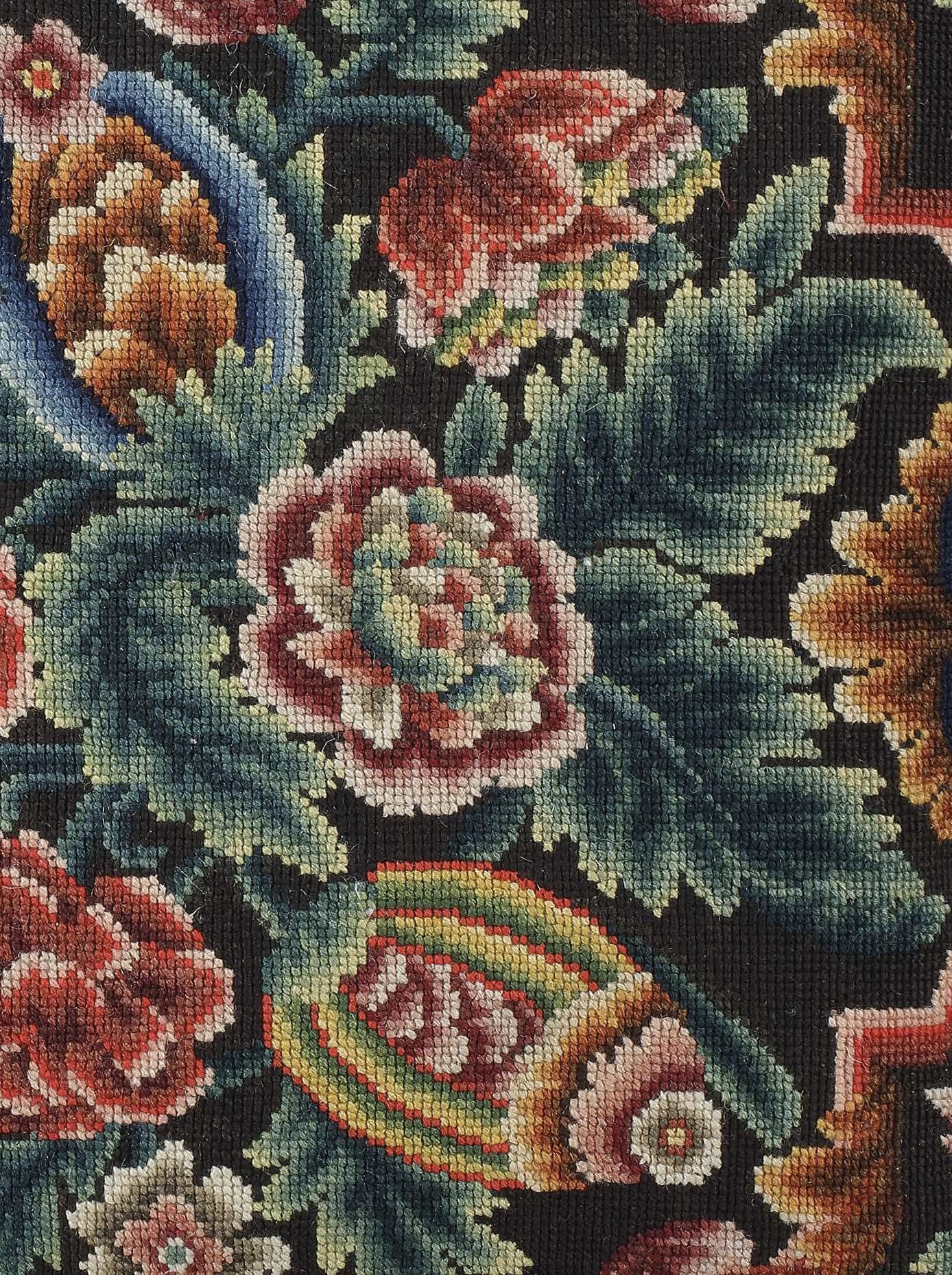

Fine Furniture





We are delighted to present our eighth printed catalogue. As always we have tried to find pieces of superlative design and craftsmanship, with great colour and patina and of course wonderful provenances.
Notable highlights include the exceptional set of carved mahogany library steps supplied by Ince & Mayhew to the 6th Earl of Coventry at Croome Court, and a rare pair of stools upholstered with outstanding needlework. We have included a fine selection of mirrors including two rare japanned examples, a magnificent Charles II giltwood mirror of massive proportions and a wonderful Kentian overmantel. Great provenances include Kimbolton Castle, Pitzhanger Manor, Hornby Castle, Croome Court and the Tuileries, together with a roll-call of attributions from leading cabinet-makers of the period including the Roberts family, Thomas Chippendale, Matthew Darly, Ince & Mayhew and John McLean.
Please do let us know if you find something of interest in this catalogue. Please do come and visit us in St. James’s if you happen to be in the area.
Charlie Mackinnon Mackinnon Fine FurnitureLeft:
A George III Chippendale period mahogany side chair.
Cover:

A George III ormolu mounted commode, pp.76-77.
Inside Covers:
Detail of early 18th century needlework, pp. 4-5.
England, circa 1710
A pair of Queen Anne period walnut stools, of rectangular form, the upholstered seats supported by elegant cabriole legs that end in pad feet, and joined by a shaped stretcher. The walnut with fine colour and patination throughout. The seats now upholstered in exceptional early 18th century French floral needlepoint which retains the most magnificent colours.
Height: 17½ in (44.5 cm)
Width: 22½ in (57 cm)
Depth: 16½ in (42 cm)
The collection of Sam Eckman, Jnr., Esq., C.B.E.
Sotheby’s London, Important English Furniture, Clocks, Rugs, Tapestries and Chandeliers - the Collection of S. Eckman Jnr., Esq., C.B.E., Friday 6th October 1967, lot 123
Acquired by Hotspur, at the above sale, 6th October 1967
Private Collection
The Grosvenor House Antiques Fair Handbook, 1937, p. 51, exhibited by Hotspur
Country Life, 21 September 1967, p. 706, advertised by Sotheby’s
The outstanding needlework on these stools relates very closely to that on a French carpet, illustrated in L. Synge, Mallett Millennium, 1999, p. 229, pl. 293.


England, circa 1720
A George I gilt gesso mirror, with a fine bevelled double arched plate. The cresting centred by a winged cherub with sunflower halo and flanked by three dimensional scrolls. The gilt gesso decoration with fine punchwork and carved scrolling foliage.
Height: 35 in (99 cm)
Width: 17¼ in (44 cm)
A very closely related mirror was illustrated in Connoisseur, March 1932, p. 184, as part of the Warner collection, and subsequently sold at Sotheby’s London and advertised in The Burlington Magazine, October 1970, p. xvii. A further set of three of virtually identical size were in the Percival Griffiths collection, illustrated in R. W. Symonds, Masterpieces of English Furniture and Clocks, London 1940, pp. 59-60, figs. 38-39, one of which was sold Christie’s London, 6 July 1995, lot 59. Percival Griffiths was of the first generation of collectors and he formed an outstanding collection of English furniture of this period.
An almost identical cherub’s mask can be seen on a George I japanned corner cabinet circa 1725 and possibly by John Belchier, which was sold from the celebrated Horlick collection, Sotheby’s London, 5 June 2007, lot 28. Belchier (d. 1753) is first recorded in 1717 as a cabinet-maker at ‘The Sun’ on the south side of St. Paul’s Churchyard. One of his most important commissions was for John Mellor at Erdigg, Wrexham that included pier mirrors and tables and a superb japanned cabinet. His bureau-cabinets are frequently labelled, allowing for firm attributions of his work to be made.

England, circa 1740
A George II period walnut chest on chest. The upper section with a bold concave moulded cornice over an unusual arrangement of a row of three short drawers over three long graduated drawers. The lower section with a further three long graduated drawers, standing on shaped bracket feet. Retaining the original brasswork throughout.
The walnut with superb colour and patination.
Height: 74¼ in (189 cm)
Width: 46 in (117 cm)
Depth: 21¾ in (55.5 cm)

China, 19th century
A pair of mid 19th century Chinese Export black lacquer games tables. Of rectilinear form, the tables exquisitely decorated throughout with gilt highlights on a black lacquer background. The fold over tops are supported on brackets and reveal playing surfaces, counter wells and candlestands. The central panel lifts out to reveal on the other side a chessboard, below which is backgammon board. With frieze drawers and standing on square tapering legs, similarly decorated.

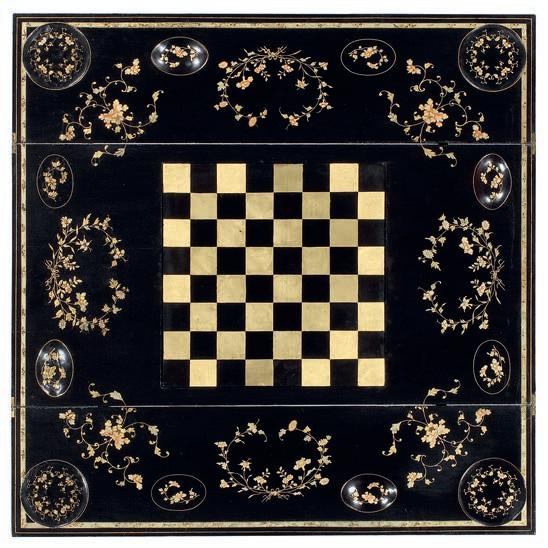
A rare pair of tables.
Height: 29¾ in (76 cm)
Width: 38¾ in (98 cm)
Depth closed: 19¼ in (49 cm)
Interestingly these games tables were apparently shipped to Europe in parts, to be assembled on arrival. The leg joints are labelled with Chinese characters - presumably instructions for final construction. Shipping from the Far East was of course expensive, so to ship deconstructed would have saved cargo space and been more cost effective - it also prevented the delicate legs being damaged in transit.
Literature David S. Howard, A Tale of Three Cities / Canton, Shanghai & Hong Kong – Three Centuries of Sino-British Trade in the Decorative Arts, Sotheby’s 1997
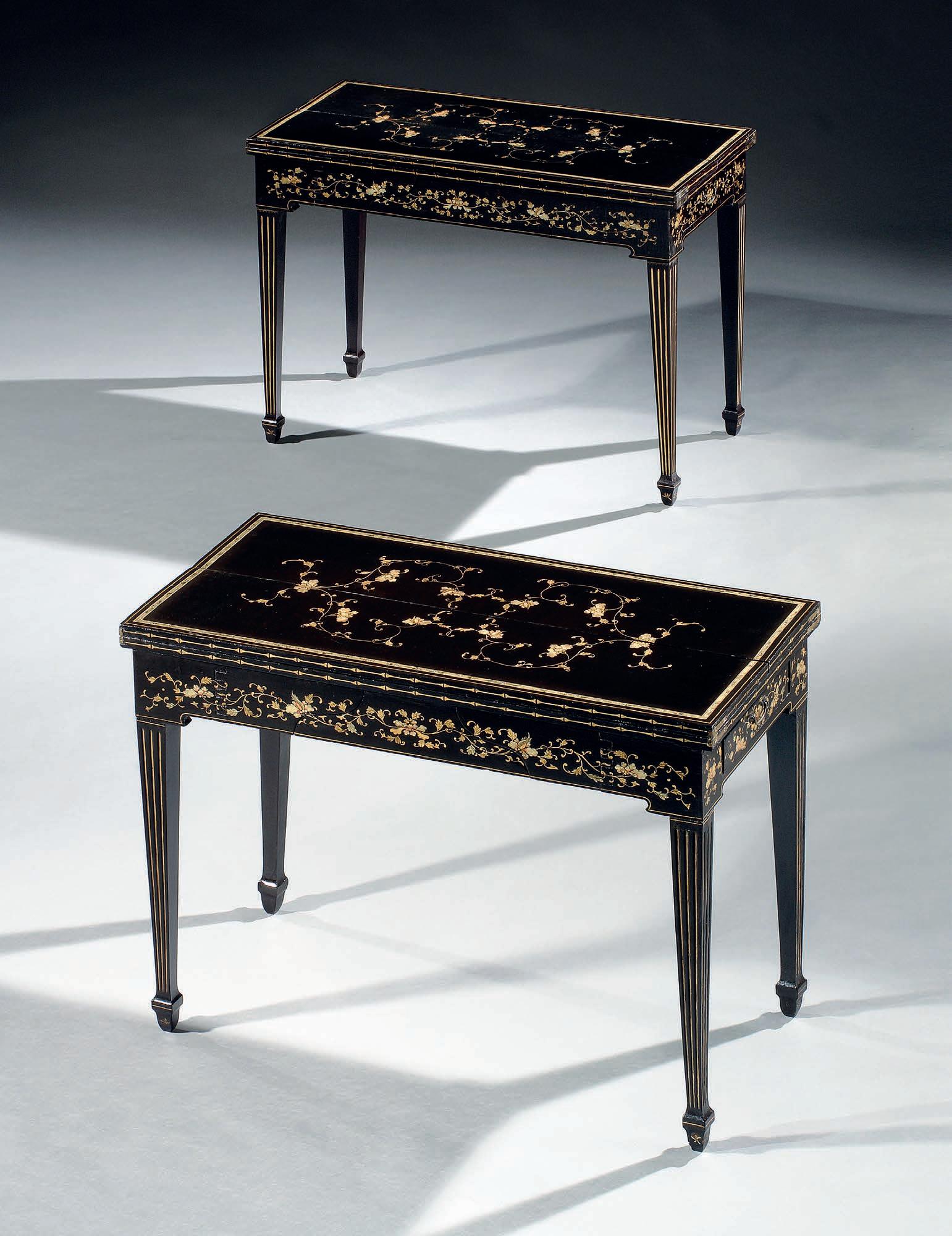
Probably by James Moore England, circa 1710
A George I gilt gesso side chair, probably made by James Moore, the seat and back upholstered in antique yellow floral damask silk, the front cabriole legs joined by scrolling open bracket supports, the rear legs elegantly outswept, the legs and seat frame all decorated with acanthus carved gilt gesso detailing.
Height: 39½ in (100 cm)
Width: 23¼ in (59 cm) Depth: 25¾ in (65 cm)
Presumably the Donaldson Collection, And then the collection of the Duchess of Roxburghe, Carlton House Terrace
The collection of the Hon. Mrs. Nellie Ionides, Buxted Park With Hotspur Ltd., Belgravia Private Collection, USA
N. Goodison and R. Kern, Hotspur - Eighty Years of Antique Dealing, p. 128-129, p. 129, fig. 3
Country Life, The Duchess of Roxburghe’s Collection of FurnitureI, 25 April 1931, p. 531
Country Life, Buxted Park, Sussex – II: The Home of Mr. and the Hon. Mrs. Basil Ionides, 11 August 1950, p. 445, pl. 8
This exceptional chair was probably made by James Moore the elder (1670 - 1725) whose premises were ‘against the Golden Bottle’ in Shorts Gardens, St. Giles-in-the-Fields London and who became cabinet-maker to George I and the Prince of Wales, later George II. He served leading members of the British aristocracy including the Duke of Chandos and the Duke and Duchess of Marlborough, who appointed him Comptroller of Works at Blenheim in 1716 as successor to Sir John Vanbrugh. Moore was renowned for his giltwood furniture and in some instances his pieces were incised MOORE though much of his work can at best be attributed to him. He was particularly influenced by contemporary designs from France disseminated through works such as Daniel Marot’s Nouveau Livre d’Orfeverie, 1703, and by the designs of Jean, René and Thomas Pelletier, and William Kent.
Although highly idiosyncratic in style with its ‘flying brackets’, there are comparables: the overall design of this chair relates closely to the celebrated pair of walnut stools sold from the collection of Sir John Gooch at Sotheby’s London, Benacre Hall, 9 - 11 May 2000 and subsequently Christie’s New York, The Rockefeller Collection, 9 May 2018.
A related suite of giltwood furniture from Browsholme Hall, Lancashire, possibly by James Moore, was sold Christie’s London, The Exceptional Sale, 7 July 2011, lot 23. Comparable walnut seat furniture was photographed in situ at Denham Place, Middlesex, circa 1905 - later part of the Leverhulme Collection, the settee was subsequently sold Christie’s London, Important English Furniture, 22 January 2009, lot 100.

England, circa 1695 – 1705
A highly important pair of William and Mary armchairs from the collections of the Dukes of Manchester, Kimbolton Castle.
Of ebonized beech with square upholstered seats and backs joined by curved, flared arms ending in spiral scrolls and set on pierced “corner horsebone,” or S-shaped, supports, ending in bold scroll feet. The front legs are joined by a pierced front stretcher formed by conjoined S- and C-scrolls. The raked backs overhang the square-section back legs, which are joined to the front legs by turned H-frame stretchers and to each other by a higher, turned, back stretcher. The 18th century crimson velvet covers are trimmed with red fringe around the top and sides of the backs and with longer scalloped trim on the front and sides. One front stretcher is impressed with an indistinct maker’s mark, possibly SC.
Height: 49½ in (126 cm)
Width: 28¼ in (72 cm)
Depth: 33¼ in (84 cm)
Presumably supplied to Charles Montagu, 4th Earl and 1st Duke of Manchester (1662–1722), Kimbolton Castle, Huntingtonshire Sotheby’s, London, sold by the 11th Duke of Manchester, 18 May 1973, lot 37 Spink & Son, Ltd., London (bearing the original label of 1973) Private Collection USA
Country Life, Country Homes–Gardens Old & New: Kimbolton Castle –I. Huntingtonshire, A Seat of the Duke of Manchester, 23 September 1911, vol. XXX, no. 768, colour plate p. 449 and figure illustration of The White Hall p. 444
Country Life, Country Homes–Gardens Old & New: Kimbolton Castle –II. Huntingtonshire, A Seat of the Duke of Manchester, 30 September 1911, vol. XXX, no. 769, p. 479
L. Wood, The Upholstered Furniture in the Lady Lever Art Gallery, 2009, vol. 1, no. 5 and fig, 120
A. Bowett, English Furniture 1660–1714 from Charles II to Queen Anne, 2002, p. 240, pl. 8:20
Y. Hackenbroch, English Furniture with Some Furniture of Other Countries in the Irwin Untermyer Collection, 1958, pl. 45
A. Bowett, “The English ‘horsebone’ chair, 1685–1710,” Burlington Magazine, CXLI, May 1999: pp. 263–70 G. Beard, Upholsterers and Interior Furnishing in England 1530–1840, 1997

These magnificent armchairs come from Kimbolton Castle, the estate of the Earls (later Dukes) of Manchester from 1650 to 1950. The dating of the chairs places them in the first decade of the Great Rebuilding of the castle undertaken by Charles Montagu, 4th Earl and 1st Duke of Manchester. Spink & Son, London, purchased the two chairs in a 1973 Sotheby’s auction of property owned by the then Duke of Manchester. A label identifies the chairs as “from a set of State furniture at Kimbolton Castle”.
Two chairs from the Kimbolton suite appear in an illustration of The White Hall of the castle in a 1911 issue of Country Life

Two other chairs from the suite are illustrated in King William’s Bedroom in the succeeding issue of Country Life. No chairs of this model appear in the catalogue of the auction of property from Kimbolton Castle conducted by Knight, Frank & Rutley, 18–21 July 1949, suggesting that the suite was retained in the ducal family until the Sotheby’s sale of 1973.
The present chairs relate closely to a suite of chairs of the same period, now dispersed, from Rushbrooke Hall, Suffolk, seat of the Jermyn family. Eight of the Rushbrooke chairs were bequeathed in 1925 to the Lady Lever Art Gallery, Port Sunlight, near Liverpool, by the 1st Viscount Leverhulme and are now on loan to Hampton Court Palace. Two other chairs from the suite originally at Rushbrooke Hall are in the Treasurer’s House, York.
A single Rushbrooke chair was gifted by Judge Irwin Untermyer to the Metropolitan Museum of Art, New York. The Kimbolton chairs have constructional features similar enough to those from Rushbrooke Hall to surmise that they were produced in the same workshop.
The design of the Kimbolton chairs points to a date around 1700. Reference to a “horsebone” chair first appears in 1686 invoices from Thomas Roberts (1685–1714), chairmaker to the Royal household. “Horsebone” is the expression Roberts used to describe a broken scroll-formed leg. The variant “corner horsebone” design that the present chairs display is first listed in invoices from Roberts of the early 1690s. Adam Bowett cites “2 Elbow Chaires of Wallnuttree Carved horsebone on the corners” that appear in a bill Roberts submitted in 1693. Thereafter, “corner horsebone feet” and elbows are regularly recorded. “To turn on the corner” is another phrase found in 1696 invoices that apparently describes other “Elbow Chaires” with “corner horsebone feet”. Flared feet and bold, scrolling arm terminals make their appearance at the same time. Another example of “corner horsebone” chairs is the celebrated 1701 set of armchairs in beechwood, six of which survive together with a state bed at Drayton House, Northamptonshire.
Adam Bowett points out that the term “horsebone” disappears entirely from Thomas Roberts’s invoices after 1704, implying that the taste for this form had changed by the accession of Queen Anne in 1702.

In the manner of Coxed & Woster
Probably German, circa 1730
An early 18th century stained field maple, walnut, and gilt-brass mounted and pewter-inlaid bureau bookcase cabinet. In three parts, the upper section with a pair of panelled arched doors opening to reveal shelves and drawers above a fall front with bookrest opening to a velvet-lined writing surface, a secret well and a central prospect section with four secret drawers and flanked by valanced pigeonholes and drawers, all over two short drawers, the bottom section with two short over two long drawers, raised on bun feet.
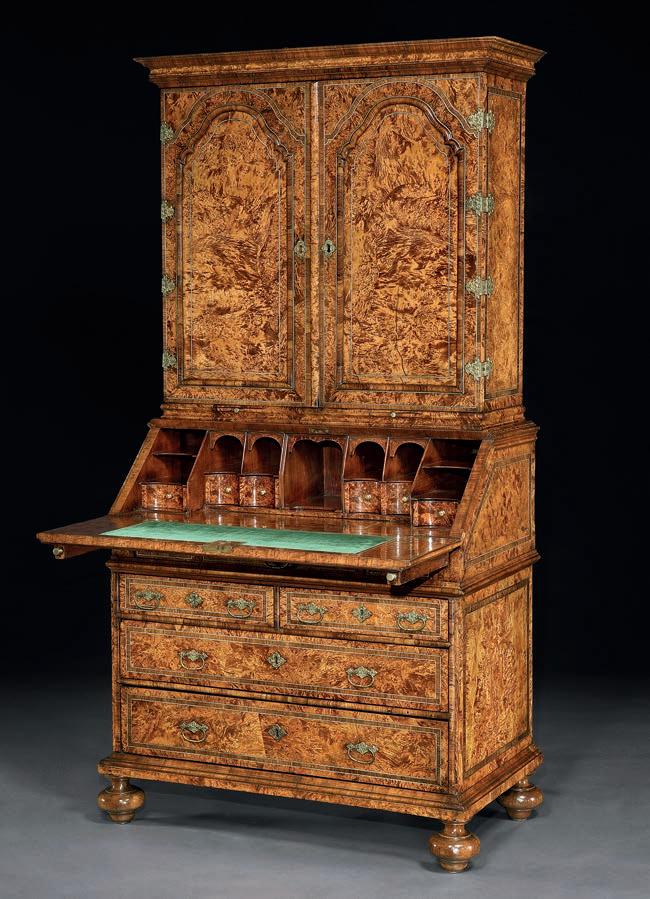
Height: 77 in (196 cm)
Width: 41 in (104 cm)
Depth: 22¼ in (56.5 cm)
Field maple veneer was employed in England at the start of the 18th century, notably by the firm of Coxed & Woster, trading from the White Swan, St. Paul’s Churchyard from around 1710 until Thomas Woster’s death in 1736. The veneer was stained in imitation of tortoiseshell and enhanced with pewter lines and their furniture frequently bore their trade label (C. Gilbert, The Pictorial Dictionary of Marked London Furniture, Leeds, 1996, pp. 23-24, and pp. 154-155, figs. 236-240).
This bureau cabinet, while stylistically very similar to pieces by Coxed & Woster, differs in having arched panels to the upper doors rather than mirrors as seems to be usual in their recorded work. Additionally, it employs much deal in its carcase and drawer linings and the locks are of European-type suggesting continental, probably German, manufacture.
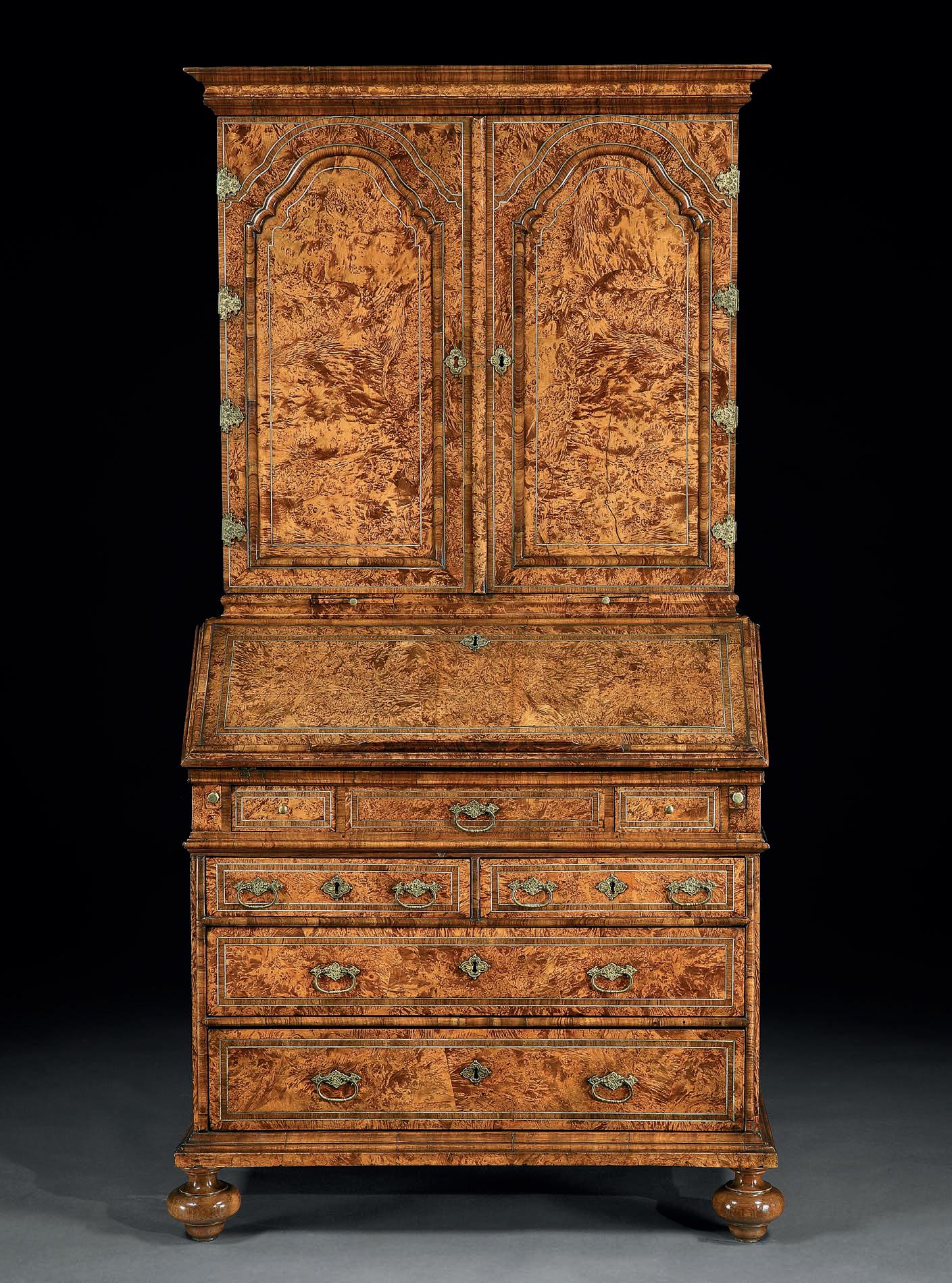
China, circa 1820
A rare set of four early 19th century Chinese export gouaches of daily household activities, beautifully detailed throughout and with superb colours, finely mounted and framed.
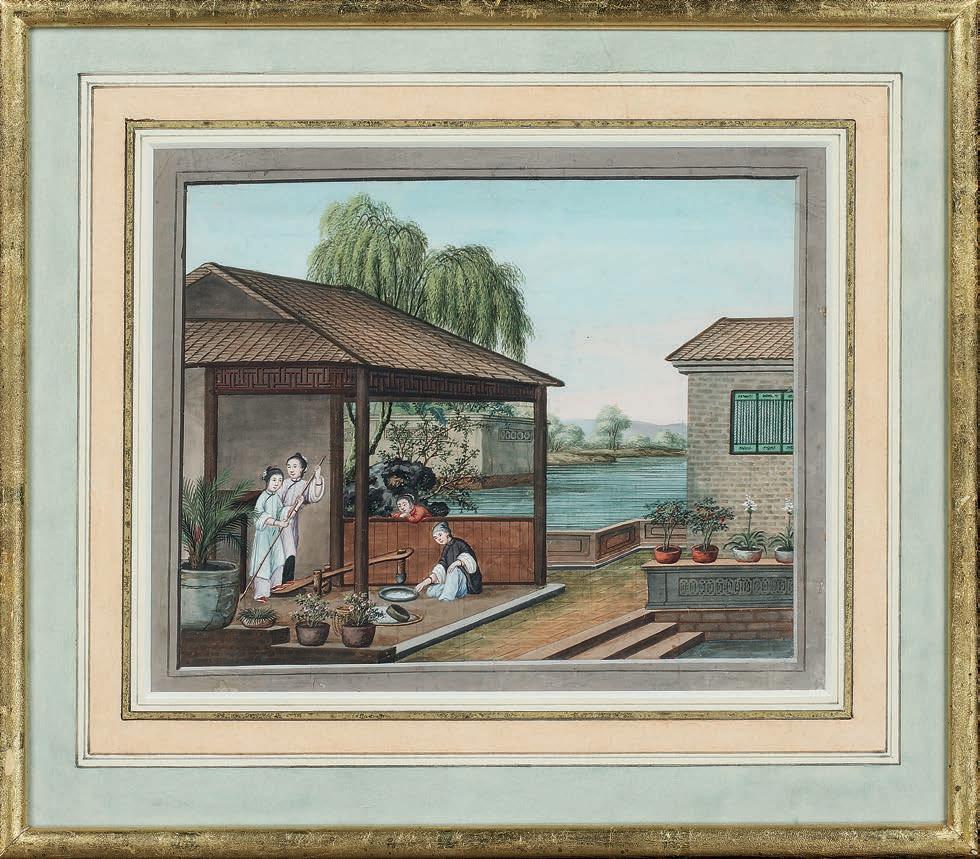
Image size: 7x 9¼ in (18 x 23.5 cm)
Framed size: 13¼ x 15 in (34 x 38 cm)
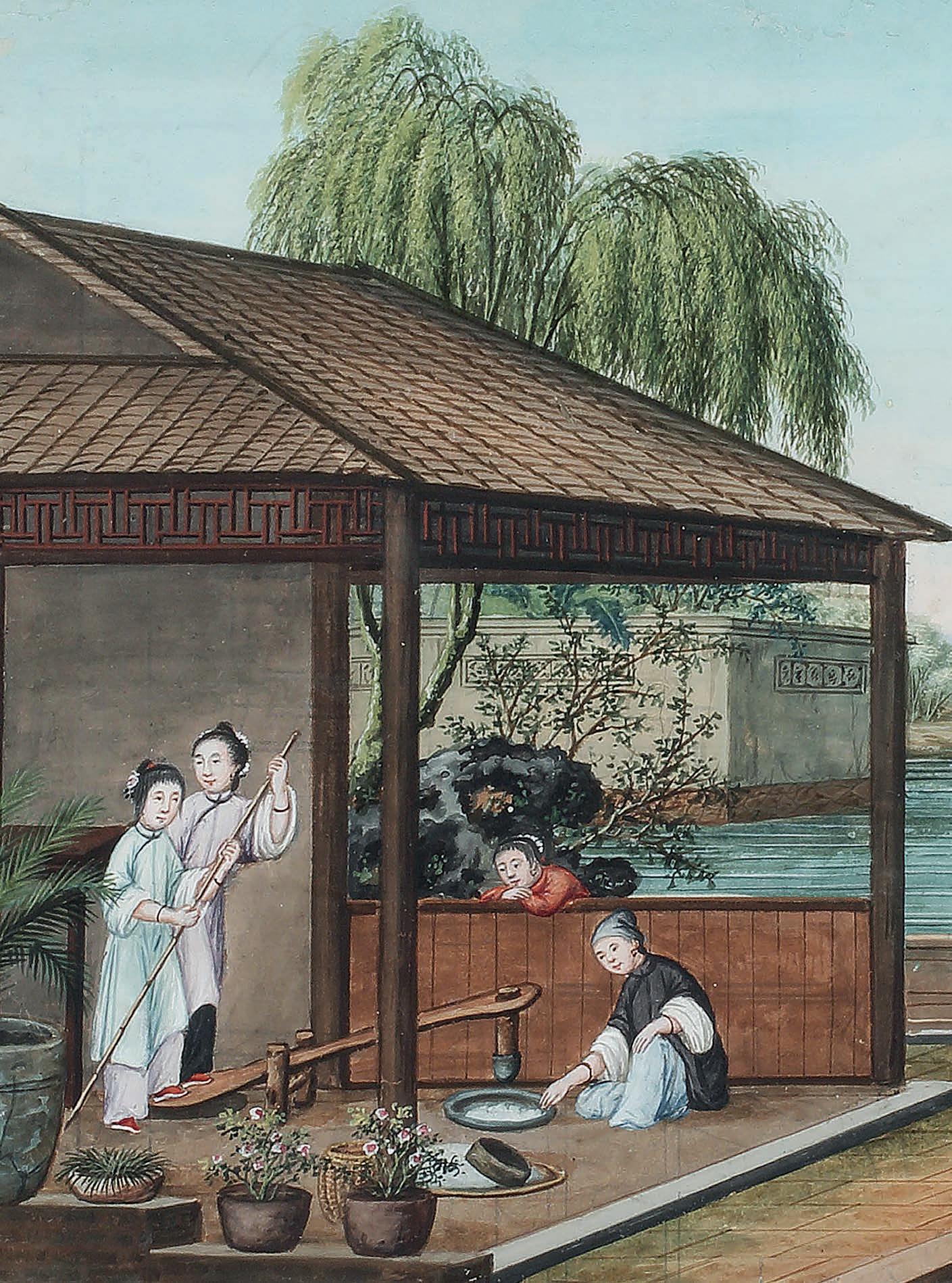
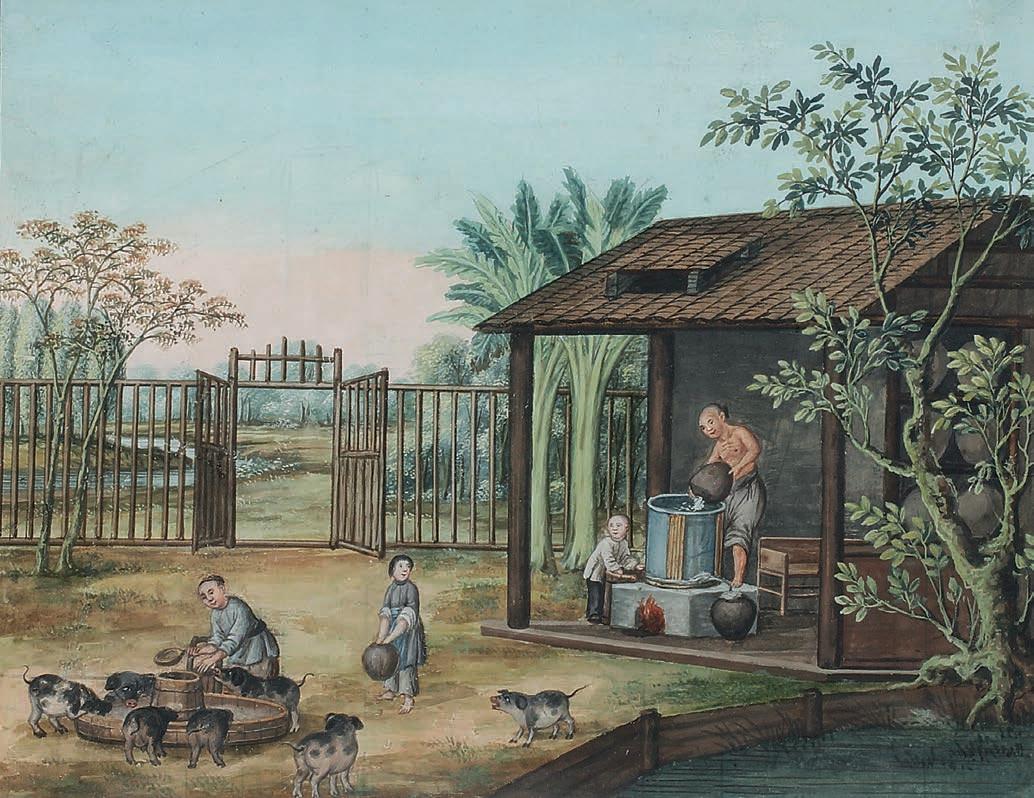

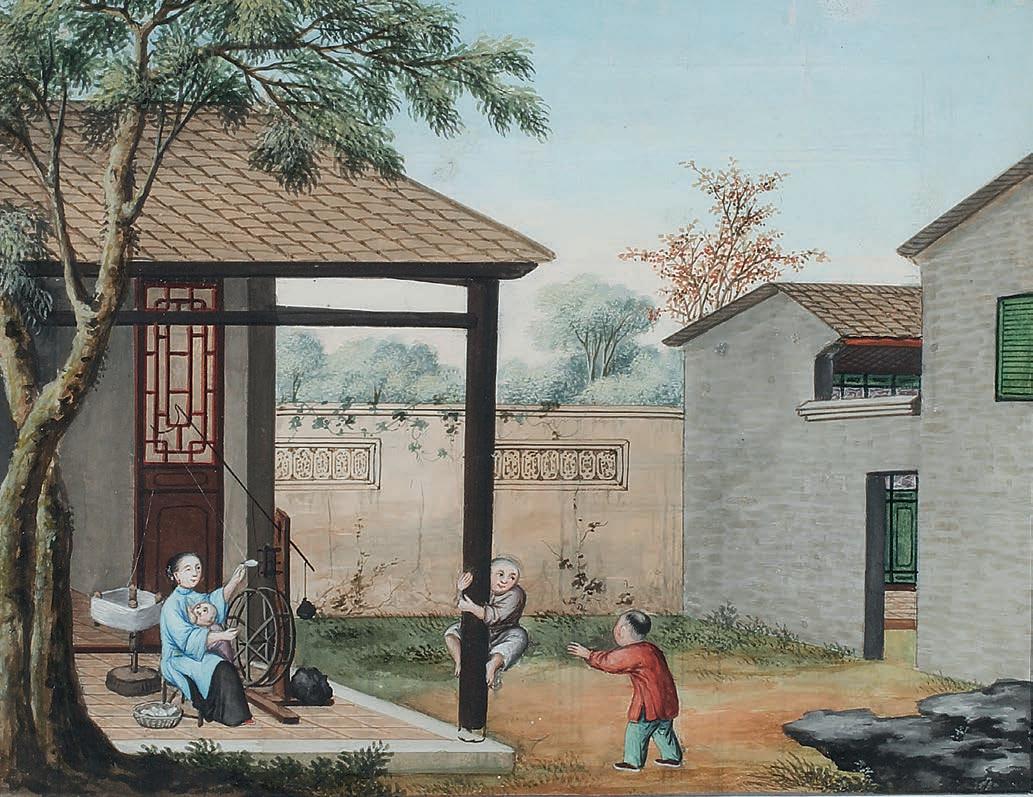

In the manner of Ince & Mayhew England, circa 1775
A pair of George III giltwood open Adam period neo-classical armchairs probably by Ince & Mayhew. The medallion-shaped back centred by flowerheads, with foliate husk carving throughout, the outswept arms with scroll terminals and scrolled supports, on elegant fluted tapering legs. Each with upholstered seat, back and arm rests. With batten carrying-holes and cramp cuts to the undersides, and exposed gilded back struts to the rear.

Of particularly fine quality.
Height: 38¾ in (98 cm)
Width: 24¾ in (62.5 cm)
Depth: 23 in (58.5 cm)
A pair of these armchairs was advertised by Norman Adams in Connoisseur in November 1964. A pair was sold Christie’s London, Highly Important English Furniture, 28 June 1984, lot 65.
A single example is illustrated in L. Synge, Chairs in Colour, pl. 44. It is of course possible that these are all the same chairs.
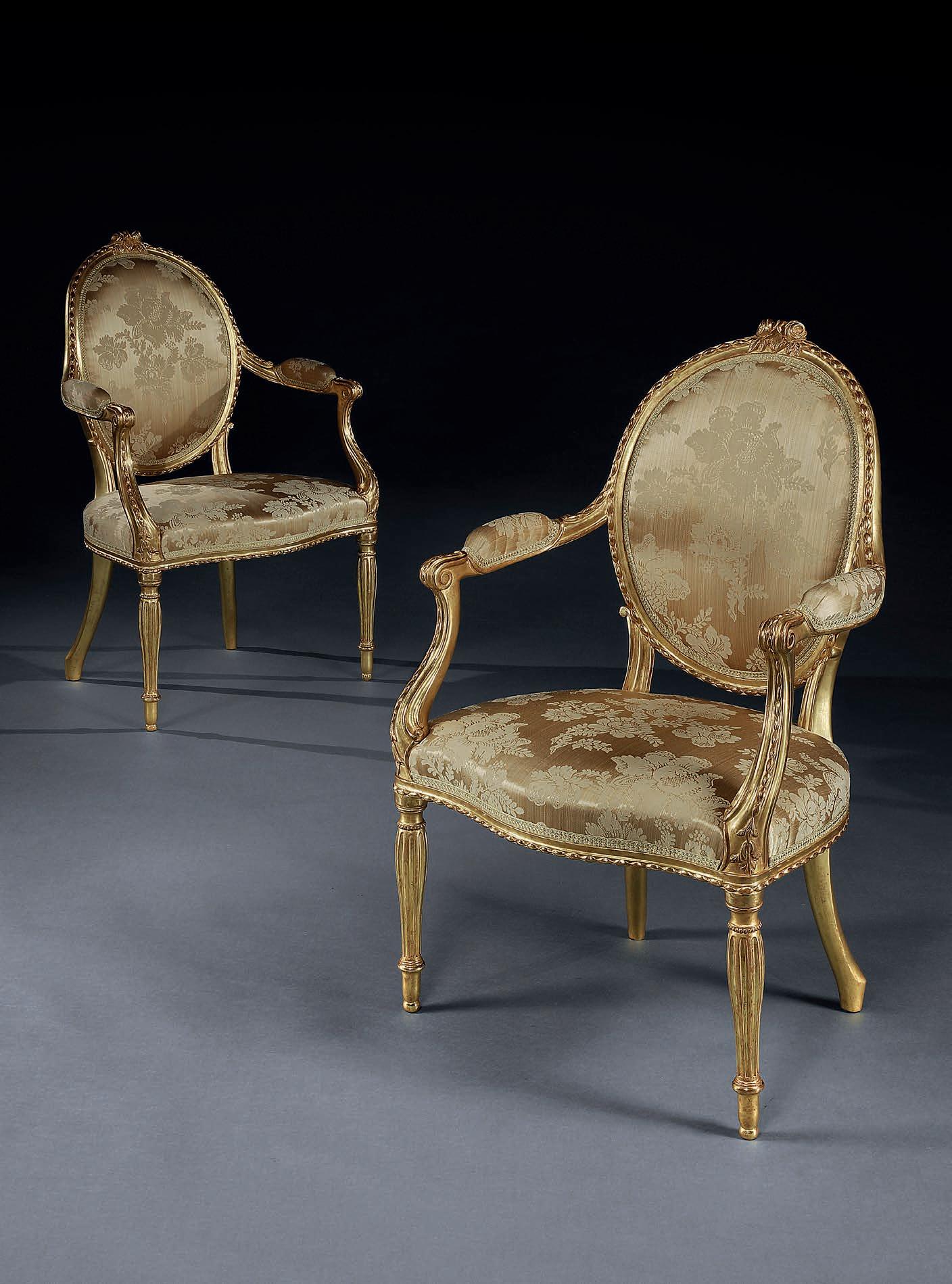
England, circa 1690
A William III carved silvered and japanned pier mirror, the divided plates bevelled, the upper arched and engraved with stylised stars and a scalloped edge, the conforming frame with an inner silvered gadrooned border, the moulded black and gold japanned cushion border with raised chinoiserie decoration with figures, birds, flowers and pavilions, all within a silvered foliate and strapwork carved outer edge.
An exceptionally rare mirror.
Height: 52¼ in (133 cm) Width: 24¾ in (63 cm)
Provenance:
Christie’s New York, Important English Furniture, Clocks & Objects, The Property of a Lady of Title, 9 October 1993, lot 358
Sotheby’s New York, Tom Devenish: The Collection – Highly Important English Furniture, 24 April 2008, lot 14 With Godson & Coles, London Private Collection, UK
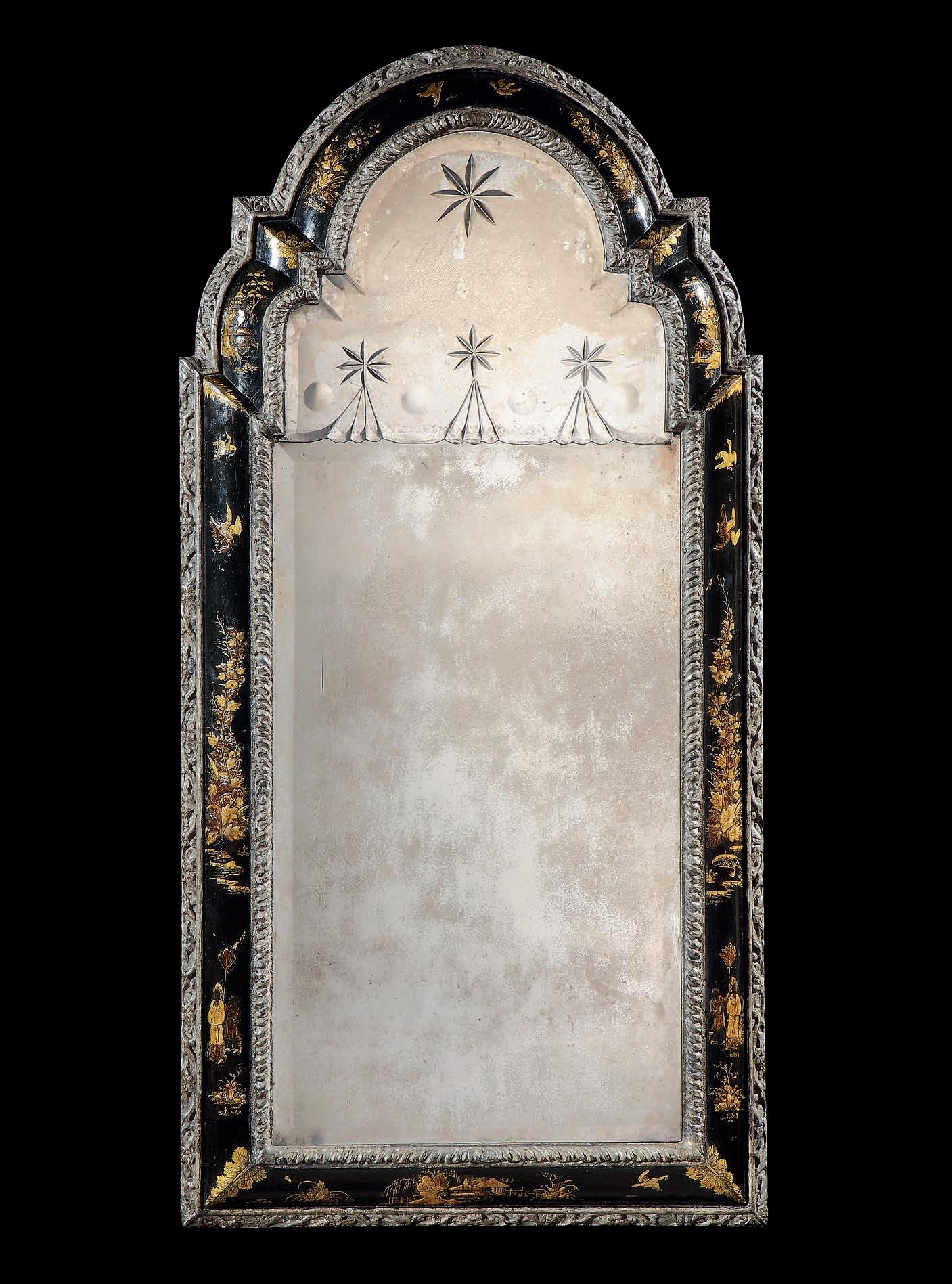
Probably by Thomas Chippendale England, circa 1770
A mid 18th century George III period mahogany dressing chest probably by Thomas Chippendale. The serpentine shaped top over four graduated drawers, the top drawer fitted with compartments and divisions, each drawer with its original handles. The canted corners with delicate trace fret carving. With serpentine sides, and raised on bold bracket feet. With red wash to the rear and underside and laminated block feet.
Of fine colour throughout. Excellent serpentine shape to the sides and front.
Height: 33¼ in (84 cm)
Width: 41 in (104 cm)
Depth: 24¾ in (63 cm)
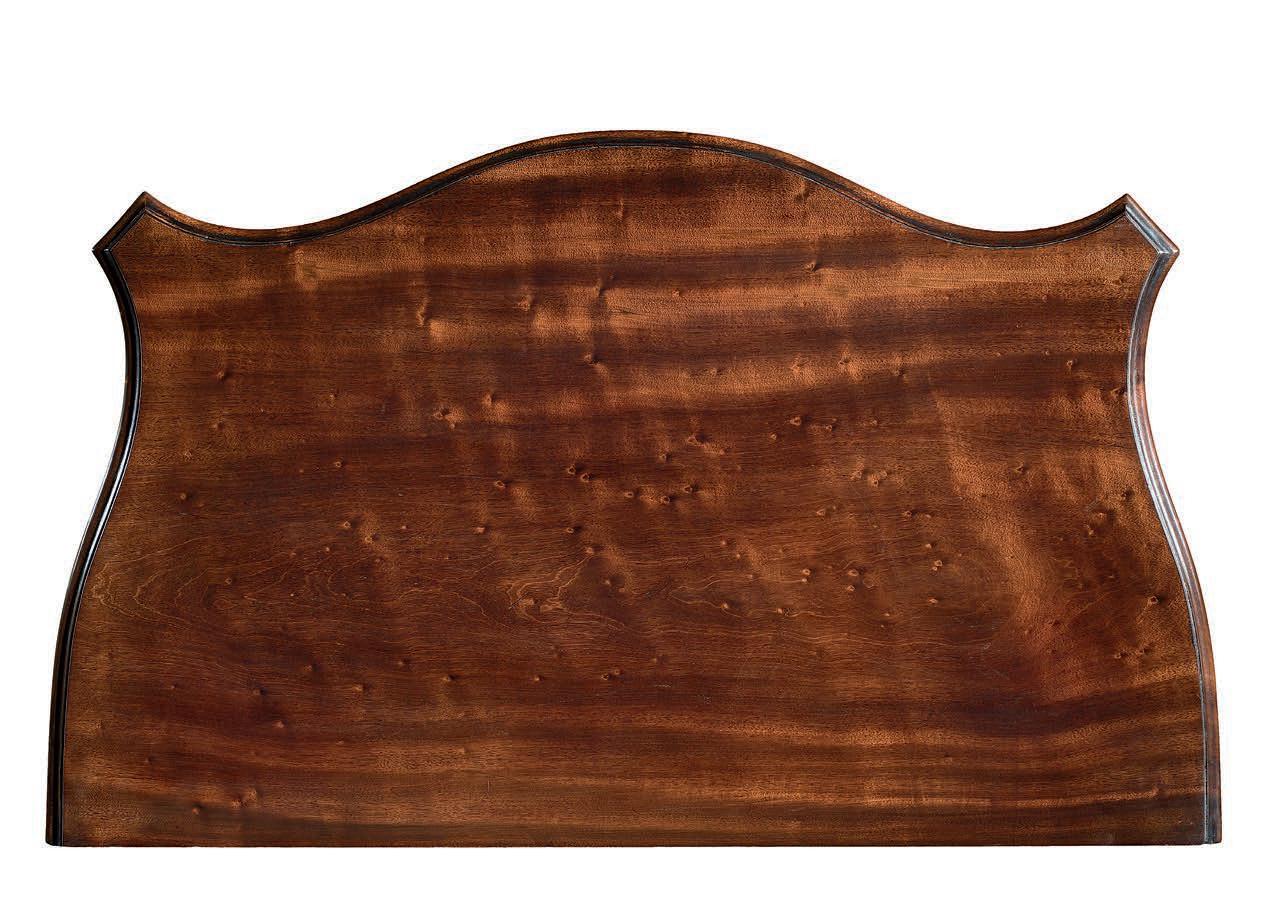

A highly important set of George III carved mahogany metamorphic library steps supplied to the 6th Earl of Coventry for Croome Court, Worcestershire by Ince & Mayhew and delivered in 1788.
Height when closed: 24 in (61 cm)
Height when open: 54¾ in (139 cm)
Height when banister fully extended: 84½ in (215 cm)
Width: 40½ in (103 cm)
Depth: 22 in (56 cm)
The surviving invoice from Ince & Mayhew describes:
‘
A mahogany library step stool the top stufft with best curl hair in [ ] covered with ….Spanish leather ..., a folding step ladder within, with back foot to support the top & a separate banister to fix in top step, made particularly strong, with hinges, brass spring ketch, & c” Complete £4 4s’.
Provenance
Supplied by Ince & Mayhew to George William, 6th Earl of Coventry for Croome Court, June 1788 Sold by Bentley, Hobbs & Mytton at Croome Court, 7 – 10 December 1948, day three, lot 844 Sotheby’s London, 26 June 1959, lot 177 Private Collection, UK and thence by descent
To be included and illustrated in the first detailed survey of the work of Ince and Mayhew, Industry and Ingenuity: the Partnership of William Ince and John Mayhew by Hugh Roberts and Charles Cator, to be published by Philip Wilson (November 2022).
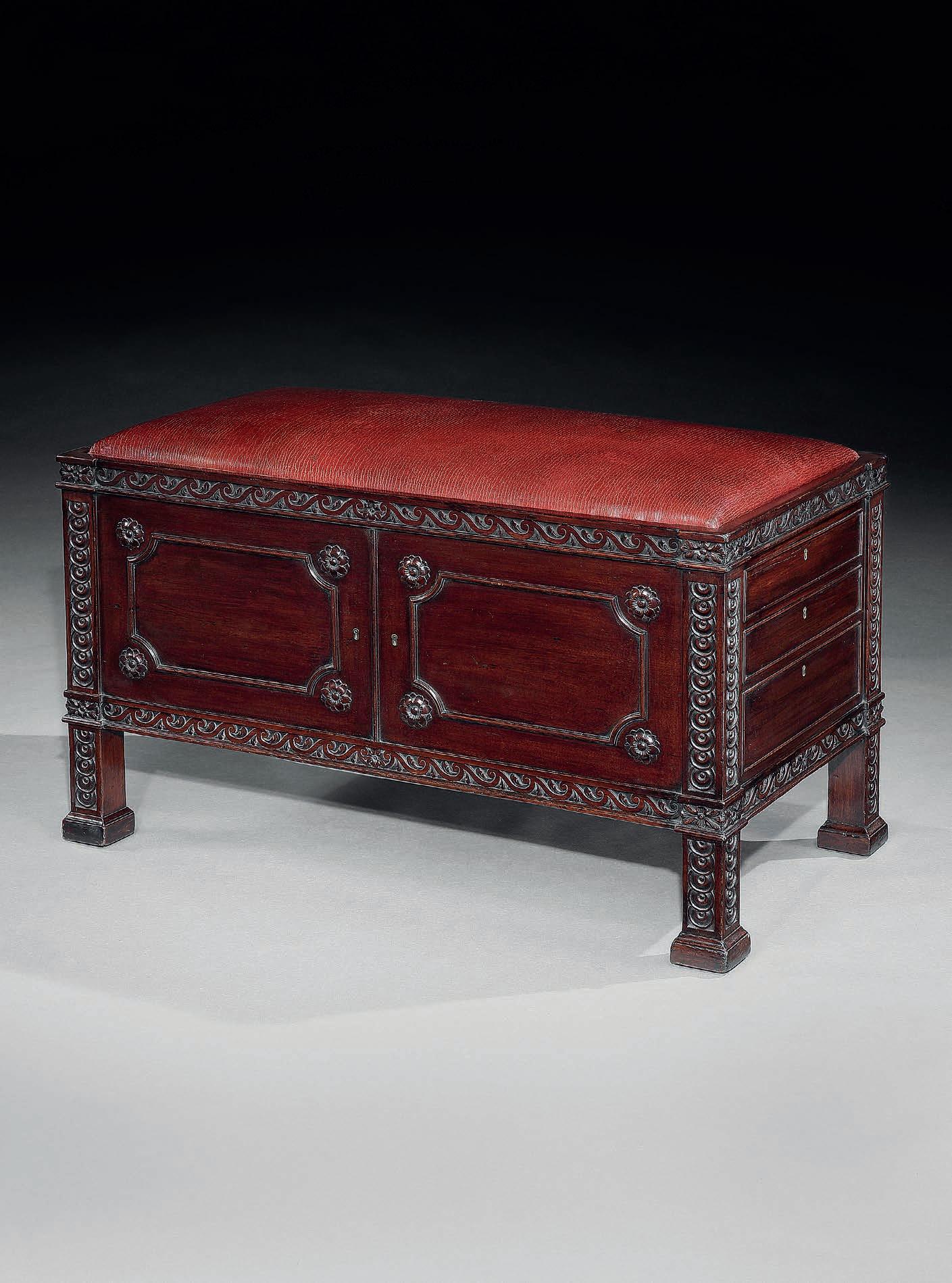
Croome Court, in Worcestershire, was built by George William, 6th Earl of Coventry between 1751 and 1752. He had recently inherited the estate and employed Lancelot “Capability” Brown (1716 – 1783) to improve both the grounds and the house. Brown demolished all of the existing old Jacobean house, with the exception of the chimneys, and built an impressive new Palladian style mansion in replacement. In 1760, Coventry engaged Robert Adam (1728 – 1792) to design several of the principal rooms in his increasingly popular neo-classical taste. Adam’s gallery, library and tapestry room at Croome were widely admired by contemporaries. The tapestry room can now be viewed at the Metropolitan Museum of Art in New York complete with its original Gobelins tapestries, ceiling, door surrounds, mahogany doors, chimney-piece and seat furniture.
In collaboration with Robert Adam, Coventry employed some of the leading cabinet-makers of the day including Ince and Mayhew, firstly at Coventry House, Piccadilly and subsequently at Croome. The suite of giltwood seat furniture for the tapestry room, including six armchairs and a pair of settees, was supplied by their firm.
The library at Croome Court was one of the impressive rooms designed by Robert Adam. In June 1763, Adam supplied detailed drawings for the bookcases which were to form the principal feature of the room and were made by Royal cabinet-makers William Vile (c. 1700 – 1767) and John Cobb (c. 1715 – 1778) at a cost of £260. The finer aspects of the carving were carried out by Sefferin Alken. As was typical of the period the designs for the bookcases reflected the architectural schemes of the house; the Ionic pilasters reflecting the frame of the library’s Venetian window, and the honeysuckle motif reflected Adam’s design on the plaster ceiling. In the 18th century, books were increasingly seen as status symbols, reflecting not just the wealth but also the knowledge and interests of the owner of the house and it was important for them to be housed and displayed accordingly. The Croome Court library bookcases were acquired by the Victoria & Albert Museum in 1975 – a section is now being loaned back to Croome Court for display.
The majority of the contents of Croome Court, along with the house itself, were sold in 1948. In 2007, after suffering years of neglect, Croome Court was bought by the Croome Heritage Trust – taking on the property in partnership with the National Trust.

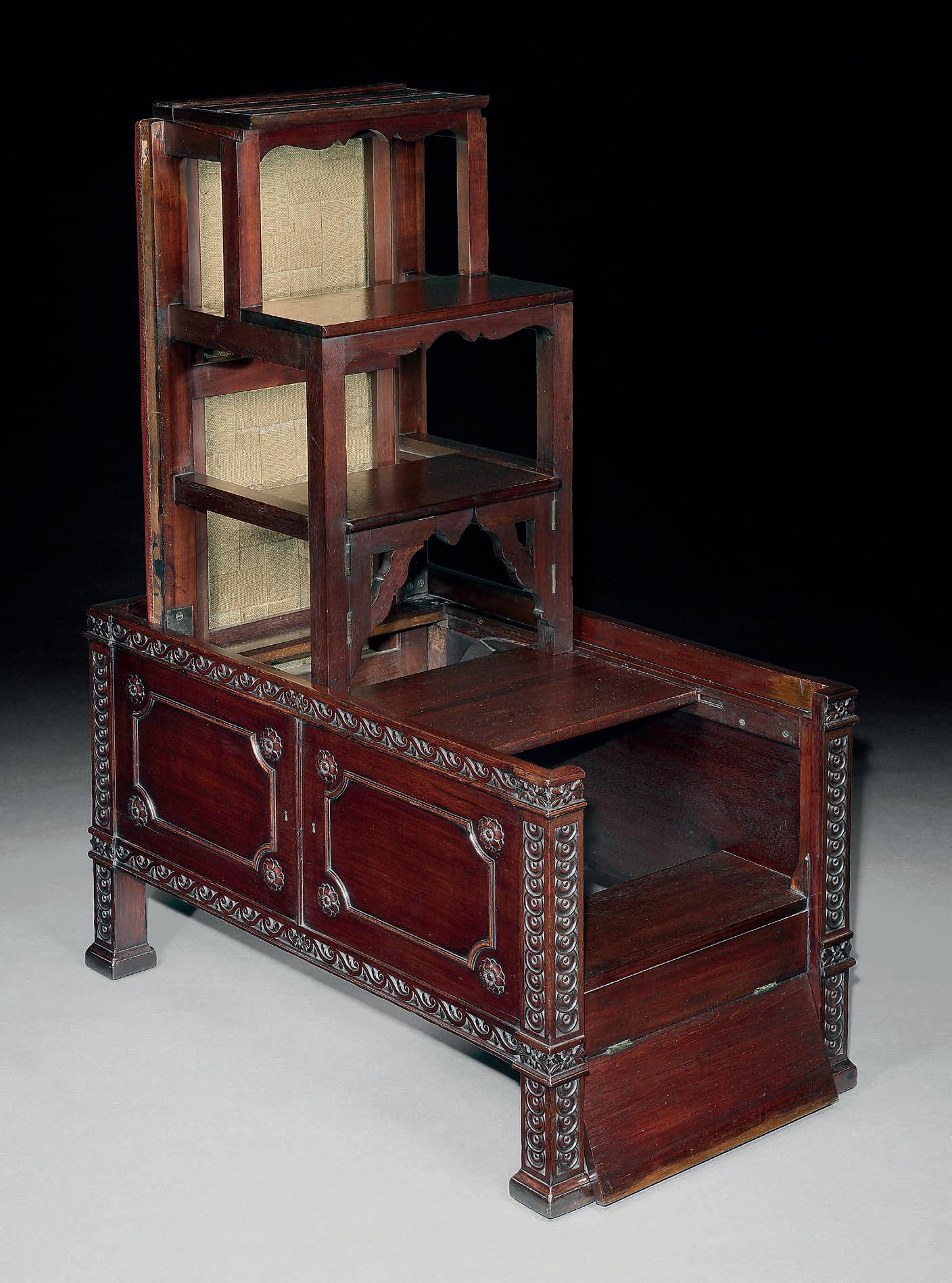

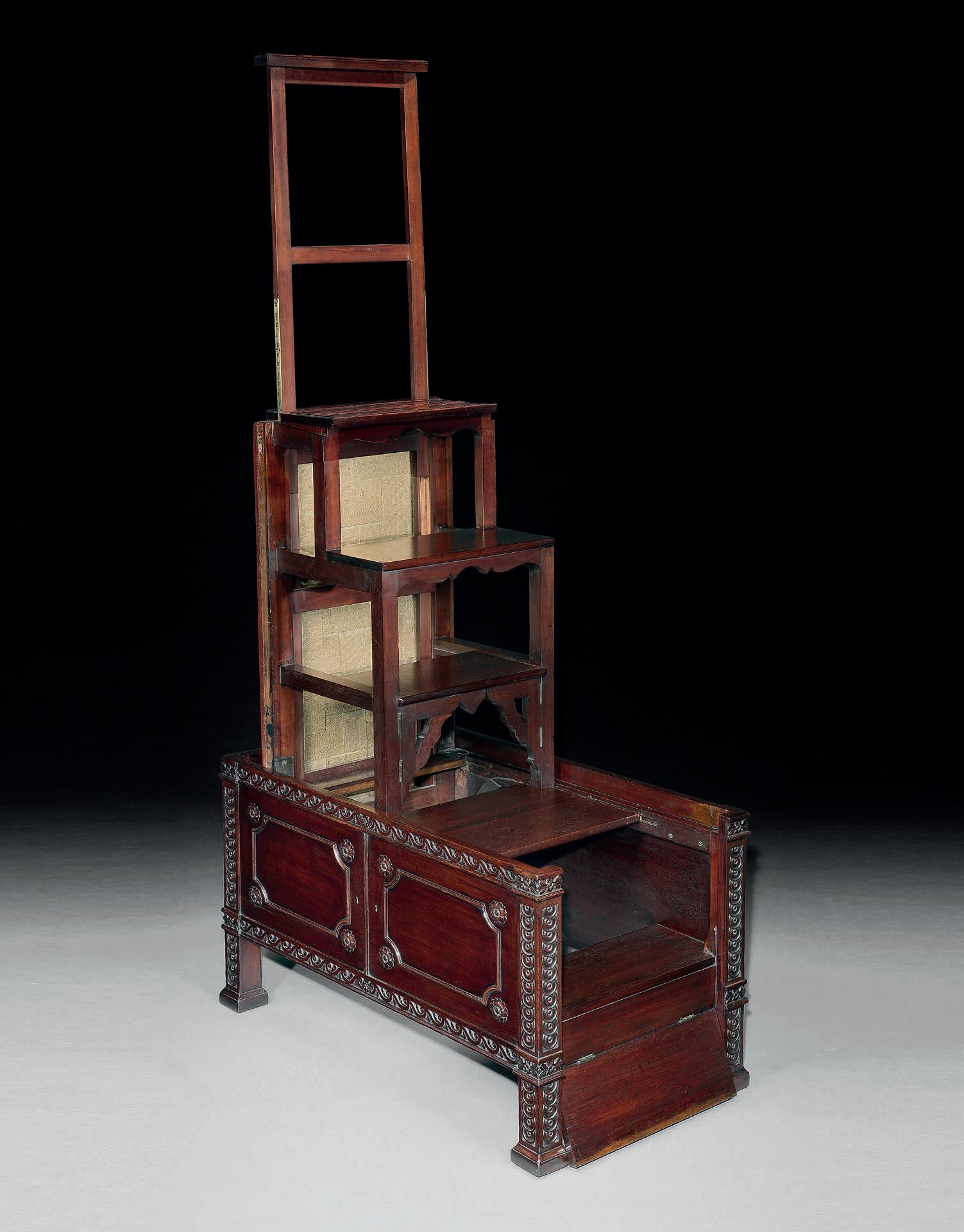
From the 1750s, mirrors with Chinese painted scenes, the earlier examples often centring on a river, became hugely sought after in Europe. Although worked in Canton, the glass itself was usually imported from Europe, often from France, by agency of the Compagnie des Indes, as any large and flat locally produced glass of the time was considered of poor quality. Generally fully silvered plates would be traced with design outlines, to indicate which areas of the mercury backing should be removed, before being painted with the exquisite colourful scenery.
An excerpt from a letter from Brother Attiret, court painter of emperor Qianlong, 1741 describes: “ For over a year I have scarcely done anything else than paint on glass. A large number of beautiful large mirrors are brought from Europe, which the mandarins of Canton buy from the merchant ships and offer to the emperor....This type of painting is all the more beautiful because, when seen from a short distance, it seems as if the figures, animals, landscape or any other design is not painted on the mirror but reflected; one’s face can be seen in the gaps left by the painting, which makes for very attractive variety. This type of painting would not find disfavour in Europe, especially if it were done in good taste”.
Right:
A Chinese mirror painting, depicting a courtly lady in traditional dress, of superb quality with fine attention to detail in the clothing, jewellery and accessories, standing on a paved terrace with a red lacquer trellis fence behind, framed in a contemporary black japanned and gilt decorated frame. China, circa 1800
Height: 23¼ in (59 cm)
Width: 19¾ in (50.5 cm)
Below:
A large 18th century Chinese reverse glass mirror painting, depicting a bucolic river landscape, the foreshore with an elegant maiden sitting on a rock with a man tending his flock of sheep, cattle and pigs, on the far bank a village landscape with pavilions and other buildings. Beautifully mounted in a giltwood frame with blue and white cracquellure slips. China, circa 1770

Height: 16¾ in (43 cm)
Width: 26¾ in (67.5 cm)

England, circa 1765
A pair of George III Chippendale period mahogany side chairs, the splat backs wonderfully drawn with interlocking C-scrolls and fine carved detail, the crest rail with carved acanthus leaf detailing and a superb carved and pierced central stylised shell, above drop-in upholstered seats raised on elegant cabriole legs carved with cabochon and leaves to the knees, and ending in bold claw and ball feet.
Height: 40¾ in (103.5 cm)
Width: 24 in (61 cm)
Depth: 22 in (56 cm)
The Grosvenor House Fair Handbook, 1994, p. 220 illustrates the matching settee, as advertised by Stair & Company
The matching sofa, ensuite with these superb chairs, was in the collection of the late Percy Macquoid (1852 - 1925), the noted antiquarian and author the seminal four volume The History of English Furniture

England, circa 1750
A George II carved mahogany stool, of rectangular form with upholstered seat, standing on four bold cabriole legs each carved with C-scrolls forming cabochons and with scrolling acanthus to the knees, the scrolled feet further carved with acanthus. The seat upholstered with mid 18th century French needlepoint.
Wonderful depth of carving and colour to the mahogany. Exceptional needlepoint.

Height: 17 in (43 cm)
Width: 22 in (56 cm)
Depth: 18¼ in (46 cm)

England, circa 1760
A mid 18th century carved Chinese Chippendale period white painted and parcel gilt mirror, the divided plates surmounted by an elaborate arched cresting centred by a chinoiserie pavilion housing a gilded fountain. The central plate flanked by border glass panels, with ho-ho birds and beautiful elaborate scrolling branches on each side, the shaped apron centred by a cartouche containing a stylised foliate spray.
Height: 74 in (188 cm) Width: 41¾ in (106 cm)
With Stair & Company, Mayfair, London, 2002
With Ronald Phillips Ltd., London Private Collection UK
Literature
Apollo, June 2001, with Stair & Company (illustrated)
The Grosvenor House Antiques Fair Handbook, 2002, with Stair & Company, p.157 (illustrated)
Ronald Phillips Ltd., Antique English Furniture, 2007, p. 19 (illustrated)

Attributed to Gillows of Lancaster & London England, circa 1800
A very fine Regency period rosewood and cross-banded sofa table attributed to Gillows of Lancaster and London. Of unusually deep proportions, the timbers retaining magnificent colours and patina. With frieze drawers, standing on splayed legs joined by a high arched stretcher, the feet with brass box castors.
Height: 28¼ in (72 cm)
Width with flaps up: 61¼ in (156 cm)
Width with flaps down: 39¾ in (102 cm) Depth: 33¼ in (84 cm)
Comparative Literature Susan E. Stuart, Gillows of Lancaster and London 1730 - 1840, pp. 264-267
A pair of closely related rosewood sofa tables was supplied by Gillows of Oxford Street to Stephen Tempest of Broughton Hall in 1803. They were invoiced as: ‘....2 large rosewood sofa tables with drawers in do. and on claw & castors 14 gns. 29-8-0d’.
At the beginning of the 19th century Gillows introduced a new design of table, specifically to be placed beside a sofa. In 1801, they advised their client Lady Gardiner of Clerk Hill ‘the most fashionable form now used are what we call sofa tables’, and enclosed a sketch to show how ‘the 2 leaves fall down like a Pembroke table’. In July 1801, Gillows first introduced the sofa table to their Estimate Sketch Book. Sofa tables would be adapted to suit many purposes - for example as games, tea and writing tables. The fitted knob handles were supplied either in ivory, exotic wood or brass.
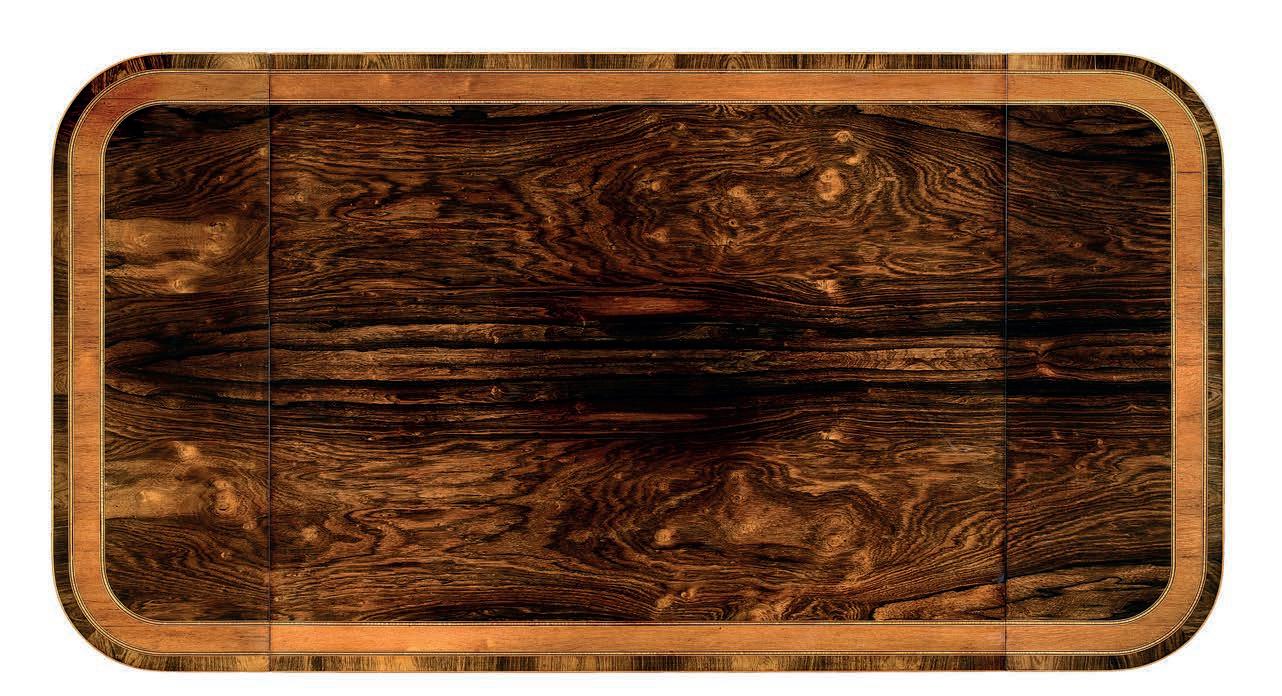
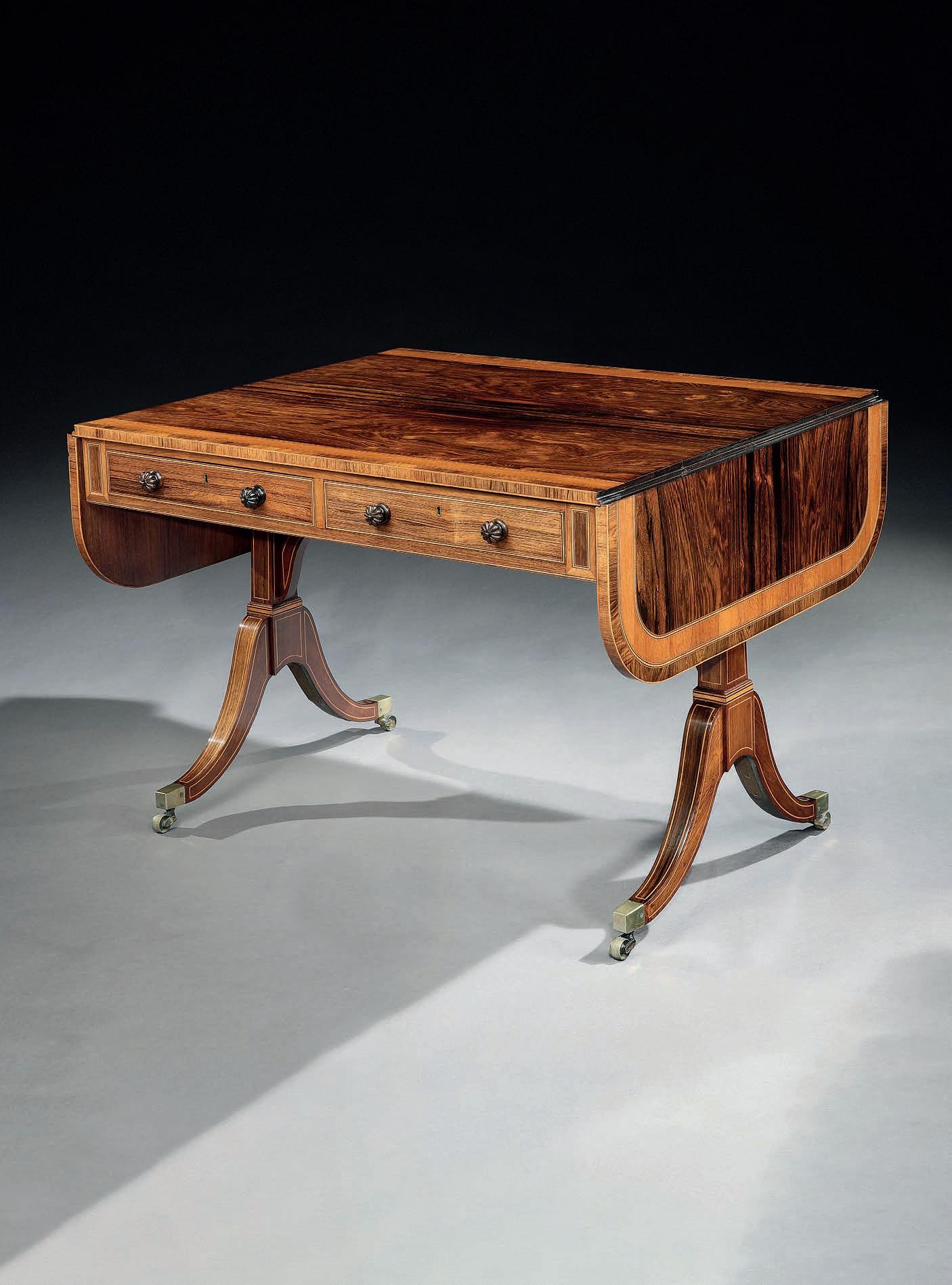
Attributed to Paul Saunders England, circa 1765
A mid 18th century George III Chippendale period mahogany and parcel gilt side chair, attributed to Paul Saunders. In the French taste, of extremely elegant design with serpentine shaped upholstered back and seat, standing on refined cabriole legs to front and rear, carved with stylised shells, acanthus and C-scrolls, and with scroll toes.
The mahogany of fine colour, and retaining the original parcelgilt decoration to the legs.
Height: 37 in (94 cm)
Width: 24¼ in (62 cm)
Depth: 23¼ in (59 cm)
From the collections of the Dukes of Leeds, Hornby Castle
Literature
Christopher Claxton Stevens and Stewart Whittington, 18th Century English Furniture - The Norman Adams Collection, p. 41 and p. 45 - for armchairs from the same suite.
Paul Saunders, was a leading cabinetmaker in London in the 1750s and 1760s. He held the title of Tapestry Maker to His Majesty George III and also received a number of important commissions from notable patrons of the day. Saunders’ workshop was based around Carlisle House, Soho Square and latterly from 59 Greek Street, when he partnered with the cabinetmaker and upholsterer, William Bradshaw. Saunders in particular supplied furniture to Thomas Coke, 1st Earl of Leicester (1697 – 1759) for Holkham Hall, Norfolk – including a suite of parcel-gilt side chairs, with similarly carved front legs.

England, circa 1720
A George I walnut and parcel gilt bureau cabinet. The moulded broken arched cornice with carved giltwood finials above two conforming mirrored doors, opening to reveal pigeonholes, niches and drawers, centred around a small cupboard with a bevelled mirrored door that conceals secret drawers, the lower section with a slant front opening to reveal a writing surface and interior with further drawers and pigeonholes, the base with three short and three long feather-banded figured drawers and supported on bracket feet. Retaining the original metalwork.
Superb colour walnut and craftsmanship throughout.
Height: 97 in (246.5 cm)
Width: 40½ in (103 cm)
Depth: 22¼ in (57 cm)
Provenance:
With Hotspur Ltd., Belgravia, London Private Collection, London
With Stair and Company, London
The Collection of Theodore and Ruth Baum, USA
Literature: M. Pick, Antique Furniture, Collins Gem, 1999, p. 208 (illustrated)
This cabinet features burr walnut veneers of the finest quality with feather banding and fine cross mouldings. The interior is constructed of wainscot oak, a particular type of oak noted for its fine grain and lack of imperfections. This type of oak was imported from the Baltic.

England, circa 1765
A pair of mid 18th century George III giltwood open armchairs. Of generous proportions and in the French taste, the serpentine shaped seats, backs and arms upholstered in close-nailed antique velvet, the giltwood arms supports scrolled and fluted, standing on elegant detailed cabriole legs terminating in scroll toes.
Height: 38¼ in (97 cm)
Width: 28¾ in (73 cm) Depth: 25 in (63.5 cm)
These ‘French’ elbow chairs correspond closely to a pattern for chairs supplied to Charles Poulett, 5th Duke of Bolton (d. 1765) for Hackwood Park, Hampshire. A further set of a similar model was presumably supplied to Sir John Byrne Leicester for Tabley House, Cheshire, commissioned when he employed John Carr of York to build the the great house between 1761 and 1765. Examples of the chairs remain at Tabley today.
Although the identity of the maker is not known, these chairs feature upholstered serpentine backs and seats, cabriole legs and the distinctive applied gilded detailing to the seat rails. This particular feature relates to a much more elaborate set of chairs supplied by Thomas Chippendale for Dumfries House in 1759 (C. Gilbert, The Life and Work of Thomas Chippendale, London, 1978, vol. II, p. 85, pl. 139). Our chairs are gilded, while others of the same model were made in mahogany, and others of fruitwood which originally would have had a gilded or painted finish.
A pair of the Hackwood model, supplied to Charles Poulett, 5th Duke of Bolton, circa 1765 was sold with along the Hackwood estate in 1935 to William Berry, 1st Viscount Camrose; these passed by descent until sold Christie’s London, 8 July 1999, lot 58.

England, circa 1680
An important and extremely rare Charles II Baroque period giltwood frame of magnificent proportions. The rectangular mirror plate surrounded by an inner frame of ribbon-tied berried laurel leaves - the outstanding external framework festooned with scrolling carved foliage and flowers in wonderfully exuberant form, the cresting surmounted by a carved parrot flanked by a pair of winged putti, the sides and base similarly carved with winged putti amongst the foliate scrolls. Retaining its original gilding.
Height: 81½ in (207 cm) Width: 63 in (160 cm)
Comparative Literature Mallett, a comparable illustrated Country Life, 10 November 1977 R. Edwards, The Shorter Dictionary of English Furniture, p.350, fig. 4 (a comparable example at Burghley House, Lincolnshire)
Frames of this type were normally gilded with silver-leaf with some gilded highlights, primarily due to the huge expense of the finish. Therefore, it is really unusual that the gilding analysis undertaken showed that this frame was originally gilded in its entirety with gold leaf which underlines the importance and huge cost incurred in the original commission.
This mirror is notable for its magnificent proportions.

England, circa 1765
A George III Chippendale period mahogany serpentine cheston-chest. The cornice with carved moulding and a blind fretwork frieze above seven graduated long drawers, flanked by chamfered blind fretwork corners, standing on ogee bracket feet carved with flowerheads. Each drawer with magnificent original pierced foliate and flowerhead cast gilt handles and escutcheons.
Of particularly fine proportions, this chest stands extremely well.
Height: 73¾ in (187 cm)
Width: 48¼ in (123 cm)
Depth: 26 in (66 cm)
Provenance Hotspur Ltd., London, 1981 Private Collection, UK
Comparative Literature
C. Gilbert, Marked London Furniture 1700-1840, London, 1996, pp. 93-104
This chest-on-chest with its distinctive use of blind fretwork relates to the cabinet work of Philip Bell.
Bell operated his workshop at No. 23 St Paul’s Church Yard, and his trade card read: ‘Philip Bell / at the WHITE SWAN against / The South Gate in St Pauls Church Yard / London / Makes & sells all sorts of ye finest Cabinet Goods, / all sorts of Looking Glasses, Coach Glasses & Chairs / of all sorts at Reasonable Rates / NB. Old Glasses new Worked & made up Fashionable.’
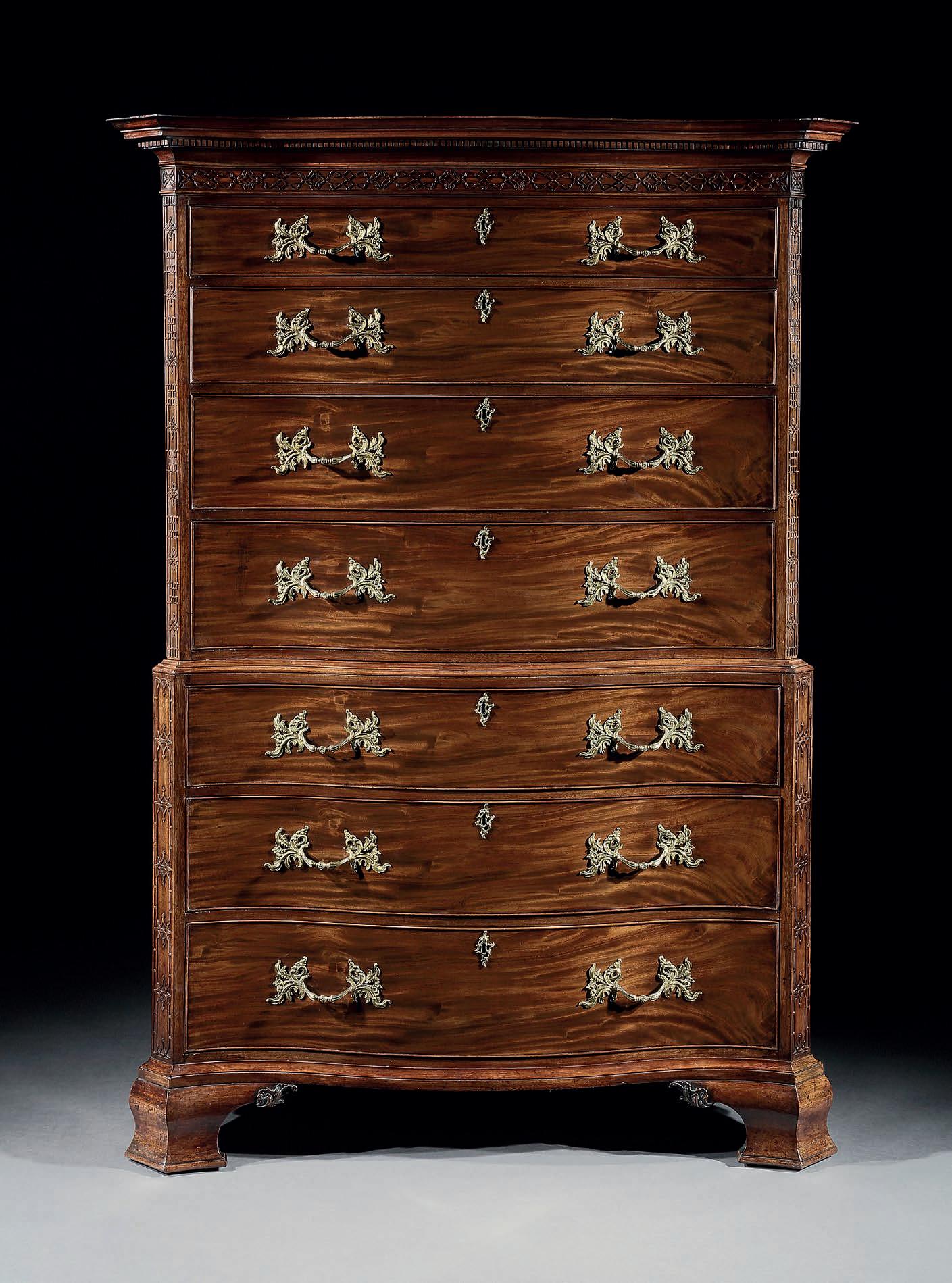
England, circa 1790
A George III mahogany tilt-top dining table. The rectangular top, with moulded edge, incredibly made from a single piece of timber, supported on a bold turned pedestal base with four outswept legs terminating in fine brass box castors.
The mahogany with outstanding colour and patination.
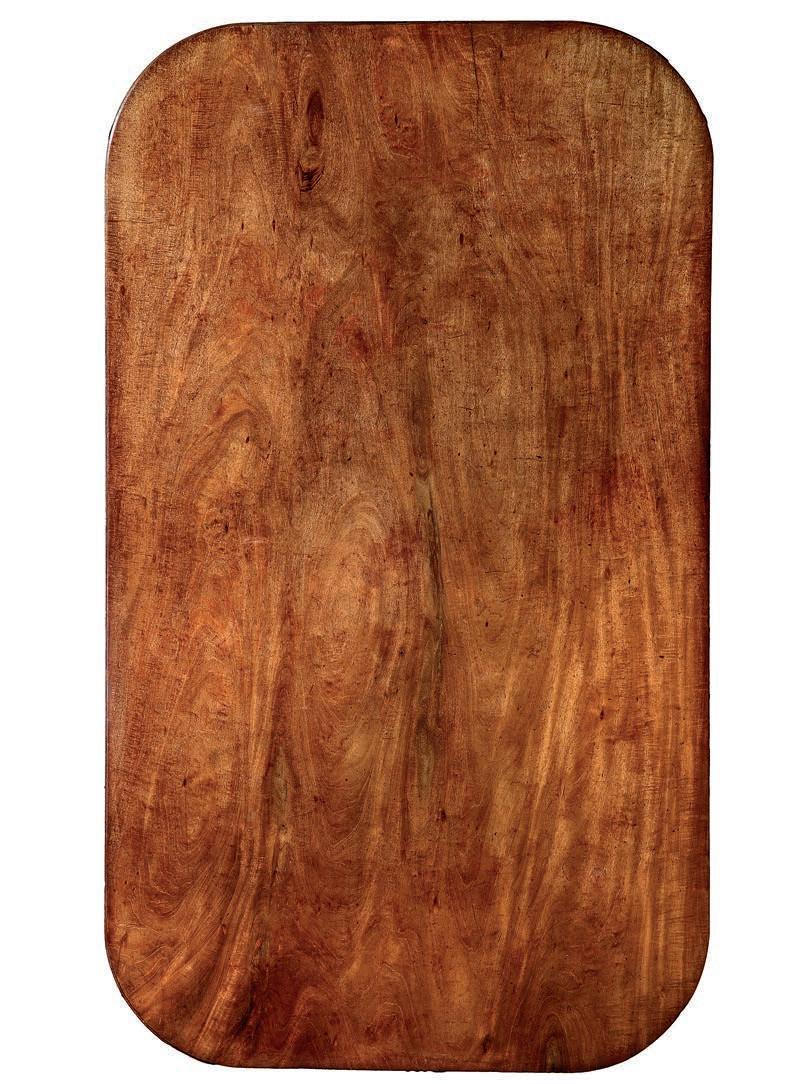
Height: 28 in (71 cm)
Width: 74 in (213.5 cm)
Depth: 48¾ in (123.5 cm)
With Norman Adams Ltd, Knightsbridge Private Collection, London
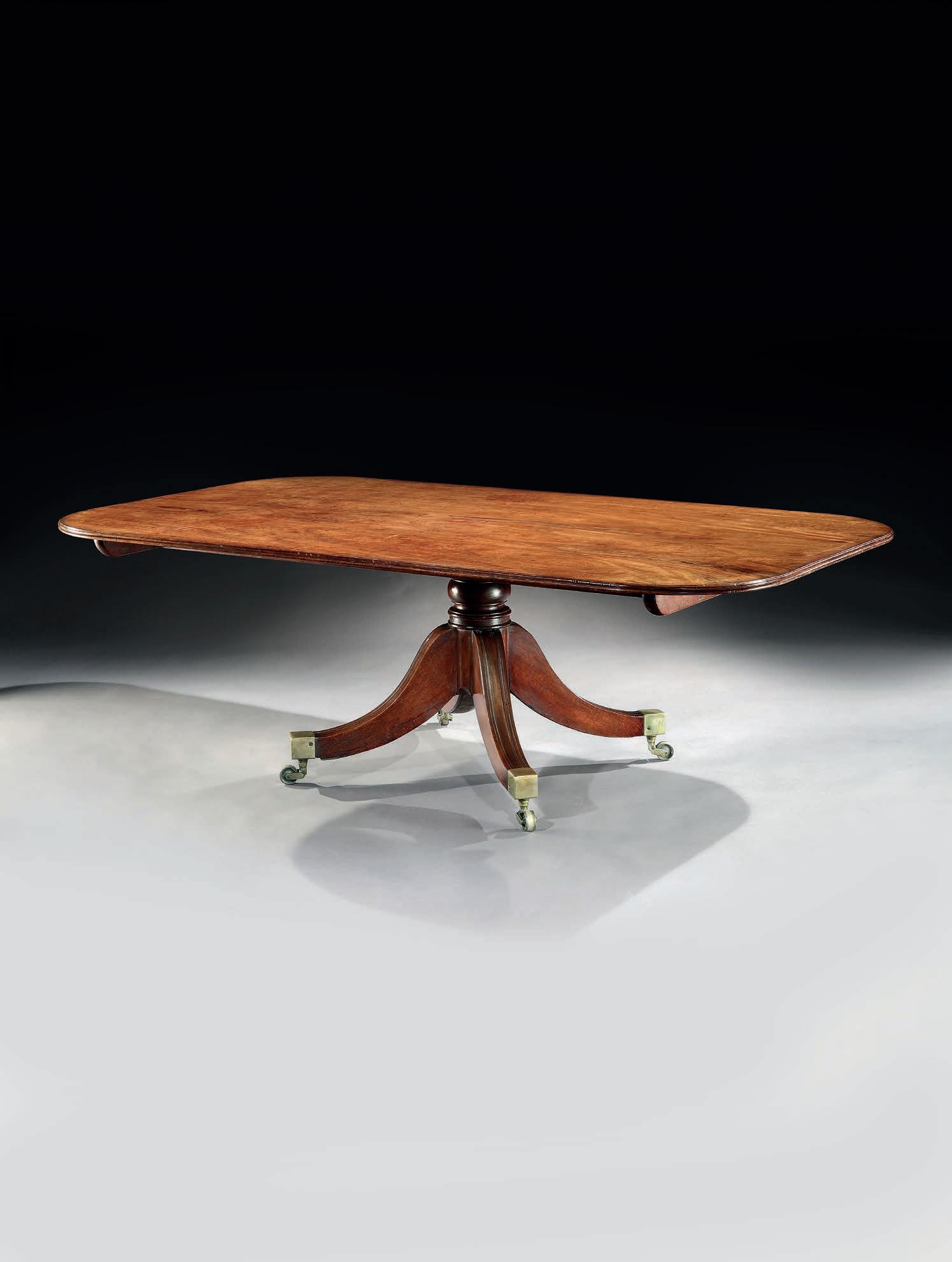
In the manner of Thomas Chippendale England, circa 1760
A set of six George III Chippendale period mahogany side chairs. Each with particularly finely carved back with pierced splat and blind fretwork carved rear stiles. On plain chamfered legs, joined by an H-stretcher. The seats upholstered.
Height: 37½ in (95 cm)
Width: 32 in (81 cm)
Depth: 24 in (61 cm)
The superb carved backs on this fine set of chairs relate very closely in design to a single example previously with Moss Harris & Sons and shown at the Art Treasures Exhibition at Christie’s in 1932 (no. 161) – the same chair was included that year in The Illustrated London News, A Page for Collectors - A Talk About Chairs , 14 May 1932, p. 816 and described as ‘A Chair that is Worthy of Chippendale at its Best; a Masterpiece that indicates its origin by its delicate tracery and its fine and graceful pattern’.
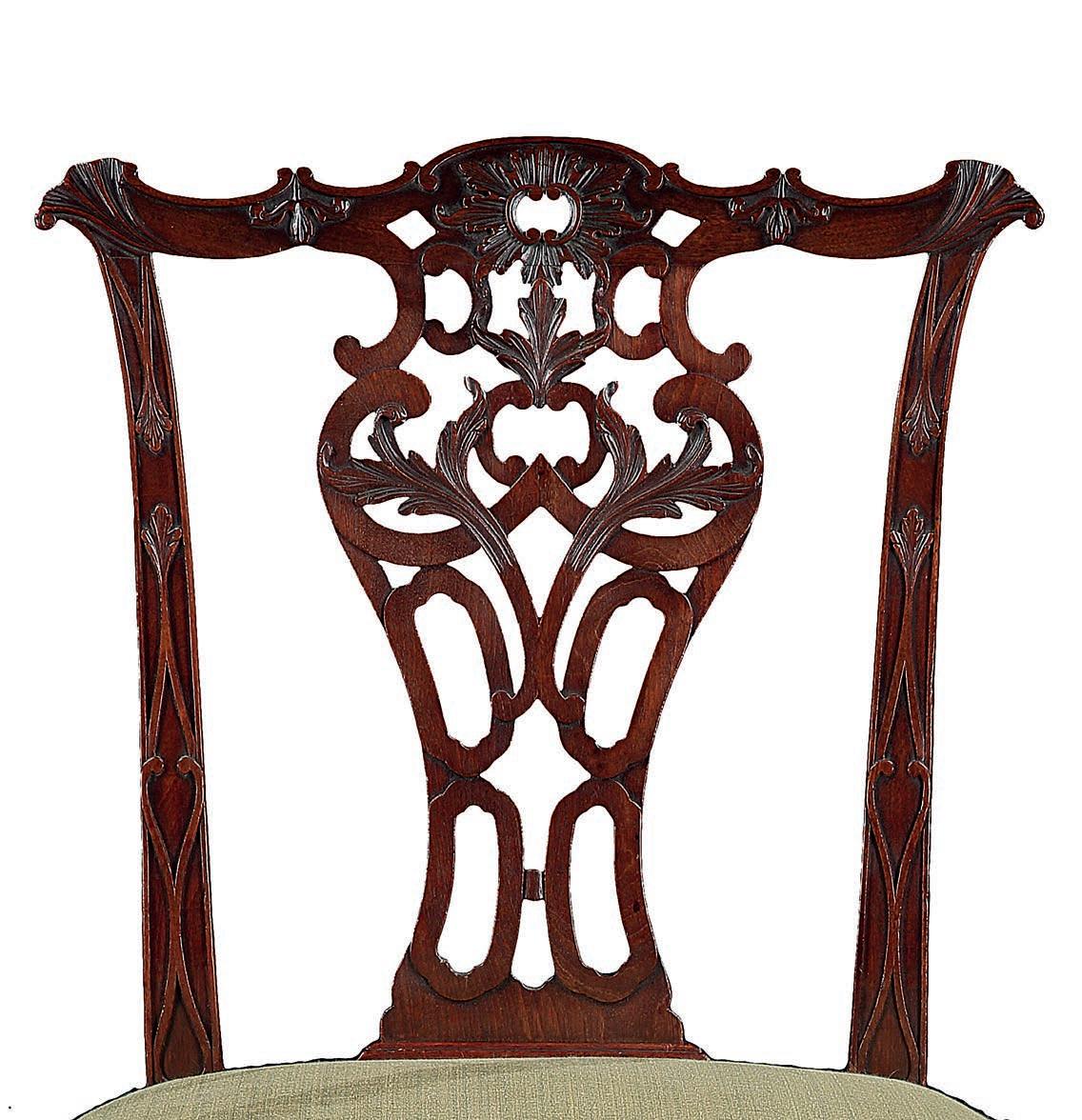

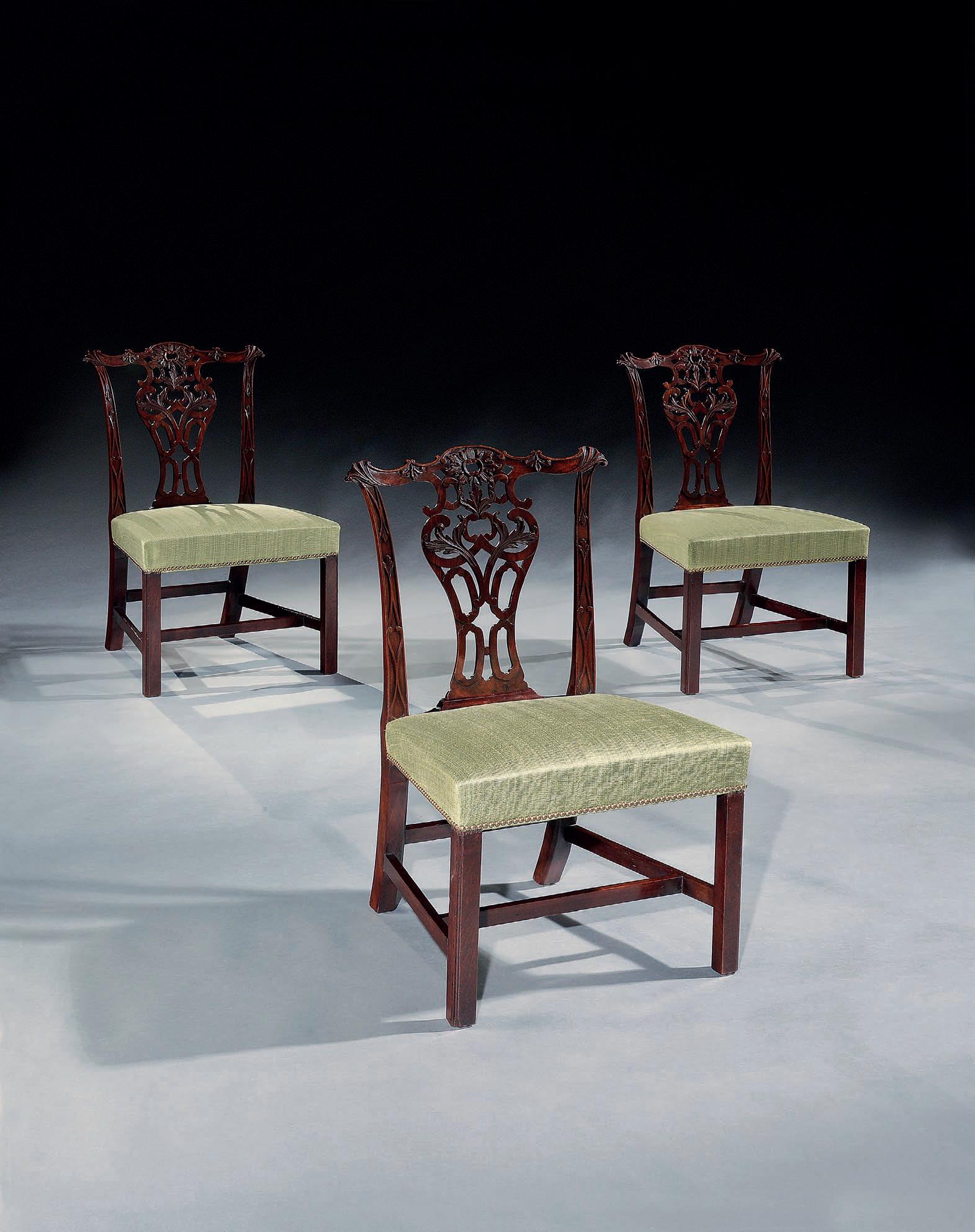
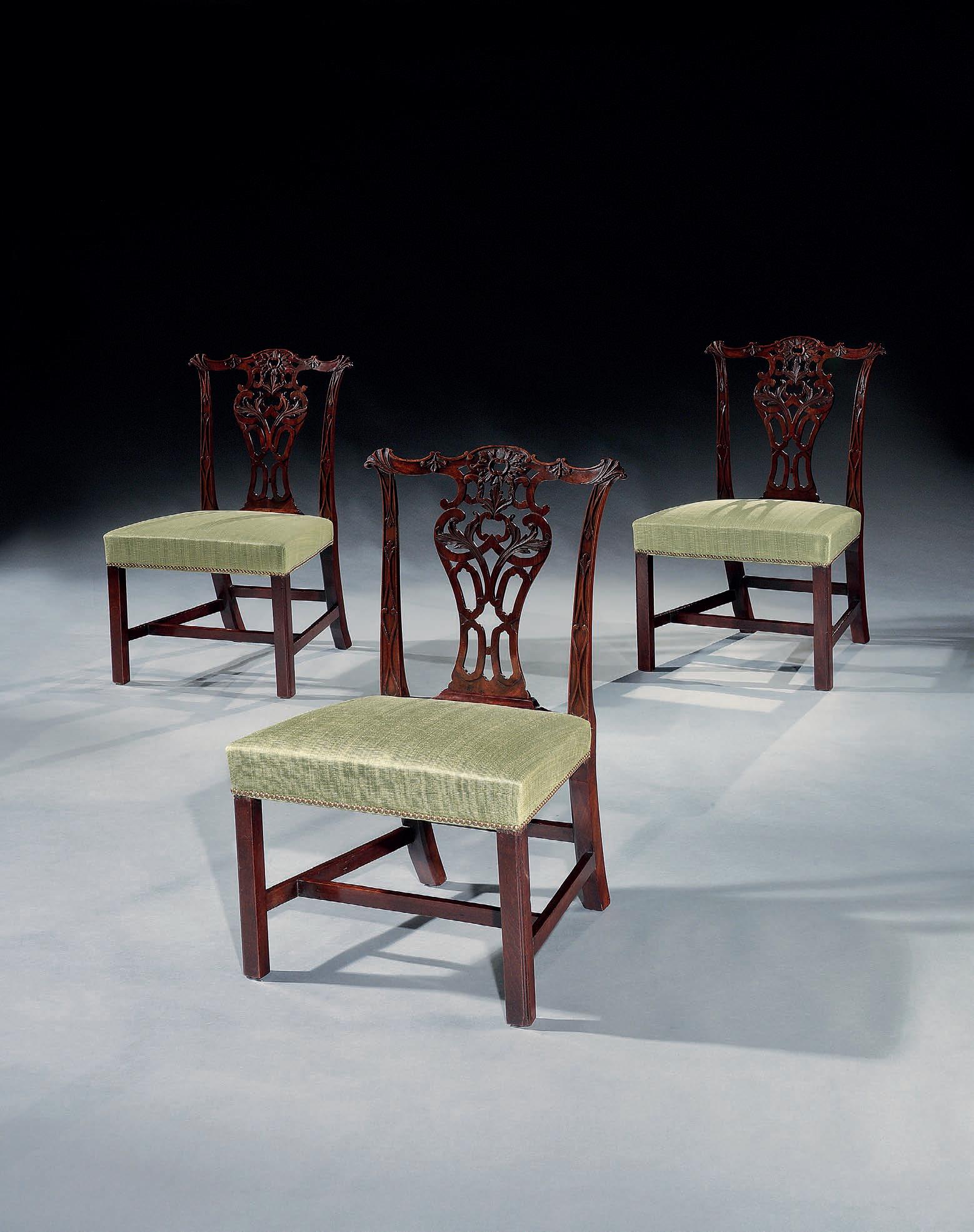
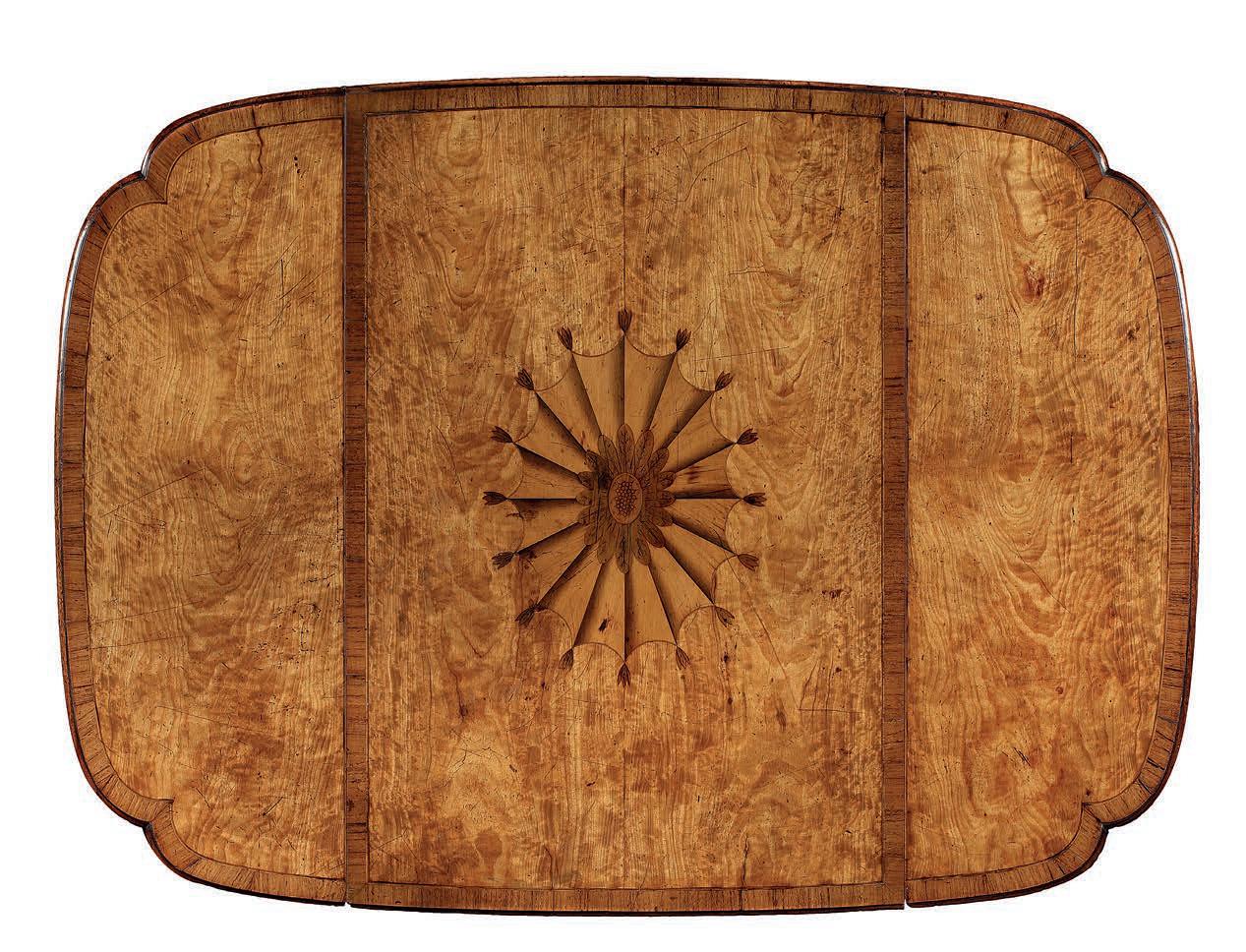
In the manner of Thomas Chippendale England, circa 1770
A George III satinwood and marquetry Pembroke table, with exceptional colour and patina. The shaped twin-flap top with rosewood cross-banding, the central panel with beautifully inlaid marquetry, with a single frieze drawer to the front, and a false drawer behind, on square tapering legs ending in box castors.
Height: 27¾ in (70.5 cm)
Width: 39 in (99 cm)
Depth: 28¾ in (73 cm)
The superb quality of this table, both in execution and design, suggests it likely originated from a sophisticated London workshop. A near identical table was recorded in the collections at Culzean Castle, Ayrshire – ancestral home of the Earls of Cassilis. It is tempting to consider Thomas Chippendale as a candidate for this table given its quality and form. It is conceivable that the Culzean table is indigenous and as the castle was a Robert Adam commission, the architect’s strong links with Chippendale can only support the case. A very closely related table was advertised by The Hatfield Gallery in Connoisseur, June 1914, p. 20.

In the manner of Matthew Darly England, circa 1740
A George II mahogany side chair in the manner of Matthew Darly. Of bold proportions, the magnificent interlaced back above a silk velvet damask upholstered seat, and standing on fine acanthus and cabochon carved cabriole legs terminating in hairy paw feet.
Height: 40 in (102 cm)
Width: 24¼ in (62 cm)
Depth: 26 in (66 cm)
The collection of Violet Trefusis.
Comparative Literature Country Life, ‘Hall Barn, Buckinghamshire - III - The Home of Major-General The Hon. E. F. Lawson’, 3 April 1942, (a set of these chairs illustrated in the dining-room)
M. Harris and Sons, A Catalogue and Index of Old Furniture and Works of Decorative Art From Late Sixteenth Century - Early Nineteenth Century, Pt. II, p. 192
Violet Trefusis was born Violet Keppel - the daughter of Alice Keppel, the favourite mistress of Albert Edward (“Bertie”), the Prince of Wales. Violet’s only sibling, Sonia, is the maternal grandmother of Camilla, Duchess of Cornwall. Violet Trefusis was an English socialite and author, chiefly remembered for her lengthy affair with the writer Vita Sackville-West.
A pair of chairs from presumably the same suite was sold Christie’s London, Important English Furniture, Eastern Rugs and Carpets, 20 November 1986, lot 182, from the collection of Sir Charles Clore. They had previously been sold Christie’s London, 11 December 1942, lot 72 - from the collection the late Viscount Rothermere, for the then impressive price of £120. They were subsequently offered Sotheby’s New York, Important English Furniture, 24 October 1992, lot 234.
Two chairs from the suite (possibly the above), but then with gilded highlights,are illustrated in M. Harris and Sons, A Catalogue and Index of Old Furniture and Works of Decorative Art From Late Sixteenth Century - Early Nineteenth Century, Pt. II, p. 192, and also The Henry Hirsch Collection, sold Christie’s, 10 June 1931, lot 67,illustrated in Christie’s Review of the Season 1930 -1931, and exhibited at the Loan Exhibition of Georgian Art, 1931.
A pair of settees, presumably from the same suite,was advertised by Frank Partridge & Sons Ltd. in Country Life Annual 1952. One settee had been advertised in the The Illustrated London News, 8 October 1932, p. 548 - as part of The Art Treasures Exhibition (no. 146) and with Messrs. Rice and Christy Ltd. of Wigmore Street. These were subsequently offered Sotheby’s New York, Important English Furniture and Decorations, 3-4 June 1988, lot 121, as part of the collection of Leigh B. Block, a Trustee, President and Chairman of the Art Institute of Chicago.
Reference can be made to the chair designs of Matthew Darly and those included in The Chair-Maker’s Guide published by Robert Manwaring in 1766 (e.g. plate 41) (see P. Ward-Jackson, English Furniture Designs of the Eighteenth Century, 1958, fig. 180).

Probably by Ince & Mayhew England, circa 1770
An important set of six Chippendale period giltwood open armchairs, probably by Ince & Mayhew. Each with inverted heartshaped back, the arms rests, padded back and serpentine seat upholstered, the channelled armrests sweeping down and mounted above the legs, the front rails centred by a foliate oval patera, on fluted turned tapering legs headed by a gadrooned collar and flowerhead, on turned feet. Upholstered in blue strié silk.
Each with cramp cuts to the underside and exposed single vertical splat to the backs.
Height: 36 in (91.5 cm)
Width: 23¼ in (59.5 cm)
Depth: 23¼ in (59.5 cm)
Presumably commissioned by Thomas Gurnell (1725 - 1785), Pitzhanger Manor, Ealing, then by inheritance to his son Jonathan Gurnell (1756 - 1791) to his daughter Mary Ann Armstrong ( née Gurnell) and thence by descent through the Armstrong Family
Thomas Gurnell was a wealthy merchant and banker, a founding partner of Gurnell, Hoare & Co. In about 1760 he purchased Pitzhanger Farm, Ealing and engaged the architect George Dance to construct a country house for him and his family. The residence became known as Pitzhanger Manor (sometimes referred to as Ealing House). It is presumed that the chairs were either purchased or commissioned at this time as part of the grand furnishing scheme for the new interiors. The chairs were most likely made by Ince & Mayhew who, along with Thomas Chippendale and a handful of others, were the cabinet-makers of choice to the London elite at that time. Pitzhanger Manor was sold in 1800 by the Gurnell trustees to Sir John Soane, who promptly remodelled the building. The chairs, together with family portraits by Highmore, Opie and Dance and presumbly other furnishings and effects, passed down from the Gurnell family to the Armstrongs by marriage.
A number of features of these chairs have been identified as characteristics of chairs likely to have been made by the Golden Square firm of William Ince and John Mayhew. The chairs also share many constructional features with chairs supplied by Thomas Chippendale - including the exposed strut behind the upholstered back, cramp cuts and batten carrying holes on the underside of the seat frames. However, the overall design does not quite tie in with documented Chippendale suites of seat furniture, making the attribution to Mayhew & Ince much more likely, with details and differences including the scrolled arms descending directly into the top of the legs (rather than set back into the sides of the seat rails), the very restrained base of the inverted heart-shaped backs and the distinctive profile of the legs with their reeded collars.
A very close comparison is a set of giltwood armchairs supplied to George Greville, 2nd Earl of Warwick (sold by the Trustees of the Warwick Castle Resettlement, Christie’s London, 10 April 2003, lot 25). There is a payment to Ince & Mayhew that totals £180 in the 2nd Earl of Warwick’s account with Hoare’s bank. In addition, comparisons can be made with chairs supplied to Chirk Castle, Denbighshire and the 3rd Earl of Darnley at Cobham Hall – Ince and Mayhew are known to have worked extensively at both houses.

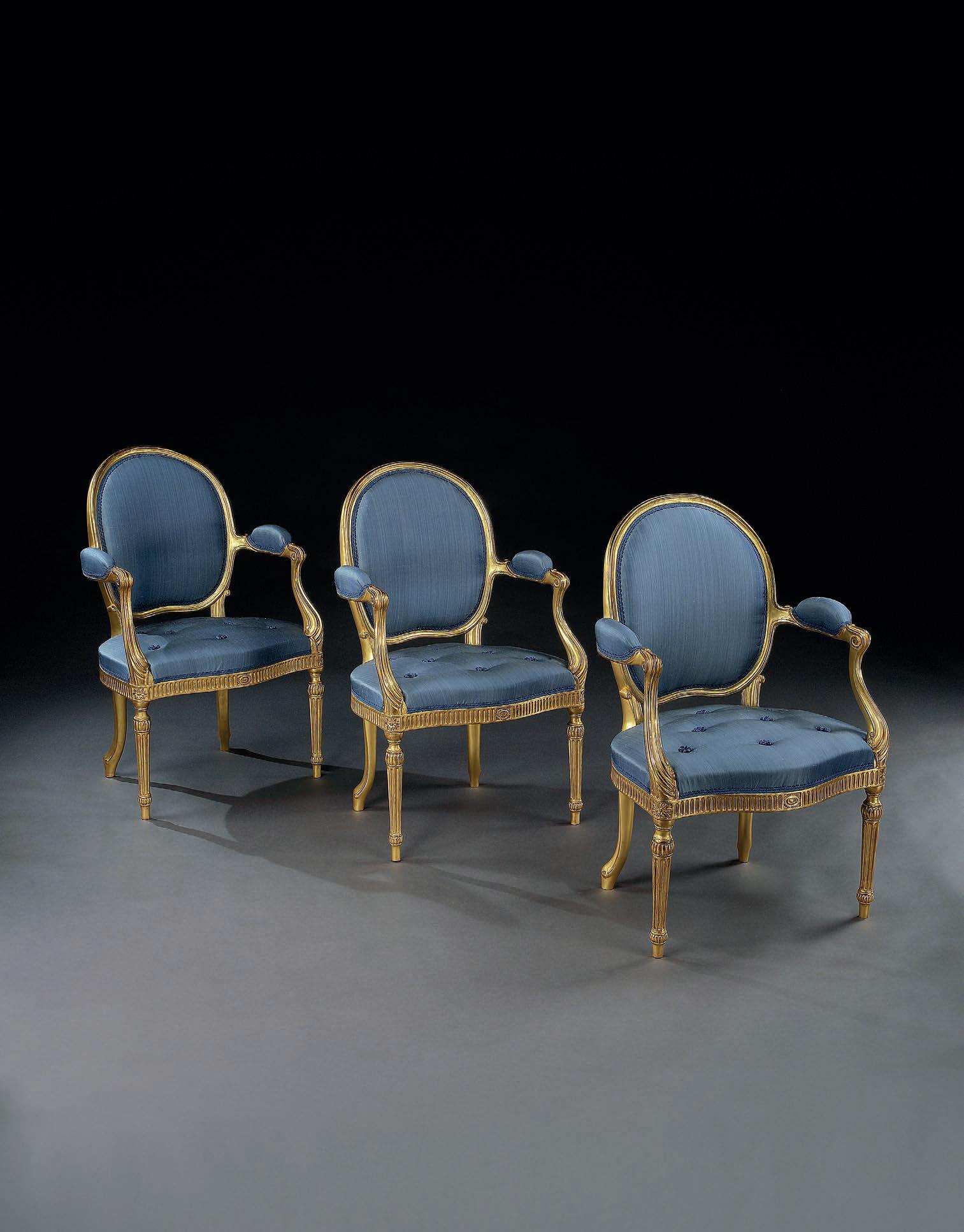

England, circa 1700
A large and very rare Queen Anne period pier mirror, with three bevelled plates in an arched frame within a red and gilt verre églomisé border decorated with leafy strapwork, inset in a simple moulded giltwood frame carved with a repeating pattern of foliage and formalised scrollwork. Possibly reduced in height.
Height: 90½ in (230 cm)
Width: 42¾ in (109 cm)
The term verre églomisé derives from the name of the 18th century Parisian dealer, framer and restorer Jean-Baptiste Glomy (17111786). The technique involves applying gold or silver leaf to the reverse of a glass plate into which designs are then engraved with subsequent applications of coloured foils and pigments providing the background colour. Reds or blacks were popular colours, and shades of blue and green were also used but rarer. The technique existed in ancient Rome and enjoyed a revival in France and Europe during the reign of Louis XIV. Eglomisé border glasses were often engraved with figural and arabesque motifs in the manner of Jean Bérain (1640 – 1711) and Daniel Marot (1661 – 1752) and certainly the arrival of Marot in England in 1694 would have likely promoted this stunning decorative technique there.
An interesting historical note refers to ‘A large old fashioned Glass Sconce, in a Glass Frame, with Gold Flowers painted on the Glass Frame, and a Green Ground’ was stolen in 1727 from the Long Acre premises of Benjamin Goodison. Goodison’s former ‘Master’ James Moore (d. 1726), in partnership with John Gumley had provided mirrors for the Royal residences from 1707. In 1707, the Pelletier brothers, René and Thomas (active c. 1680 -1720) are recorded supplying a pair of églomisé overmantel mirrors to Ralph, 1st Duke of Montagu for Ditton House, Buckinghamshire. Sometimes of massive proportions, other examples were supplied to Penshurst Place, Hatfield House, Kedleston Hall and Chatsworth – and others can now be viewed in Victoria & Albert Museum, London and the Metropolitan Museum, New York.
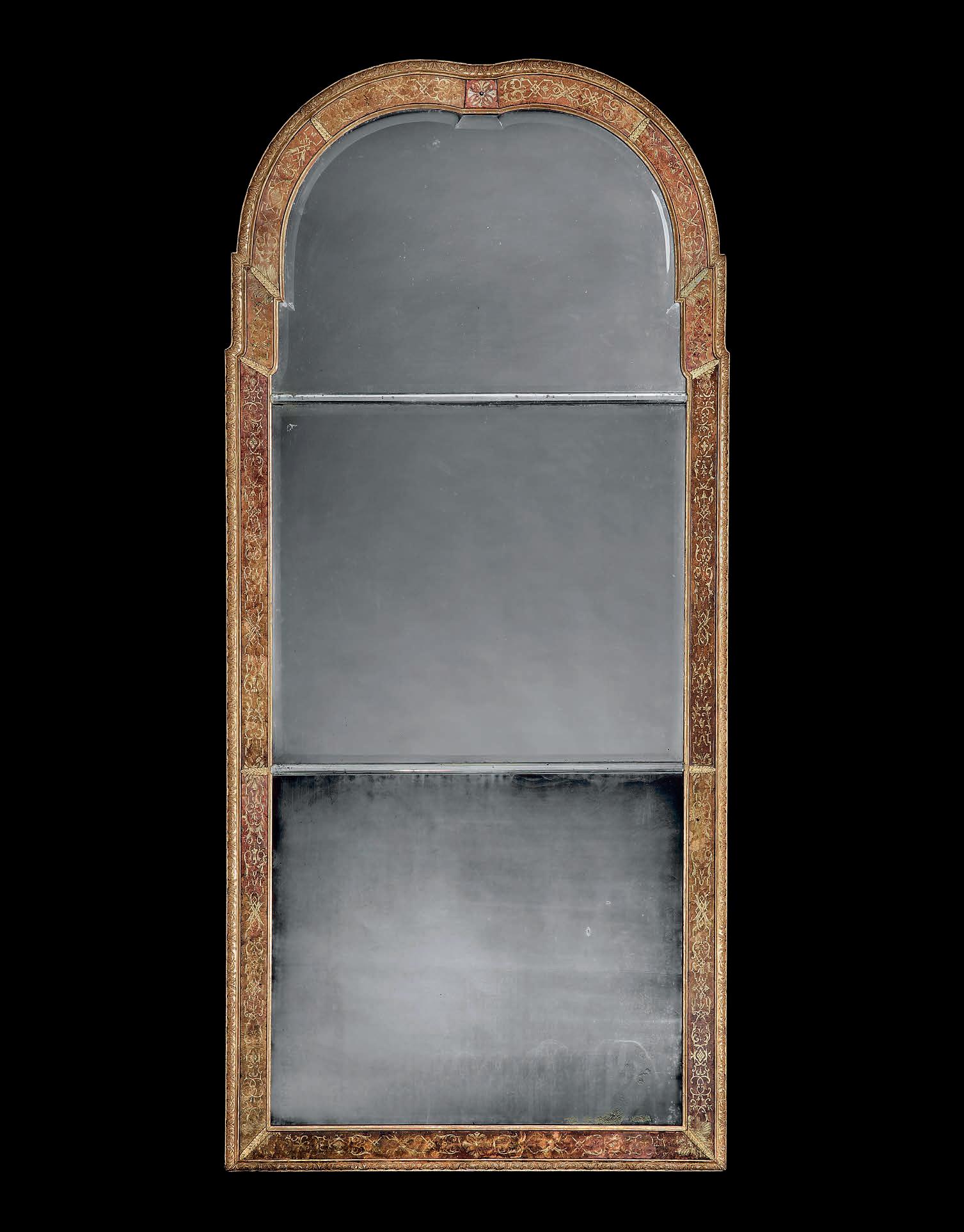
England, circa 1760
A George III mahogany Gainsborough armchair, with upholstered square back, seat and armrests, the arms supports finely carved with floral paterae and swirling acanthus, with square chamfered legs joined by H-stretchers.
Of very good proportions, colour and with fine carving.
Height: 39 in (99 cm)
Width: 28 in (71 cm)
Depth: 29¼ in (74 cm)
Presumably supplied to Philip Howard (1730-1810) and thence by descent.
Chairs from the suite were sold Philips, Corby Castle - House Sale, 18 May 1994, lots 346 - 348
Literature
Country Life, Corby Castle, 1954 (three armchairs illustrated in the library)
Corby Castle, situated on the southern edge of the village of Great Corby in Cumbria, is an ancestral home of the Howard family. The original house was built in the 13th century as a red sandstone tower house by the Salkeld Family, who also owned nearby Salkeld Hall. In 1611, the castle was sold to Lord William Howard, the third son of Thomas Howard, 4th Duke of Norfolk, who added a two-storied L-shaped house onto the peel tower. Sir Francis Howard, as the second son inherited the subsidiary estate of Corby after the death of his father in 1640.
The present façade was built for Sir Francis’ great-great grandson, Henry Howard, by Peter Nicholson between April 1812 and September 1817.
Henry Howard had inherited the estate upon the death of his father Philip Howard, to whom the present chair was likely supplied. The house and estate then passed by direct descent to Philip John Canning Howard whose only child, Ursula Mary, married Sir Henry Joseph Joseph Lawson, 3rd Bt. and duly inherited in 1934. The Howard-Lawson family retained ownership until 1994 when Corby Castle was sold.

England, circa 1680
A pair of William and Mary period carved walnut high back armchairs. Each back with a carved border frame surmounted by an elaborate carved cresting centred on a portrait medallion. With bold outswept arms with carved detail, standing on turned carved baluster legs joined by shaped finial mounted crossstretchers. The back and seats caned. Fitted with silk velvet cushions.
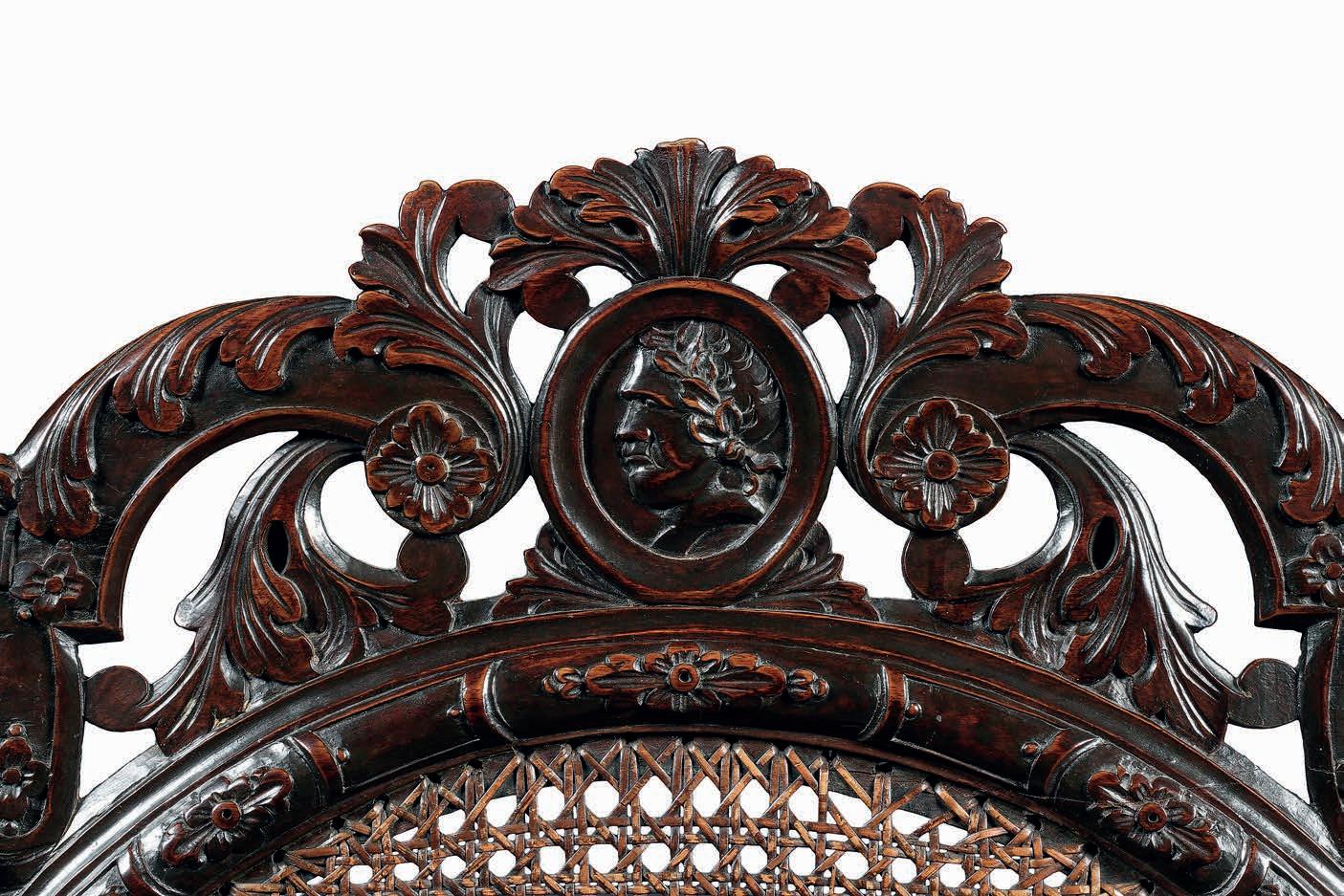
Height: 53 in (135 cm)
Width: 27 in (69 cm)
Depth: 18½ in (47 cm)
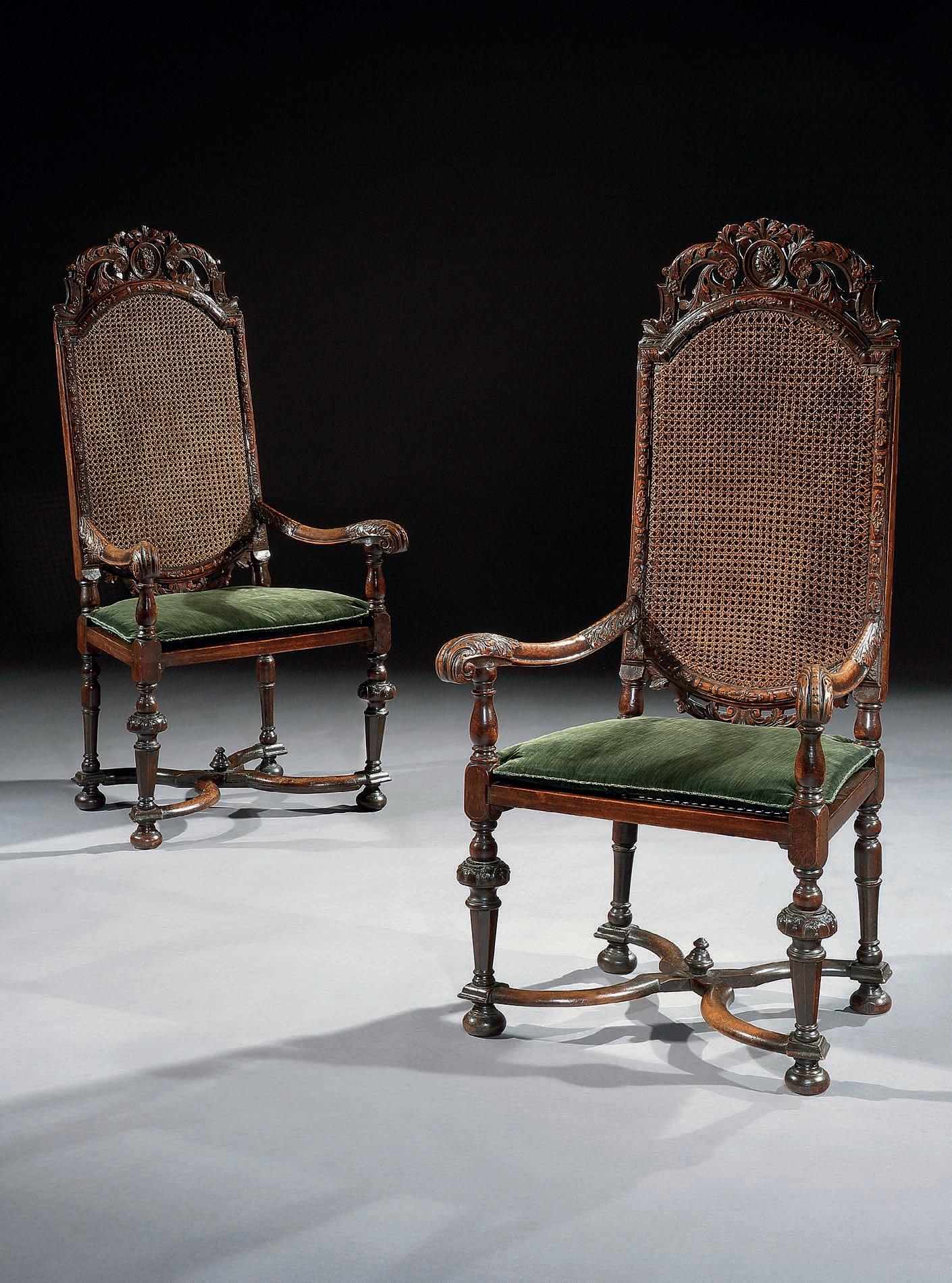
Attributed to Vile and Cobb England, circa 1760
An important George III ormolu mounted mahogany commode attributed to Royal cabinet-makers William Vile and John Cobb. The serpentine top with moulded edge above two short and two long cock-beaded drawers flanked by ormolu chutes cast with foliage and masks, the incurved feet with scrolling sabots.
The mahogany of fine colour and patina throughout. With superb elaborate ormolu handles and escutcheons.
Height: 32¾ in (83 cm)
Width: 40 in (101.5 cm)
Depth: 25¼ in (64 cm)
With Blairman, London, 1957 Private Collection, USA since 1957
R. W. Symonds, ‘English Commodes in the French Taste’, Connoisseur, March 1957, pp. 16 -20, fig. 1 (illustrated) Lucy Wood, Catalogue of Commodes, London, 1994, pp. 43-53
This superb commode is part of a small and distinguished group attributed to the London Royal cabinet-makers William Vile and John Cobb. These commodes are discussed at length by Lucy Wood in her Catalogue of Commodes. They are characterized by their serpentine form, lustrous mahogany and rich ormolu mounts which are influenced by French Régence patterns produced in France some thirty years earlier. There are subtle variations within the group including different drawer arrangements, more or less pronounced serpentine fronts, straight or moulded edge to the tops, ebony detailing, cockbeading on the drawers and sometimes ormolu carrying handles to the sides.
A group supplied to Burghley House, Lincolnshire - one from the Blue Silk Dressing Room which compares closest to this commode, with the same drawer combination and two further pairs from the Brown Drawing Room and Pagoda Room. Two pairs from Blickling Hall, Norfolk (one pair was sold in 1993) - these have straighter sides and lack the moulded edge to the tops. A pair now in the Lady Lever Art Gallery, having been purchased by Lord Lever in 1914.
Two pairs supplied to John, 2nd Earl of Ashburnham, and subsequently sold from Ashburnham Place, Sussex, Sotheby’s, 79 July 1953, lots 135 and 136. Lot 135 was subsequently sold at Christie’s New York, 13 October 2020, lot 14 for $300,000 and lot 136 at Christie’s London, 14 June 2001, lot 140 for £421,750
A single example of slightly smaller scale supplied to the 5th Duke of Bolton for Hackwood Park, Hampshire, sold Christie’s, 8 July 1999, lot 62 for £199,500.
A single example with a more elaborate carved lambrequin apron, possibly supplied to Richard Grenville, Earl Temple for Wotton House, Buckinghamshire; subsequently sold from the collection of Simon Sainsbury, Christie’s London, 18 June 2008, lot 50 for £193,250.
These commodes can be confidently attributed to the celebrated Royal cabinet-makers William Vile and John Cobb based on their association with other related models recorded by the firm and a known working relationshop between the cabinet-makers and the houses to which the various commodes were supplied. Most notably, at Blickling there is a payment by the 2nd Earl of Buckinghamshire to ‘Vile & Cobb cabinet-makers’ in August 1762 for £86.5s.9d which is sufficient to account for the four Régence pattern commodes and one other related example. This additional single commode at Blickling shares the same mounts and other distinguishable features with a documented example supplied by Cobb to James West at Alscot Park in 1766 for £16. Although Vile and Cobb are not documented at Burghley, Lucy Wood suggests they may have been made by Vile and Cobb but subcontracted to them by another firm such as Ince & Mayhew. The commodes at Burghley have considerable variations in construction and a former apprentice of Cobb called Henry Tatham was based nearby in Stamford and employed at Burghley from at least 1772.
Along with Thomas Chippendale, Vile and Cobb were arguably the most accomplished cabinet-makers of the mid-Georgian period, a golden age for mahogany furniture. William Vile (d. 1767) worked initially with the esteemed cabinet-maker William Hallett (d. 1773) before setting up in partnership with John Cobb (1715-1778) in 1751 and establishing their workshop in St. Martin’s Lane. They were appointed ‘cabinet-makers’ to George III in 1761 and supplied a series of magnificent pieces to several Royal residences including Kensington Palace, St. James’s Palace, and the Queen’s House, now Buckingham Palace.
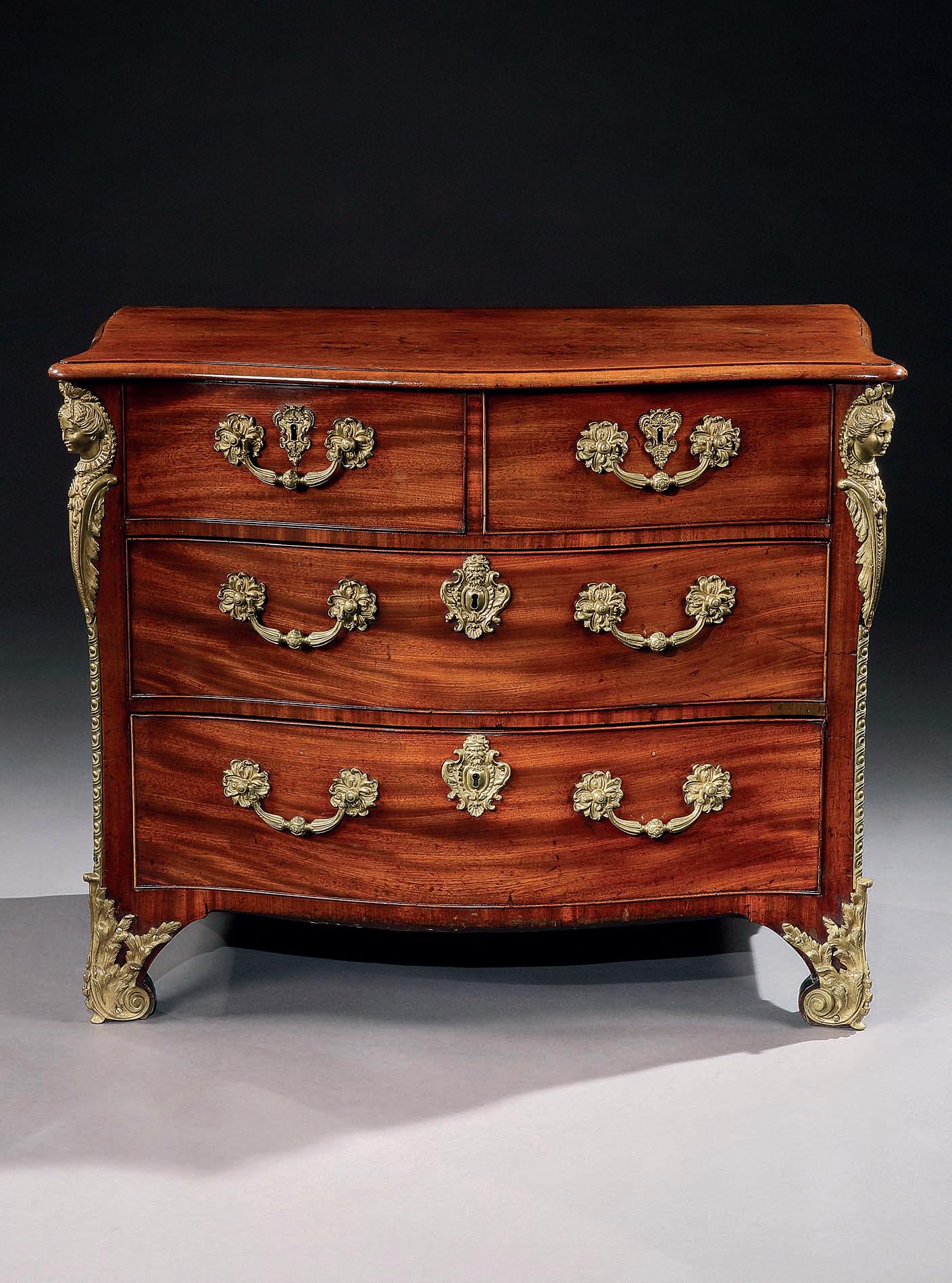
Attributed to Royal cabinet-makers Morel and Seddons England, circa 1830
A pair of Regency period amboyna and parcel gilt card tables. The D-shaped tops with exceptional amboyna veneers, with a gilt beading to the lower frieze, supported on magnificent gilt turned and carved pedestals, on a shaped base of amboyna with parcel-gilt detailing, and standing on foliate deep-carved foliate giltwood bun feet. The hinged tops opening to reveal green baize interiors, and a space underneath hidden in the frieze to store games pieces.
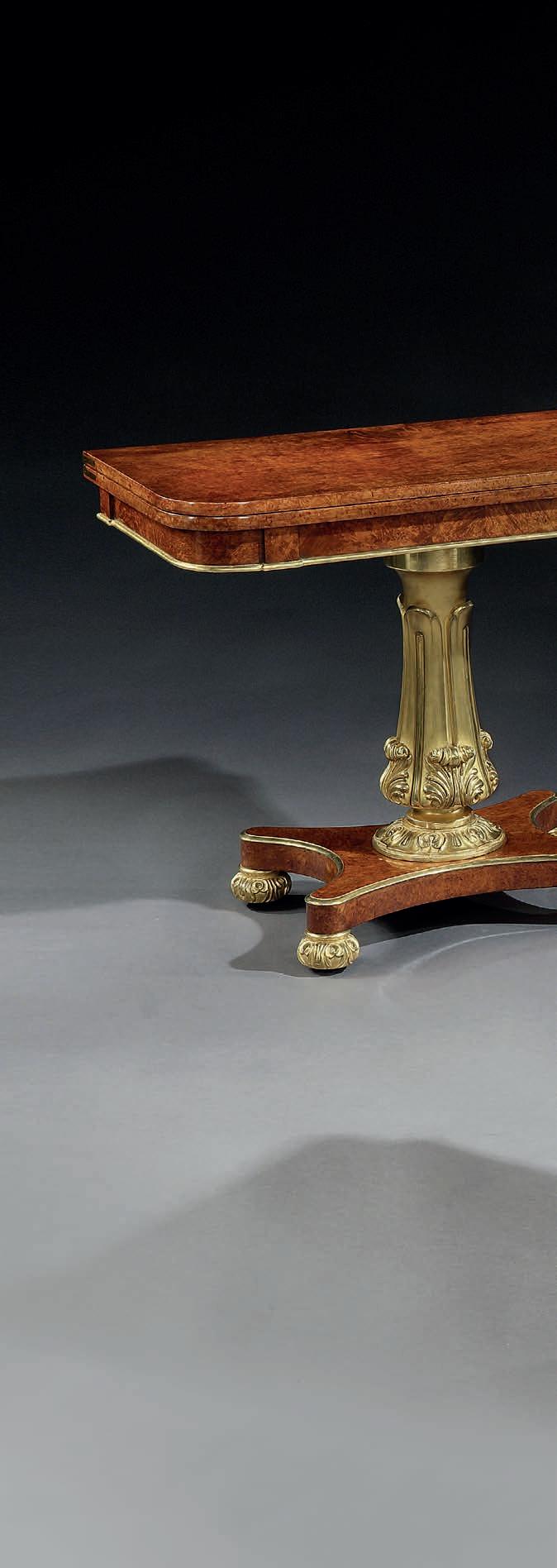
Height: 28¼ in (72 cm)
Width: 35¾ in (91 cm)
Depth: 17¾ in (45 cm)
Morel and Seddons were the principal providers of furniture and furnishings for George IV (1762 - 1830) during his extensive refurbishment of Windsor Castle between 1827 and 1830. These card tables are typical of the extremely high quality furnishings that the company would have supplied.

England, circa 1780
A George III painted padouk and satinwood inlaid demi-lune commode with a finely chased gilt metal moulding to the top painted with ivy leaves, garlands of flowers, a classical urn and foliate motifs. The frieze with oval tablets depicting Roman heads within gilt brass borders and havinga drawer to the centre.

With twin cupboard doors to the front flanked by mock doors to the sides with lattice decoration to the pillars and standing on tapered feet with inlaid flutes and spade feet.
An exquisitely detailed piece of furniture of superlative quality.
Height: 35¼ in (90 cm)
Width: 40¾ in (103.5 cm)
Depth: 18¼ in (46 cm)
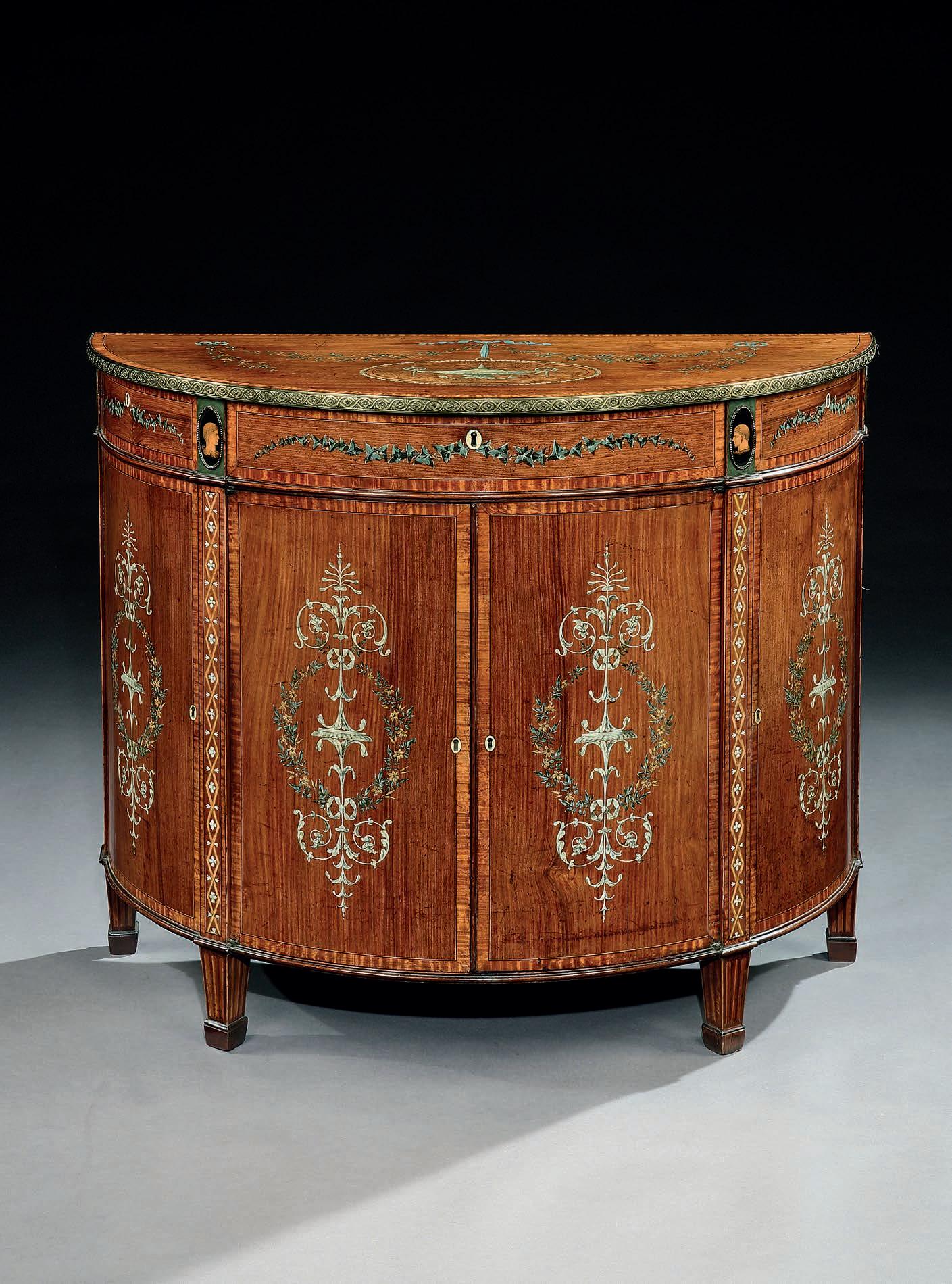
In the manner of George Bullock England, circa 1810
A Regency period mahogany two tiered occasional table in the manner of George Bullock. Of particularly fine quality, with impressive pierced brass galleries to each tier and a single drawer under the lower tier, with ebony inlaid detailing throughout, and standing on bold brass castors.
Height: 35¼ in (89.5 cm)
Width: 26¼ in (67 cm) Depth: 19¾ in (50 cm)
George Bullock (c. 1777 – 1818) was a sculptor and furniture maker of the Regency period working in London and Liverpool. Highly celebrated, he is first recorded in Liverpool in 1804. He initially went into business with William Stokes, and advertised themselves as “Cabinet Makers, General Furnishers and Marble Workers”, trading from a showroom called the “Grecian Rooms” in Bold Street, Liverpool. He moved to London in 1813. His patrons included Queen Charlotte, and the Duke of Atholl at Blair Castle, as well as the Dukes of Buccleuch and Abercorn, James Watt, Matthew Boulton and Sir Walter Scott. He was even commissioned by the British Government to furnish the lodgings of the exiled Napoleon on St. Helena.
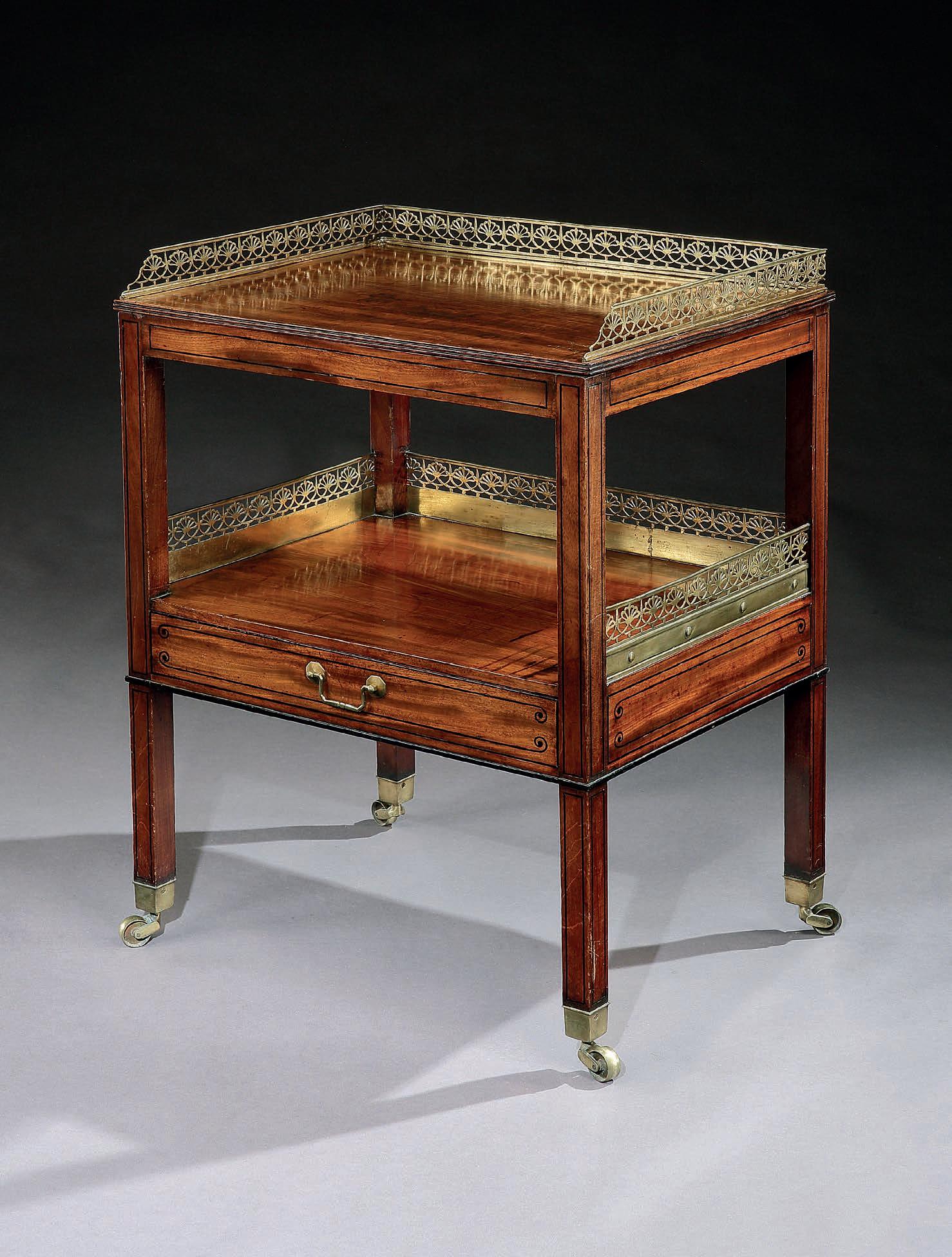
England, circa 1710
An early 18th century Queen Anne period pier mirror with twin plates framed within a border of triple bevelled border glasses held within a carved gilt gesso frame.
Height: 64¼ in (163 cm)
Width: 25¼ in (64 cm)
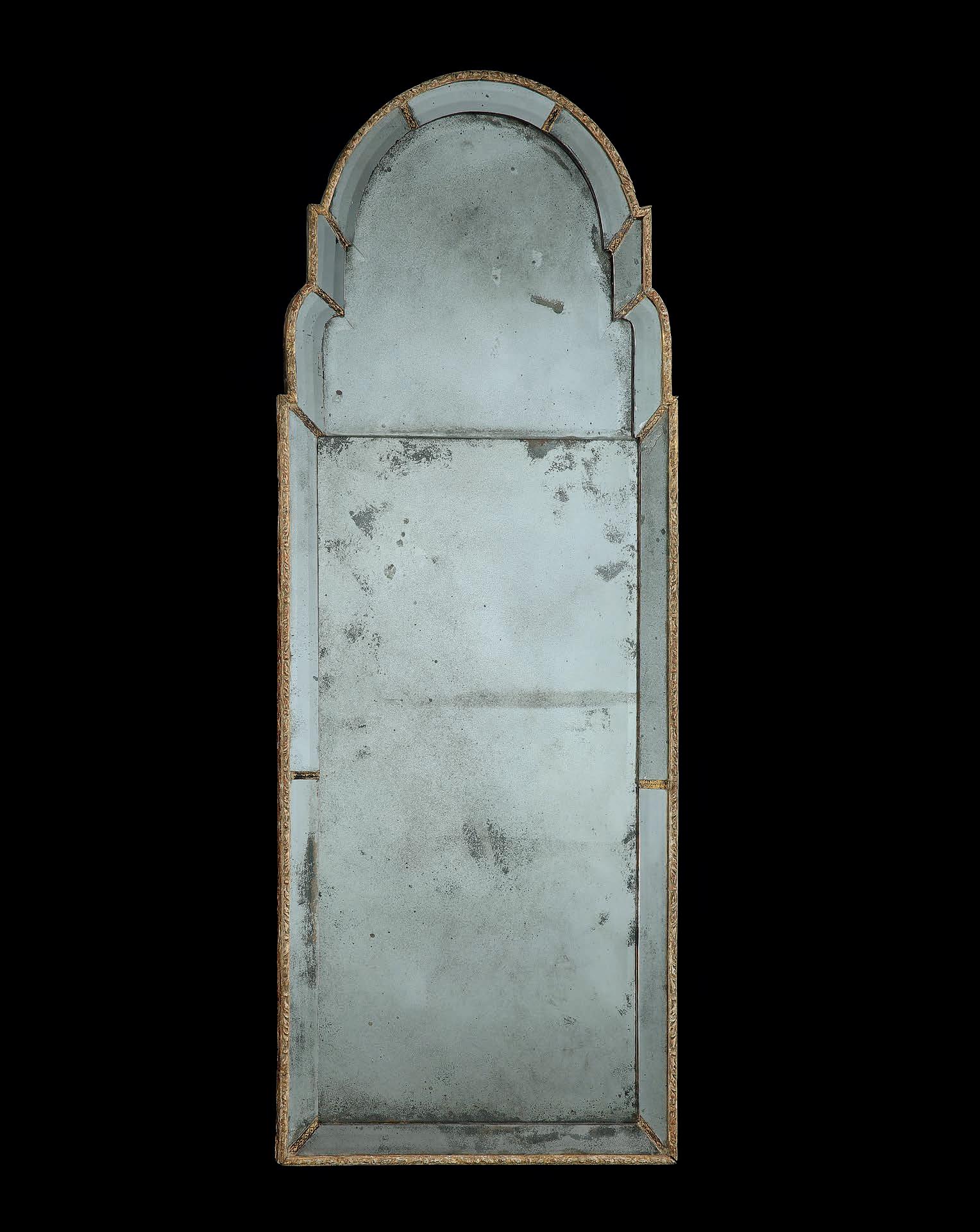
In the manner of Thomas Sheraton England, circa 1780
A George III Sheraton period satinwood console table, with kingwood cross-banding and painted floral decoration, the shaped top above a ebony-strung satinwood breakfront frieze, standing on square tapering legs with spade feet. The whole beautifully decorated with flowers and foliage.

The satinwood particularly well figured and a beautiful colour.
Height:
Width:
Depth:
With Hotspur Ltd., Belgravia Private Collection, UK
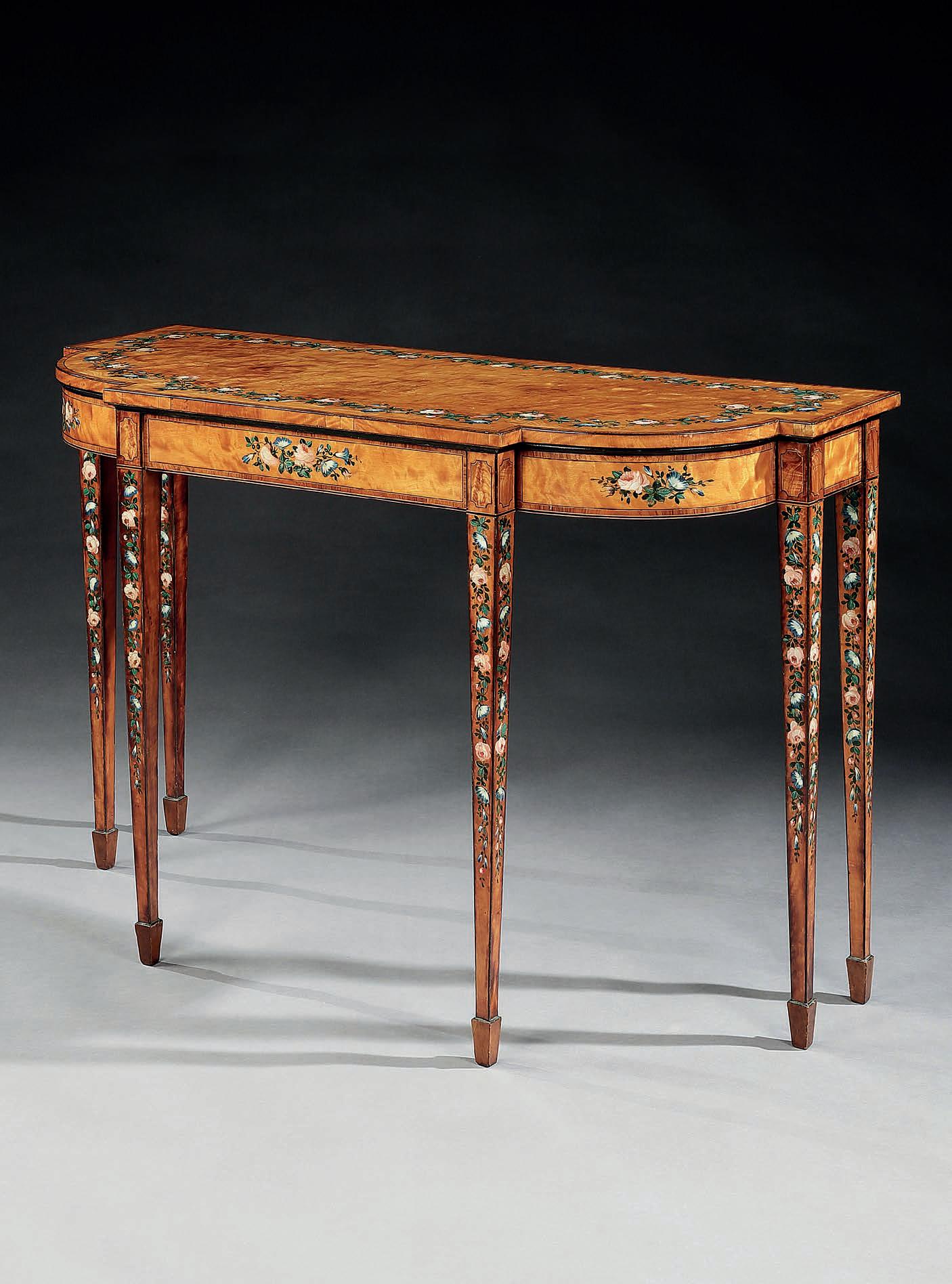
England, circa 1750
A George II carved mahogany armchair, upholstered in 18th century period needlework. The upholstered back of serpentine form, the arms with carved shell scroll terminals above in-curved moulded supports edged with rope carving and acanthus leaf. The seat with serpentine front carved and centred at the front by a ruffle-edge cartouche flanked by acanthus leaves, the sides with complimentary carving. Standing on front cabriole legs headed by shells above pendant leaves and bell-flowers, the toes scrolled and carved with acanthus and rope detailed edge, the rear legs similar.
A superb quality chair with exceptionally crisp carving - the period needlework retaining strong original colours.
Height: 38¾ in (98 cm)
Width: 27¼ in (69 cm)
Depth: 27½ in (70 cm)

In the manner of Thomas Chippendale England, circa 1760
A George III Chippendale period mahogany pedestal desk. With gilt-tooled leather inset top with a leaf carved moulding around the edge, above three frieze drawers on one side and the reverse with a false drawer in the centre, all drawers with rope carved pattern edges, with ormolu handles and escutcheons in the rococo manner, the pedestals with drawers on one side and cupboards the other. With a moulded plinth base and concealed wooden castors.
Of superb quality – the mahogany of excellent colour.
Height: 31½ in (80 cm)
Width: 57½ in (145 cm)
Depth: 35 in (89 cm)
The Grosvenor House Antiques Fair, London 1998
With Mallett & Son (Antiques) Ltd., New Bond Street, London, W1
Literature
Mallett, Annual Catalogue 1999, p. 26 (illustrated)
L. Synge, Mallett Millennium, 1999, p. 21, fig. 11 (illustrated)
Christopher Gilbert, The Life and Works of Thomas Chippendale, 1978, vol. II, p. 236, figs. 431- 432
Ronald Phillips Ltd., The Legacy of Thomas Chippendale, 2018, pp. 104 -111
The form and quality of cabinet work exhibited on this desk are typical of that of the St. Martin’s Lane syndicate of cabinetmakers whose output is epitomised by the leading 18th century furniture designer and manufacturer, Thomas Chippendale. Its configuration, handles and dimensions are similar to those on a library table supplied by Chippendale to William, 5th Earl of Dumfries for Dumfries House, Ayrshire in1759. The pierced gilt-brass rococo handles are a variant of the rococo design frequently used by Chippendale and his contemporaries, although it is unclear whether these were typically sub-contracted to outside suppliers such as William Brent who was based nearby in St. Martin’s Lane. Closely related handles can also be seen on a documented Chippendale commode supplied to Goldsborough Hall, Yorkshire.
Thomas Chippendale’s account, on 5 May 1759, describes the Dumfries House desk as: ‘a Mahogany Library-Table of very fine wood the top cover’d wt. best black leather, a Writing drawer at one End wt. a double rising slider cover’d, & drawers & Cupboards in the sides & strong triple castors £22 —’. A related desk, without the carved moulded edges and detailed beading on the drawers,was sold Christies London, Important English Furniture, 3 July 1997, lot 50.
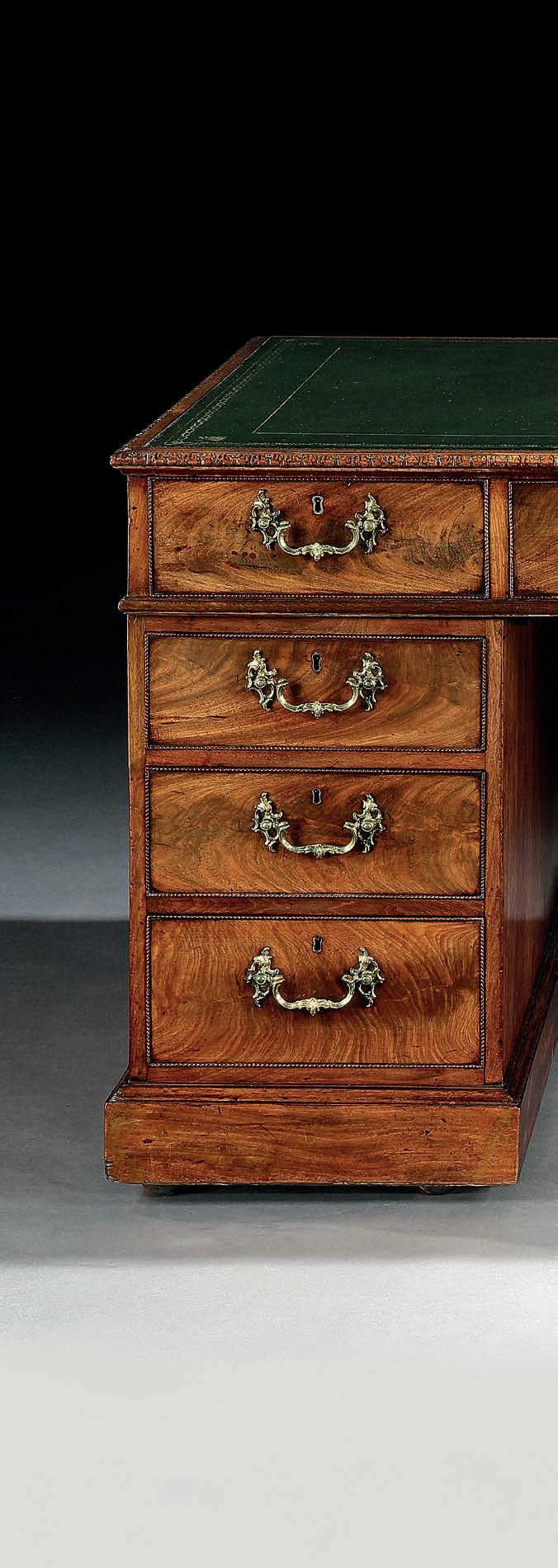
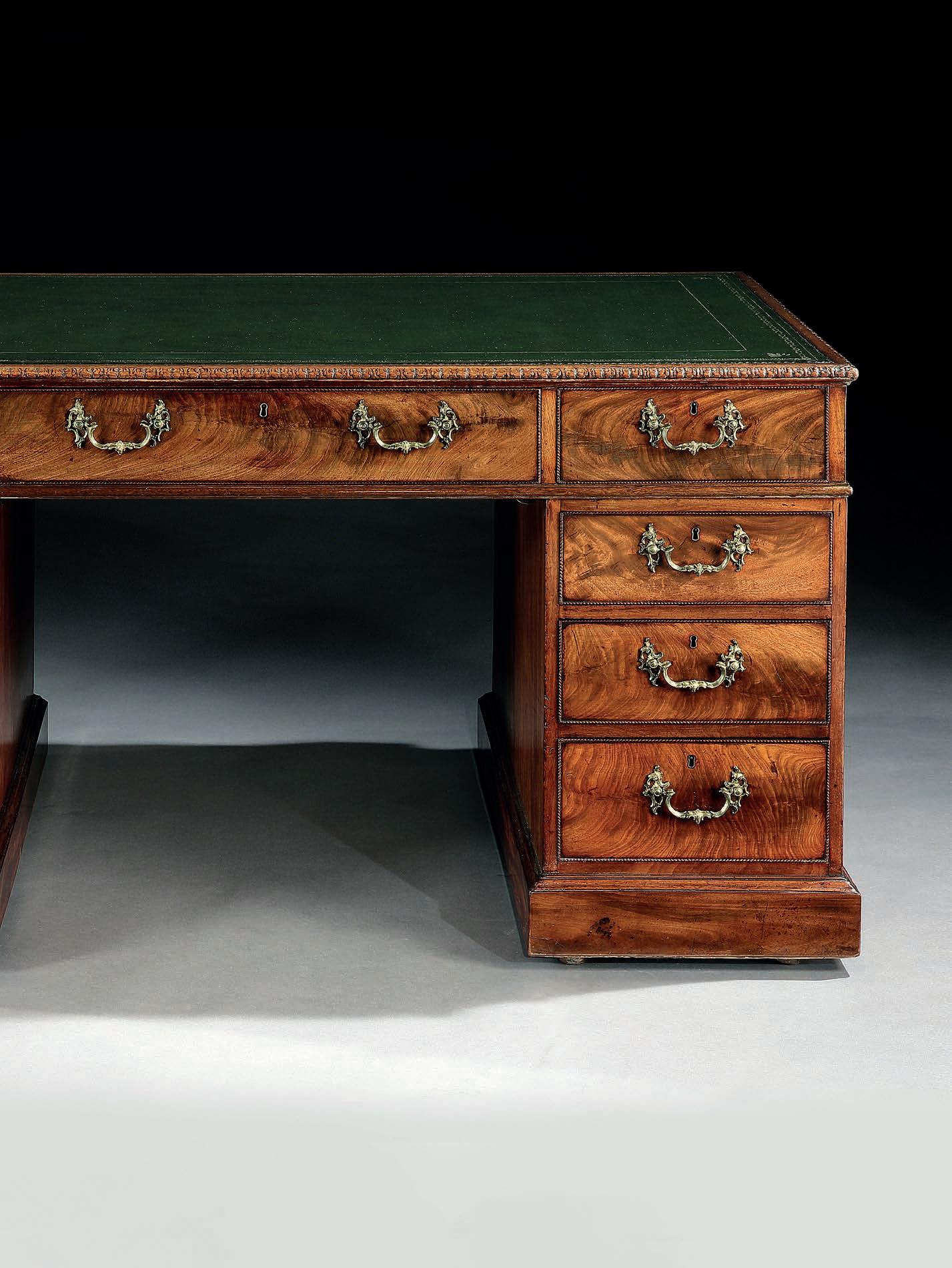
Attributed to the Roberts Family England, circa 1715
A set of four George I walnut and seaweed marquetry side chairs attributed to Royal chairmakers Thomas or Richard Roberts, each with an arched upholstered and close-nailed back and seat, on shaped cabriole legs with square hoof feet, the legs and circular panel to the front seat rail beautifully inlaid with seaweed marquetry decoration. A wonderful set of chairs.
Height: 43¼ in (110 cm)
Width: 23 in (60 cm)
Depth: 25¾ in (65.5 cm)
With Charles of London and New York (the pseudonym for Charles Joel Duveen. He described them as ‘the Hampton Court Chairs’)
Gifted by Mrs Leonard A. Cohn to the Metropolitan Museum of Art, New York, 1945
The collections of the Metropolitan Museum of Art, New York
Literature:
‘Recent Accessions of European Decorative Arts’, Metropolitan Museum of Art Bulletin, vol. 6, no. 8, April 1948, p. 227
Comparative Literature:
A. Bowett, Early Georgian Furniture 1715-1740, pl. 4.19, 4.53-54
G. Beard and J. Cross, ‘Thomas and Richard Roberts’, Apollo, September 1998, pp. 46-48
G. Beard, Upholsterers and Interior Furnishing in England 1530 –1840, London 1997, p. 149, fig. 167
These chairs relate very closely to those supplied by Thomas Roberts to Sir Robert Walpole, later 1st Earl of Orford (d. 1745) for Houghton Hall, Norfolk, with similar shaped cabriole legs ending in stylised hoof feet. Two pairs of chairs from Houghton were sold Christie’s London, 8th December 1994, lots 126 and 127. Thomas and Richard Roberts both held the warrant as ‘joiner to the Royal Household’ for over thirty years, from 1686 until 1729, and supplied furnishings for Whitehall, Kensington Palace, Hampton Court and Windsor Castle.
With their similar central inlaid cartouche to the front seat-rail, a suite of furniture traditionally ascribed to the workshops of John Belchier and supplied to Streatlam Castle Durham is worth comparison. Belchier is particularly known for his work at Erdigg Hall, Wrexham for which he supplied the finest quality ‘mirror glasses, cabinet works and chairs’.
Three related pairs of chairs, commissioned by Sir John Trevor (c.1637-1717) for Trevor House, later Powis House, Knightsbridge and then removed in the mid 18th century to Brynkinalt, Denbighshire, were sold Sotheby’s London, Of Royal and Noble Descent, 19 January 2017, lots 333 – 335. These chairs show near identical construction, similar inlaid marquetry panels and near identical feet. A further set of walnut and marquetry chairs featuring a similar leg pattern and hoof foot was supplied to Thomas Watson-Wentworth, 3rd Earl of Stafford for Wentworth Woodhouse, Yorkshire

An important George II walnut bureau of rare small proportions, signed and dated by its maker.
The interior fitted with eleven variously sized drawers with curved facings and a shaped writing panel inset with old green silk-velvet, enclosed by a sloping flap with matched veneers and chevron bandings. The lower part with two long drawers and two short drawers below a long drawer with a hinged drop-front which encloses a removable walnut tray with various shaped compartments. All the drawers have oak linings, chevron bandings, cock-beaded edges and original oval brass escutcheons and ring and disc handles. The straight-grained sides fitted with brass carrying handles, mounted on bracket feet. The walnut of wonderful finely patinated golden brown colour.
Height: 36¼ in 92 cm)
Width: 24 in (61 cm)
Depth: 13¾ in (35 cm)
With Frank Partridge, 1934
With H. M. Lee, 1938, when purchased by the family
Thence by descent
Literature
Adam Bowett, Early Georgian Furniture 1715 - 1740, p. 40, pl. 1.29 (illustrated)
Connoisseur, May 1934 (illustrated, advertised with Frank Partridge & Sons, Ltd.)
Apollo, October 1938 (illustrated, advertised with H. M. Lee & Sons)
This exceptional desk was made by a German craftsman called John George Troetser working in Maiden Lane in the workshops of Robert Hyde. An inscription on the base of the upper drawer in German roughly translates as: ‘John George Troetser, of a foreign country, joiner’s assistant to master Heid in Maiden Lane, London, made this desk, March 9th 1732’. As Adam Bowett points out: ‘it is typically English in style and construction, and were it not for the inscription, its German maker would have remained unsuspected. Pieces like this go a long way to explaining the strong stylistic and technical affinity between English cabinet-work and some contemporary German work’.
The master Heid in Maiden Lane is almost certainly Robert Hyde (or Hide) of Maiden Lane, Covent Garden, recorded in London polling lists and contemporary advertisements between 1744 and 1749.
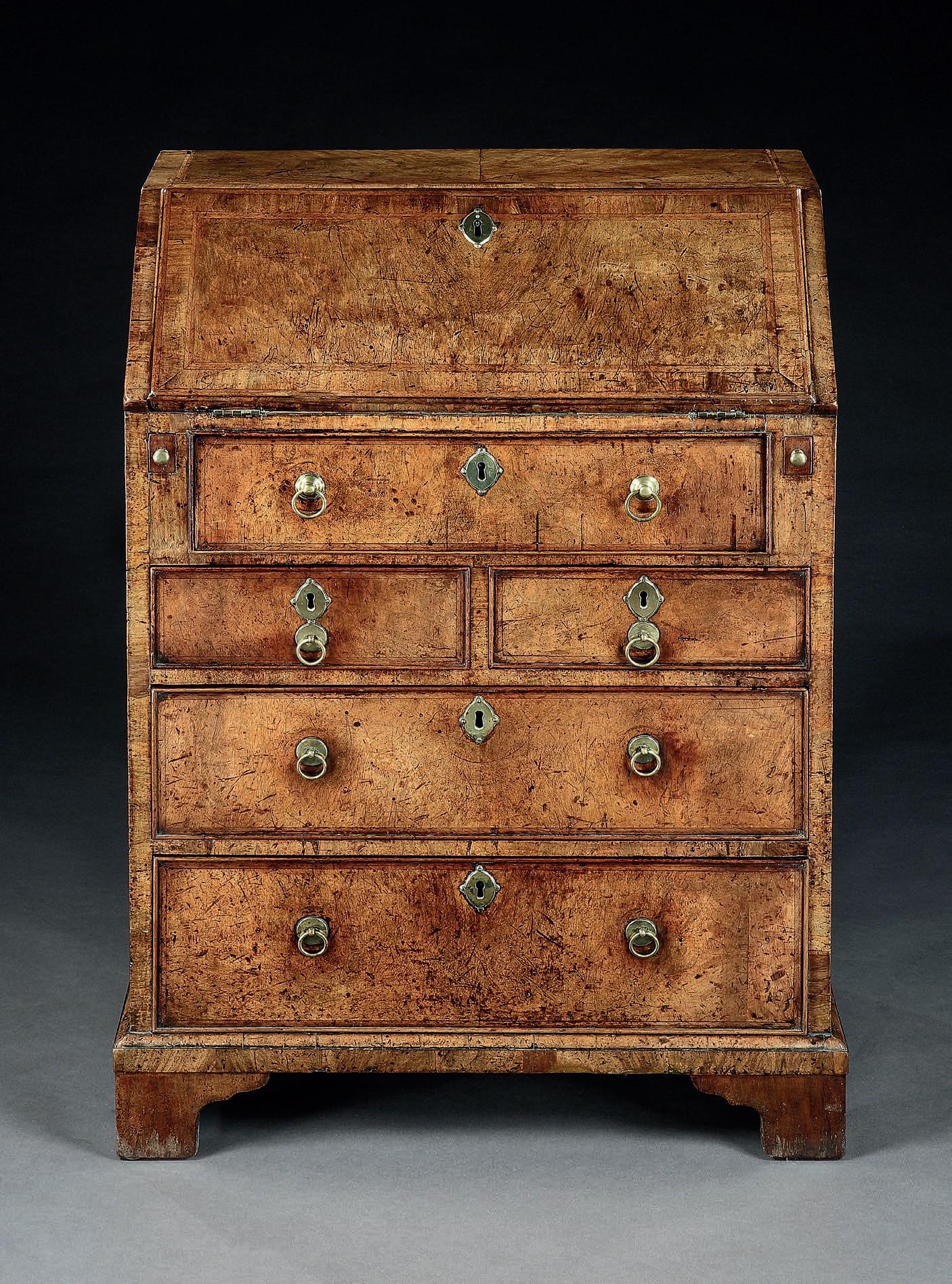
England, circa 1710
A Queen Anne green and gilt chinoiserie japanned pier mirror. The pierced cresting and cushion frame with particularly fine gilded chinoiserie decoration on a rare green japanned background. The original divided mirror plates with bevelled edges.
Height: 60 in (152.5 cm)
Width: 22½ in (57 cm)
With Norman Adams, London, October 1972
Private Collection UK
With Ronald Phillips, London, 2007 Private Collection UK
Literature
C. Claxton Stevens and S. Whittington, 18th Century English Furniture - The Norman Adams Collection, Woodbridge, 1985, p. 412 (illustrated)
Ronald Phillips, Antique English Furniture 2007, p. 244 (illustrated)
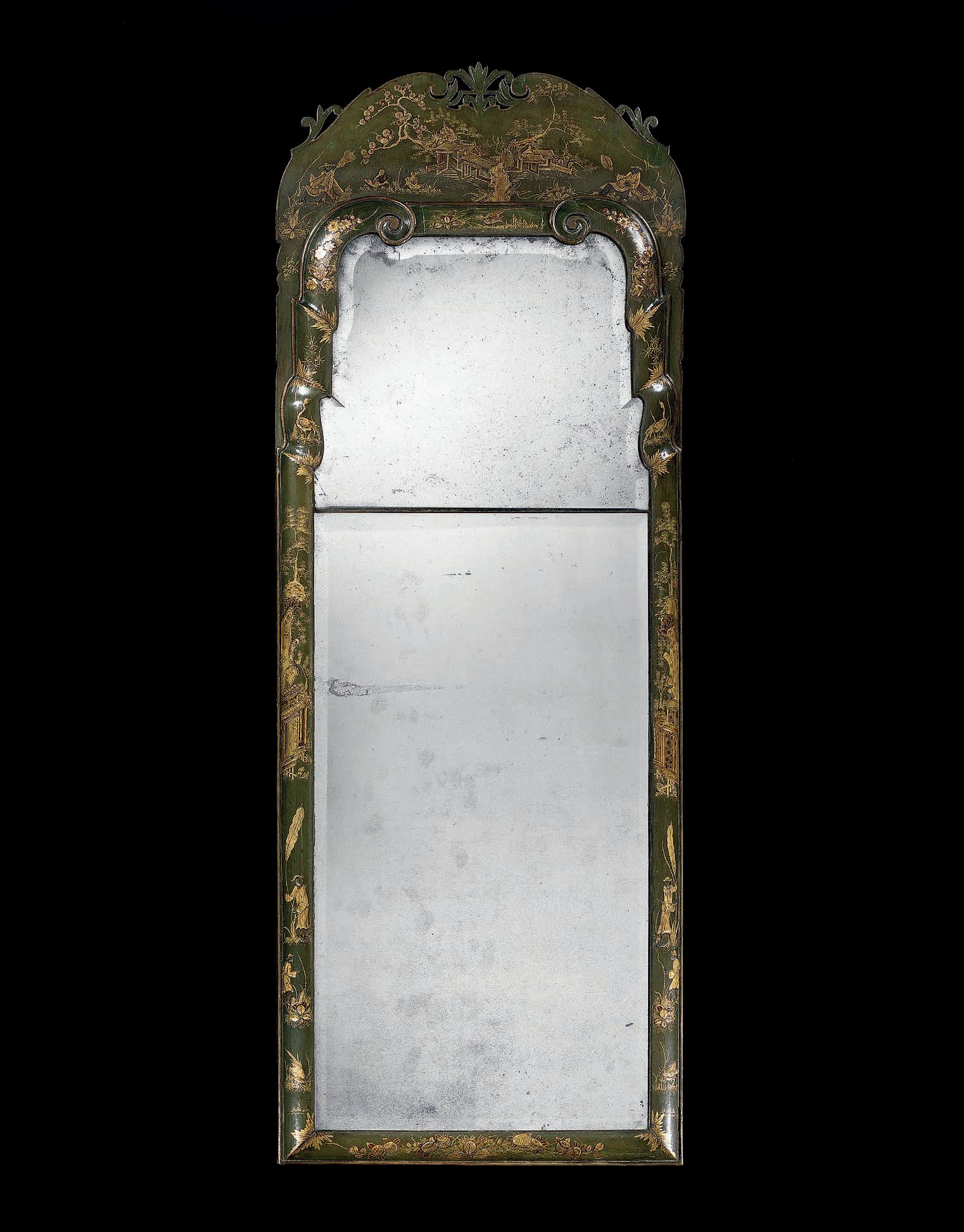
Possibly by the St. Martin’s Lane Syndicate England, circa 1750
A George II walnut library armchair of very generous proportions, with a serpentine shaped upholstered back, the arm-rests and straight-fronted seat similarly upholstered, the arm-supports slightly channelled, with superb acanthus carved cabriole legs with scrolled feet to the front, with leather castors, the back legs outswept.
The walnut with particularly fine colour and patina.
Height: 40 in (102 cm)
Width: 31 in (79 cm)
Depth: 31 in (79 cm)
This superb armchair, with its distinctive leg pattern, relates very closely to a suite of seat furniture supplied to the 2nd Earl Poulett (d. 1764) for Hinton House, Somerset. Several leading London craftsmen were involved in the commission for Hinton, probably working under the direction of the architect Matthew Brettingham. These included Matthias Lock, Giles Grendey and Thomas Chippendale. However, the suite is most commonly associated with the work ofWilliam Vile (d.1767) and John Cobb (d.1778), later Royal cabinet-makers to George III, who formed a powerful syndicate with William Hallett (d.1781) in St. Martin’s Lane from 1753.
An armchair of identical pattern and presumably the pair to the present lot was with Frank Partridge & Son, illustrated in Connoisseur, June 1949.
The Royal cabinetmakers Vile and Cobb and their precise links with William Hallett have been the subject of much speculation and research but the documentary evidence is fragmentary at best. A letter from William Vile to George Selwyn, dated the 10th of August 1749, refers to Hallett as Vile’s “master” but further proof of an apprenticeship has not yet been uncovered. It is known that when Vile and John Cobb began their partnership, they turned in some way to Hallett for financial backing. According to the British and Irish Furniture Makers Online project, from 1756 Vile and Cobb were paying around £150£300 to Hallett on a near monthly basis. By this stage Hallett had officially retired from business a very wealthy man and one of the small group of cabinetmakers to have advanced his social standing as a result of success in the trade. He was able to “become a gentleman” and purchased the extensive Cannons estate - including the shell of the marvellous house originally built for the Duke of Chandos between 1713 and 1724. Hallett was painted by Thomas Gainsborough and Francis Hayman.
It is perhaps unsurprising given the close links between the two firms that furniture produced by the various members of the St Martin’s Lane Syndicate is difficult to attribute precisely. Quite when Hallett ceased his involvement as an active designer and craftsman and Vile and Cobb took over remains unknown. What is clear is that the work created by these different iterations of a firm that probably continued to use many of the same master carvers and polishers etc. is all defined by a meticulous eye for detail, the most refined use of carving and the employment of only the finest timbers. Although the nearby St Martin’s Lane workshop of Thomas Chippendale may have the greater name recognition nowadays, Hallett, Vile and Cobb produced furniture of comparable quality and, unlike Chippendale, they were involved in countless Royal commissions.
Other great commissions included furnishings for St Giles House, Dorset- in particular the celebrated suite of armchairs with carved detail of exquisite quality that stand out as masterpieces of English furniture, as well as work at Rousham, Holkham and Badminton carried out by Hallett. In addition to their work for the Royal family, Vile and Cobb worked at Croome Court, Boynton Hall, Uppark, Corsham Court, Audley End and Petworth to name but a few of the most famous houses at which they worked.

In the manner of Sir William Chambers England, circa 1760
A George III mahogany and parcel-gilt Chinese Chippendale period side chair of rare form,with lattice-work back, the pierced frame also carved with panels of flowers and chinoiserie blind-fretwork throughout, with parcel-gilding to the raised details, standing on simulated bamboo legs with cross-stretchers similarly decorated, with a drop-in upholstered seat.
Height: 36¼ in (92 cm)
Width: 22 in (56 cm)
Depth: 22¾ in (58 cm)
Sir William Chambers was an influential and talented designer and architect. The son of a Scottish merchant, he was born in Sweden and made three voyages to China between 1740 and 1749 with the Swedish East India Company, taking the opportunity to study Chinese furniture and design. There had been a vogue for all things Chinese for some time; Stalker and Parker’s 1688 Treatise of Japanning and Varnishing - a manual for applying japanned decoration to furniture in imitation of lacquer had been so influential a generation before.
Chambers was one of the first European connoisseurs to visit China and he made records of what he saw, as well as simultaneously producing a whole series of his own designs.
Chambers was an exceptionally talented draughtsman, a skill that allowed him to become perfect conduit for bringing a taste of the Orient back to Europe. He published his first book, Designs of Chinese buildings, furniture, dresses, machines, and utensils, in London in 1757 in both English and French. The book was hugely influential and was dedicated to the future George III with whom Chambers was to form a successful working relationship.

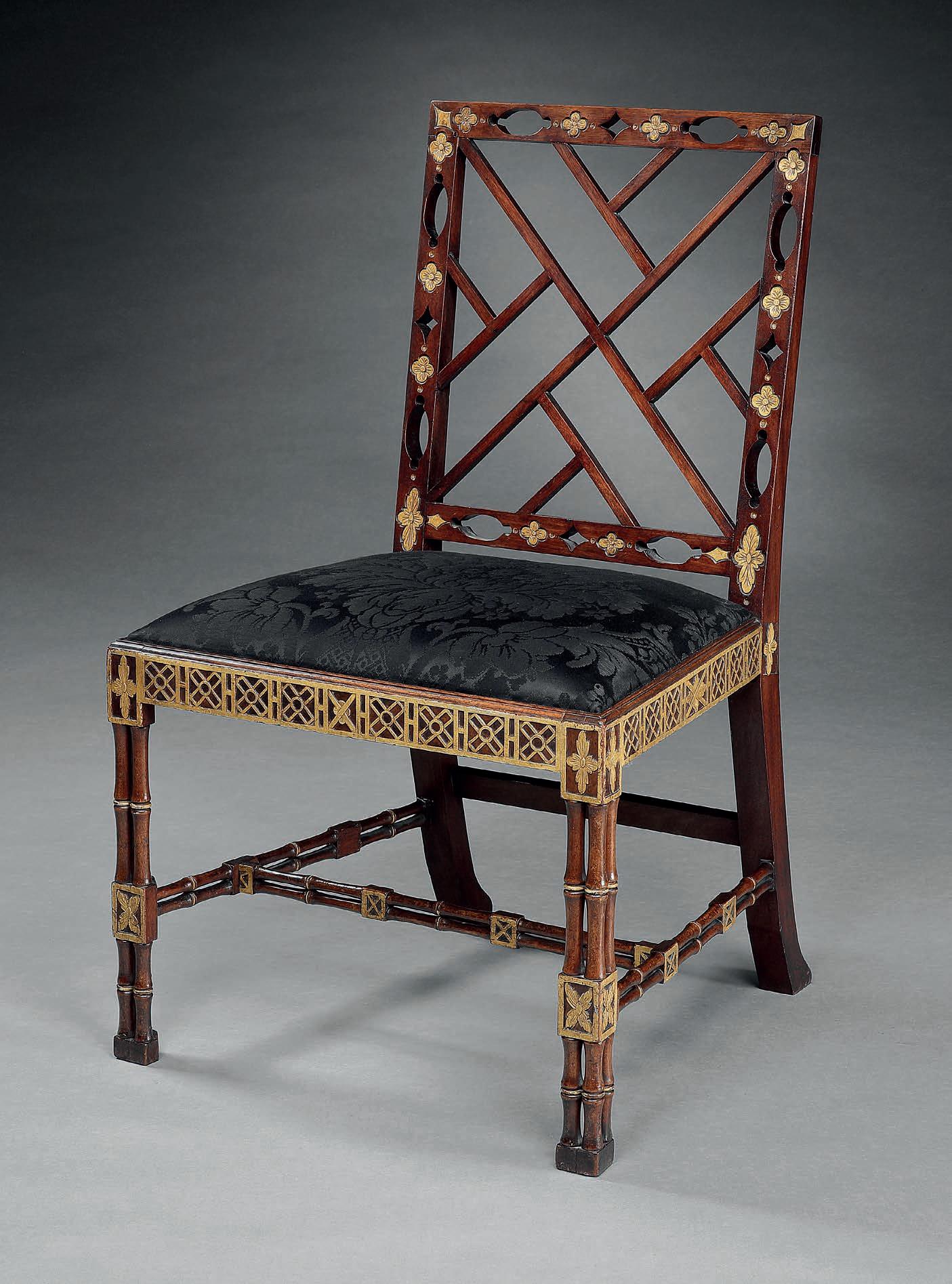
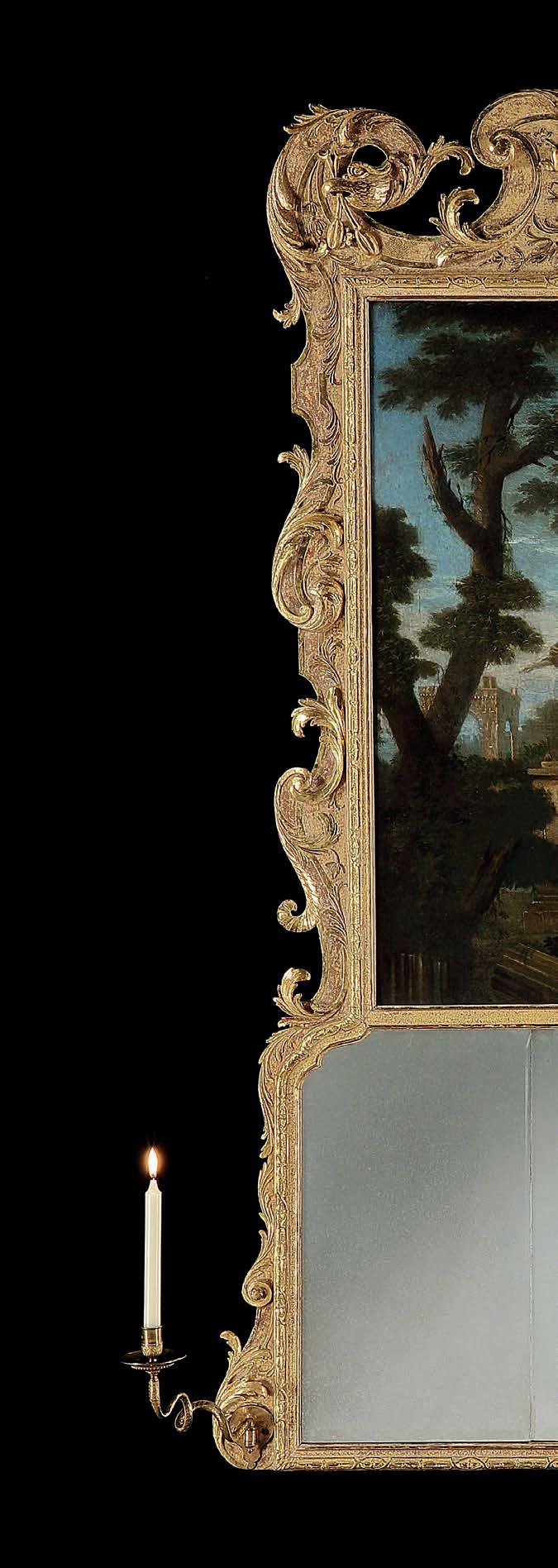
England, circa 1730
An exceptional George II carved gilt gesso and giltwood overmantel mirror. Of impressive proportions, the carved frame surmounted by a double shell cresting flanked by a pair of scrolling eagle heads. The whole frame carved with wonderful scrolling acanthus leaves and further detailed with floral, foliate and linear strapwork on a double punched background of the finest quality. The frame inset with a classical oil painting above a bevelled edge triple plate horizontal mirror. With outstanding brass candle arms.
The oil on canvas Roman School, 18th century – A capriccio of Roman ruins with a soldier and dog in the foreground.
Height: 72 in (183 cm)
Width: 66 in (168 cm)
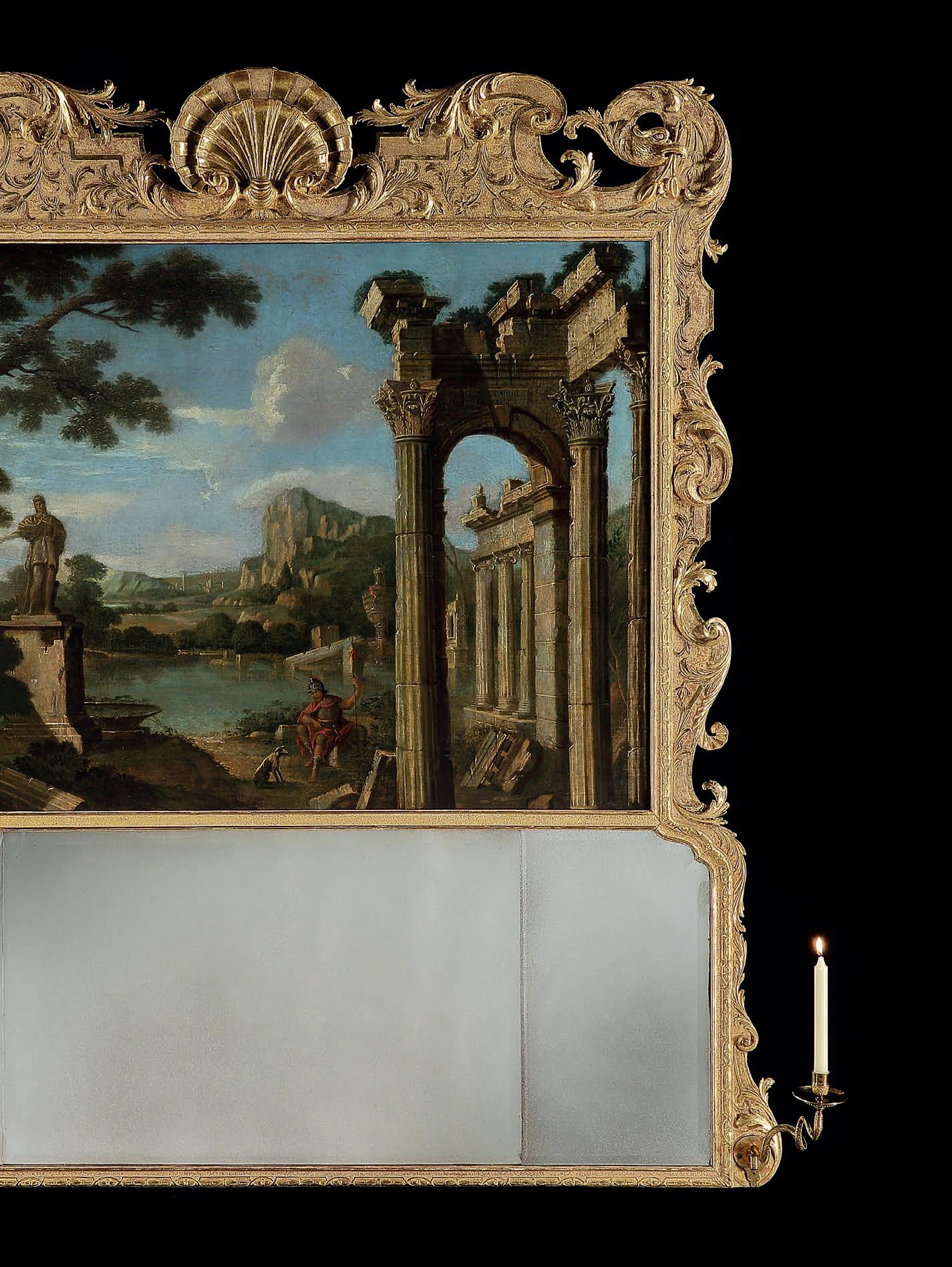
A George III Chippendale “Director” period mahogany side chair with excellent colour and patina, the back splat superbly carved throughout with exaggerated C-scrolls and acanthus leaves extending into the serpentine shaped top rail, with a proliferation of carved harebells down the side supports, the chamfered moulded legs joined by an H-stretcher, the seat upholstered.
Height: 38¼ in (97 cm)
Width: 22½ in (57 cm)
Depth: 18½ in (46 cm)
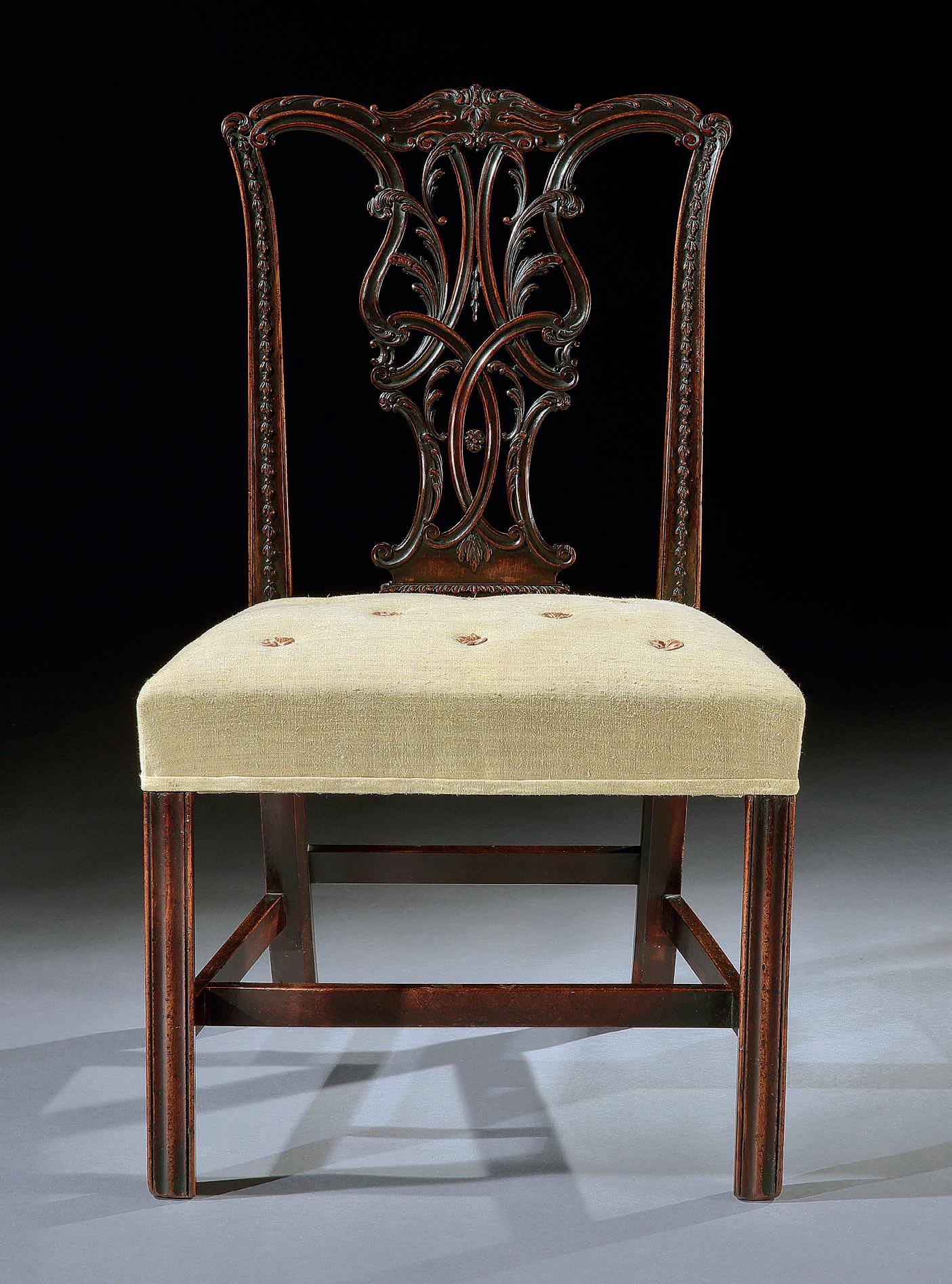
England, circa 1770
A George III Chippendale period mahogany secretaire cheston-chest. The moulded dentil cornice and blind fretwork frieze above an upper section with two short drawers and three long drawers flanked by stop-fluted pilaster columns, the lower section with a secretaire drawer enclosing a serpentine chequerinlaid fitted interior of small drawers and pigeon holes arranged around a central door,above two long drawers, standing on ogee bracket feet. The drawers with brass swan neck handles.

Fantastic colour and superb mahogany veneers.
Height: 78¼ in (199 cm)
Width: 45½ in (115.5 cm)
Depth: 23¼ in (59 cm)
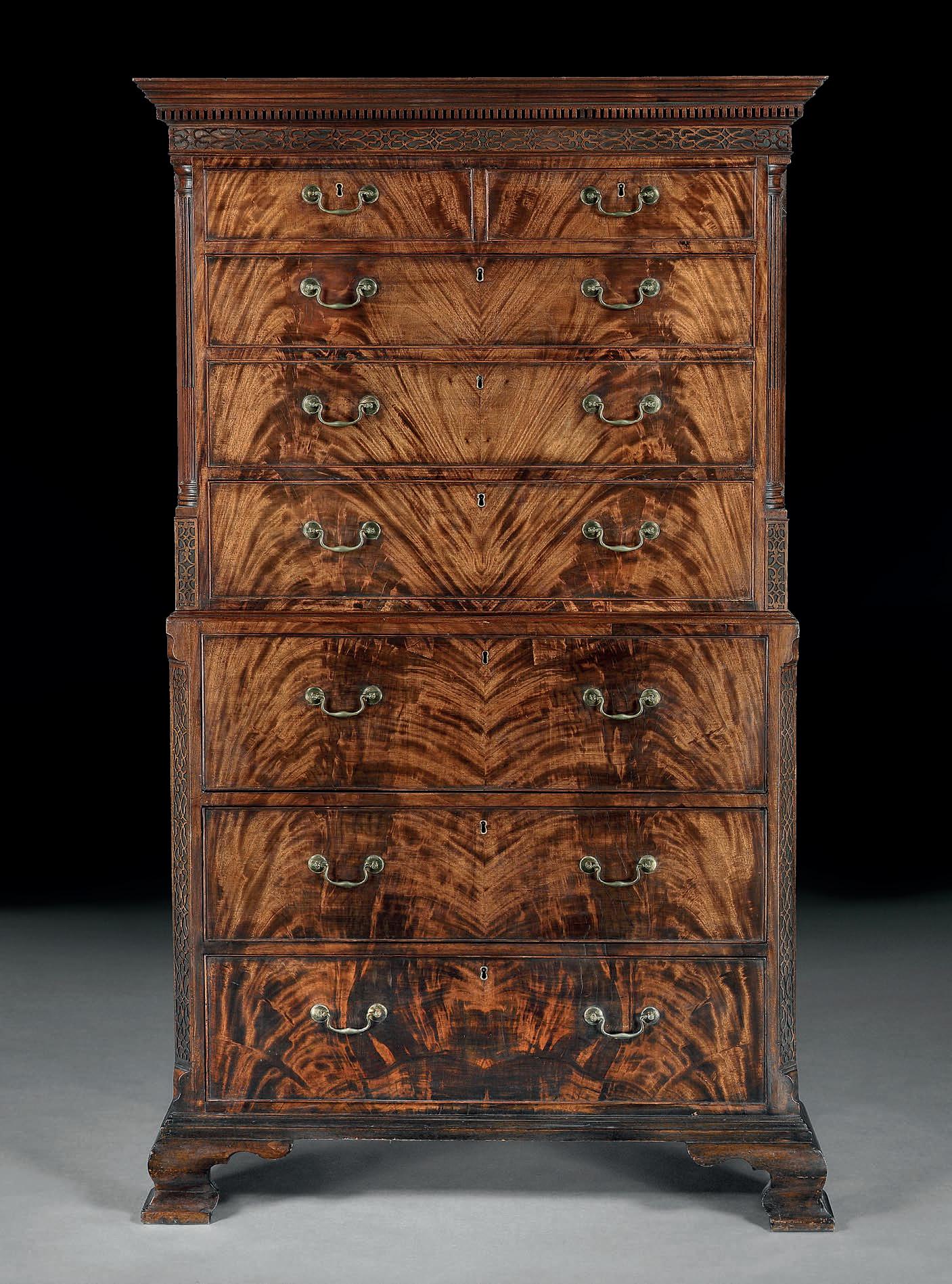
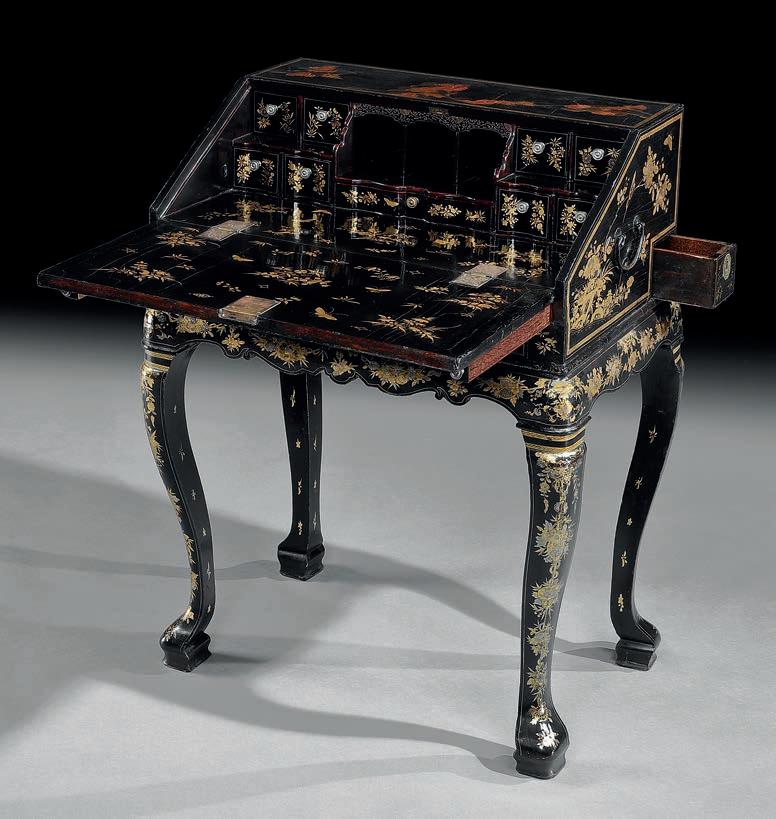
China, mid 18th century
A mid 18th century Chinese Export lacquer bureau on stand, probably made in Canton specifically for the export trade to meet the demands of the European market. Beautifully decorated throughout with gilded decorations on a black lacquer background. The writing section is fitted with double serpentine fronted drawers and pigeon-holes - all profusely decorated with gilded sprigs of flowers, foliage and butterflies. The apron frieze contains three working drawers, the central drawer arcaded. With a small pull out pen drawers hidden in one side, and with carrying handles. The fall-front and top are decorated with lacquer work depicting romantic landscapes typical of the period. Raised on cabriole legs all beautifully decorated and detailed. The engraved metal mounts most likely paktong.
Height: 37 in (94 cm)
Width: 28¼ in (72 cm)
Depth: 18½ in (47 cm)
Provenance: With Marchant Ltd., Kensington
Literature:
Judith Miller, Furniture – World Styles From Classical to Contemporary, Dorling Kindersley, 2005, p. 208 (illustrated)

A magnificent pair of Empire giltwood fauteuils by FrançoisHonoreé-Georges Jacob-Desmalter (1770-1841). From the Tuileries Palace - with Tuileries inventory stamps from the Restauration period. Each giltwood armchair finely carved with raised stylised acanthus, laurel leaf, flowerhead, anthemion and lotus-leaf ornament, with conformingopposing shaped and scroll carved arm terminals and front legs, on splayed square section rear legs. Each fauteuil stamped ‘T.H.’ along with the Tuileries fleur-de-lys stamp. One stamped ‘IACOB’.
Height: 39¼ in (100 cm)
Width: 26¼ in (67 cm)
Depth: 20½ in (52 cm)
Probably supplied to the Grand Salon of the apartment of la duchesse de Serrent at the Palais des Tuileries
D. Ledoux-Lebard, Le Mobilier Français du XIX Siècle, Paris, 1989
S. Grandjean, Empire Furniture 1800 - 1825, London, 1966
J-P. Samoyault, Le Mobilier du General Moreau, Un Ameublement à la mode en 1802, Paris, 1992 M. Jarry, Le Sièege Français de Louis XIII à Napoléon III, Paris
The ‘Iacob’ stamp on these chairs is documented as being used by Jacob-Desmalter during the period 1813-1825. However, a comparable fauteuil, dated 1809, formed part of a giltwood suite that Jacob-Desmalter supplied for the primary drawing room at Compeigne on behalf of Empress Josephine. Another similar armchair attributed to the Jacob brothers was supplied to Madame Bonaparte for the chateau de Saint-Cloud, with comparable arm terminals and front legs (illustrated in J-P. Samoyault, Le Mobilier du General Moreau, fig. 30a, p. 38). Of various related armchairs, the one with perhaps the closest type of raised top rail ornament features in Le Sièege Français de Louis XIII à Napoléon III, fig. 69, pls. 25 & 27. A pair of fauteuils with similar arm terminals and virtually identical front legs was sold Christie’s Paris, Important Mobilier et Objets d’Art. 16 December 2008, lot 293. The latter pair, bearing the stamps for Jacob-Desmalter, have scrolled backs with practically non-existent top rails, while the tablets surmounting our armchairs are more decorative. However, significantly, the raised ornament on the seat frame of the Paris model closely relates in design to our top rails.
An example with conforming characteristics to the Paris pair and by thus by extention to our fauteuils, sold Sotheby’s Paris, 18 March 2010 from the collection of Violette de Tallyrand, Duchesse de Sagan, lot 106. This is stamped ‘Jacob D/R Meslee’ which is recorded as widely being used by the Jacob brothers in the period 1803-1813. This chair was originally supplied for the chateau d’Eu in Normandy, the summer residence of Louis Philippe - in itself closely related to a set of seat furniture supplied for the Emperor Napoleon’s bedroom at Compeigne.
Georges Jacob (1739-1814), renowned cabinet-maker active during the late 18th century, sold his business in 1796 to his two sons, who then renamed the firm Jacob Frères. The Jacob brothers, George II (1768 - 1803) and François-HonoréGeorges, produced furniture directly inspired by Greek, Etruscan and Roman antiquity following the fashionable neoclassical taste of the period established by Charles Percier and Pierre François Léonard Fontaine in their 1801 publication, Recueil des Décorations Intérieures
François-Honoré-Georges, who added Desmalter to his family surname in 1803, provided over 330 pieces for Napoléon’s coronation including most importantly the imperial throne in advance of Napoleon’s coronation, which took place the following year. Throughout the reign of Napoléon (1804-1815), Jacob-Desmalter was the predominant and favoured cabinetmaker to the Imperial Garde-Meuble, responsible for supplying furnishings at Fontainebleu, Grand Trianon, Saint-Cloud, Rambouillet and of course the Tuileries. Between 1803 and 1813, the cost of works supplied by Jacob-Desmalter for the Palais des Tuileries alone amounted to 541,765 francs.
Bonne Marie Félicité Montmorency-Luxembourg (1739 - 1823) married Armand Louis, duc de Serrent. She was …dame d’atours (responsible for the wardrobe) of Mme Élisabeth and then companion to Marie-Therese Charlotte de France (madame royale) first daughter of Marie-Antoinette and Louis XVI who married Louis Antoine d’Artois, duc d’Angoulême eldest son of the future Charles X.
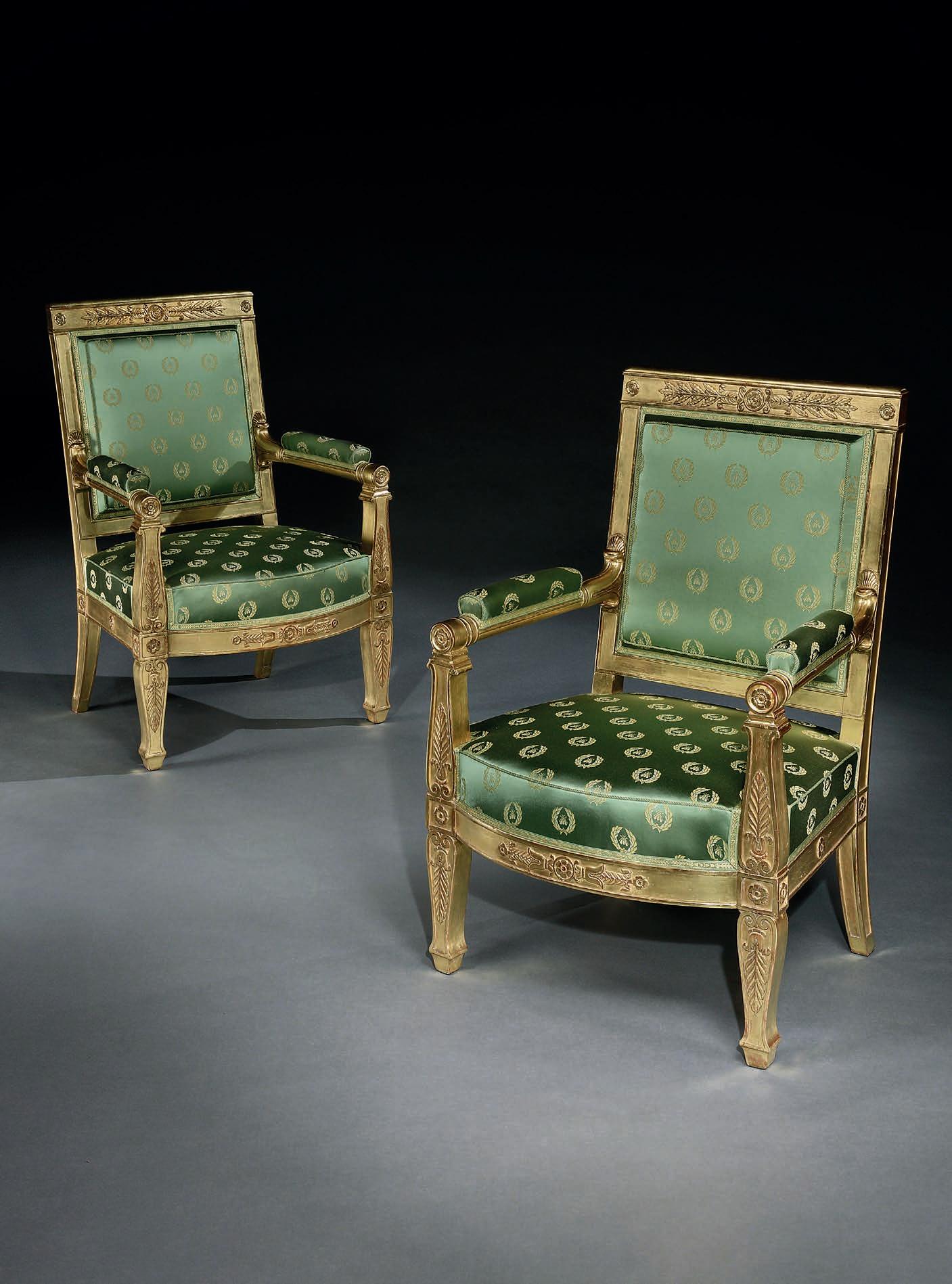
Attributed to John McLean England, circa 1810
A pair of Regency period rosewood and brass inlaid side cabinets attributed to John McLean (1770 – 1825). The cabinets, of rectilinear form with curved out-set canted corners and impressive finely chased ormolu mounts to the shoulders, the frieze with two drawers inlaid with brasswork and a central brass bordered ormolu mask, with a pair of cupboard doors similarly impressively decorated opening to reveal an interior cupboard space. Supported on finely carved lions paw feet to the front and turned rear toupie feet. Each cabinet is surmounted by a twin shelf mirrored gallery, with pierced brass and pillared sides.
A rare pair of cabinets – of particularly fine quality.
Height: 56½ in (143.5 cm)
Width: 43½ in (110.5 cm)
Depth: 17½ in (44.5 cm)
The firm, John McLean and Son, highly influenced by the neoclassical style promoted favoured by the court of Louis XVI, was cabinet-makers of the highest calibre and patronised by leading connoisseurs of the time including the 5th Earl of Jersey, for whom they worked extensively at Middleton Park, Oxfordshire and in Berkeley Square, London. Examples of McLean’s work can be found in the Victoria & Albert Museum in London and in the National Trust collections, in particular in the library at Saltram, Devon.

Probably by Henry Hill of Marlborough England, circa 1770
An exceptional George III mahogany serpentine commode attributed to Henry Hill of Marlborough. The exaggerated serpentine top with an inverted superstructure with two panelled doors opening to reveal a fitted interior of drawers and pigeon holes. The top of main commode extending to form a convenient writing surface. Below an arrangement of four graduated serpentine drawers fitted with their original gilt brass swan neck handles. The lower shaped apron unites the extravagantly outswept feet.
Height: 43 in (109 cm)
Width: 42 in (105 cm)
Depth: 24 in (60 cm)
With Jeremy Ltd., Belgravia
Private Collection UK
With Apter Fredericks, London Private Collection, UK
Comparative Literature
Lucy Wood, The Lady Lever Art Gallery - Catalogue of Commodes, pp. 71-72, pl. 56-58
A highly sophisticated piece of furniture of superb quality, with excellent figuring to the mahogany, fine choice of veneers and wonderful colour and patinathroughout. Although this commode follows the traditional designs attributed to Henry Hill of Marlborough, the exaggerated form and the incorporation of the superstructure make this most likely a unique commission - both in terms of quality of craftsmanship and overall, otherwise unrecorded, design.
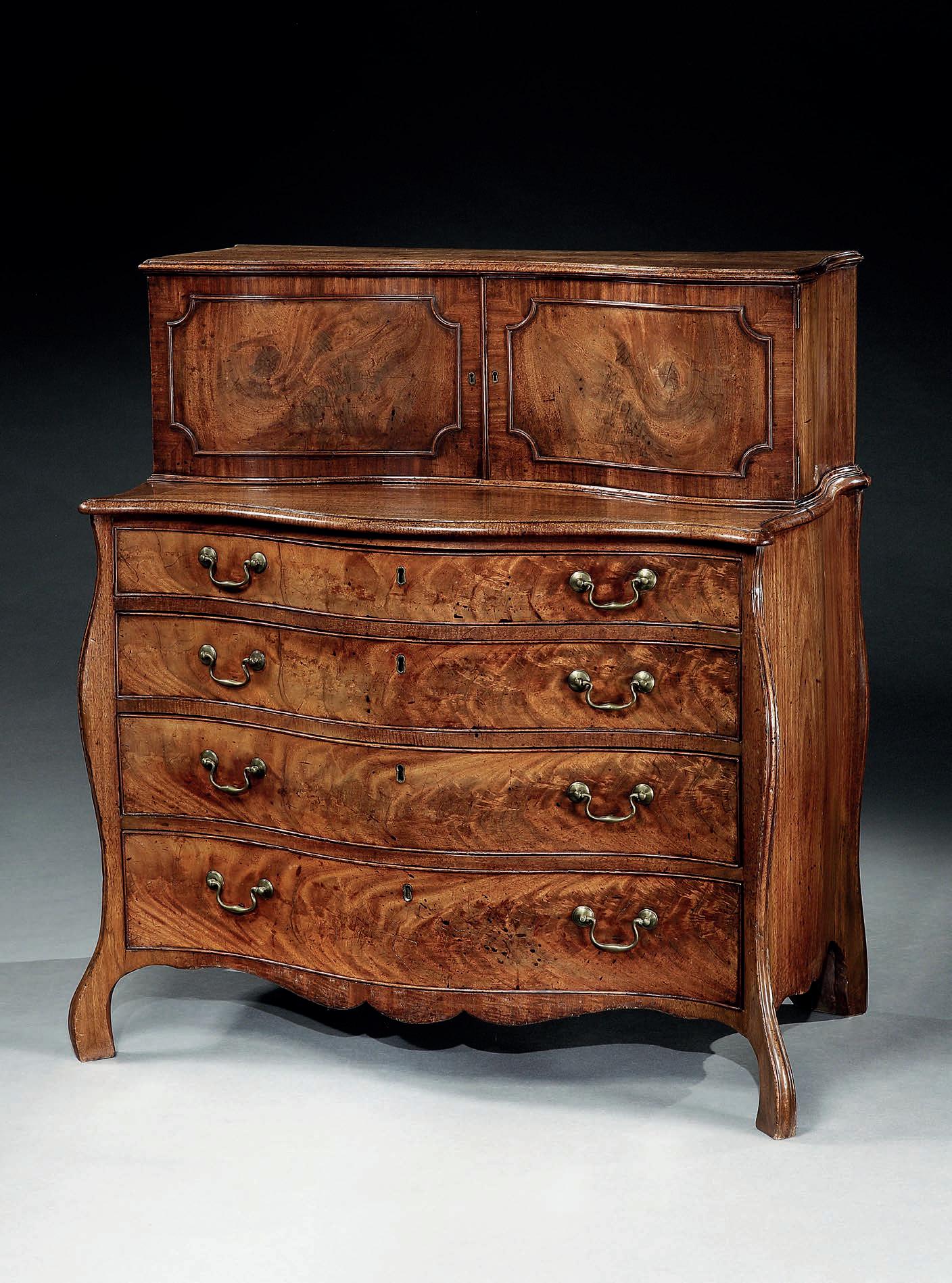
England, circa 1810
A fine George III burr maple writing table. The rectangular rosewood banded top with a central green leather writing surface, bordered by a pair of raised surfaces which open to reveal a mahogany lined compartment to one side and a pen tray to the other. The frieze banded in rosewood to all sides and the front with a central drawer. The whole supported on rosewood banded end supports including turned spindles, curved legs and bras castors - all joined by turned maple cross stretchers.
A wonderful quality piece of furniture.
Height: 29¼ in (74 cm)
Width: 34¼ in (87 cm)
Depth: 20¾ in (53 cm)
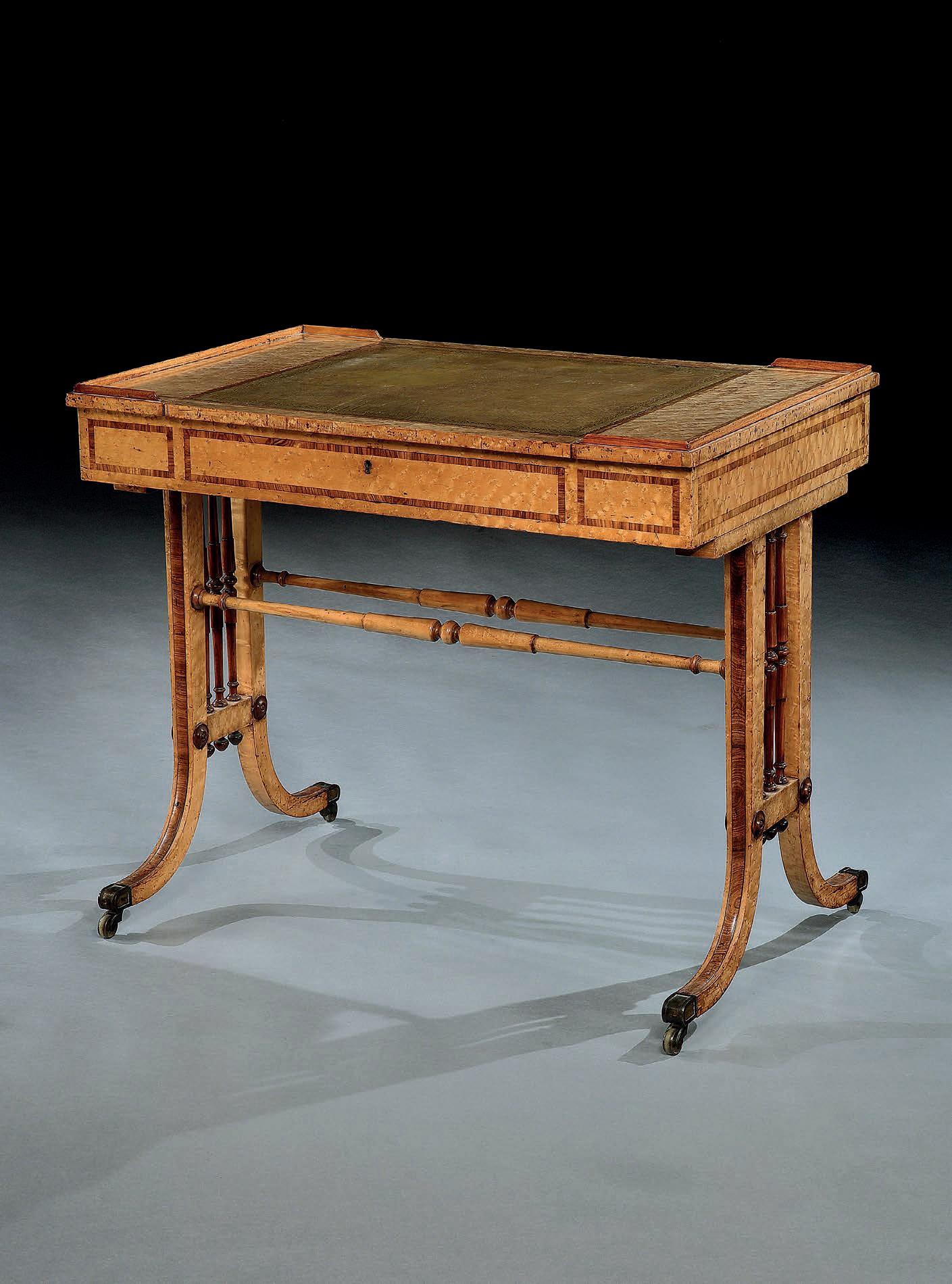

England, circa 1780
An exceptionally rare, if not unique, George III architectural mahogany and bone inlaid cellarette, of the most magnificent quality. With wonderful original colour and patina throughout, the rectangular stepped raised hinged top inlaid with bone in intricate panels, opening to reveal storage for 24 wine bottles. The front inlaid with bone swags and roundels, the corners with brick-like rusticated quoins, with a fluted lower edge. All supported on square section tapered legs also with rusticated quoins standing on brass capped castors.
Height: 31¾ in (81 cm)
Width: 28¼ in (72 cm)
Depth: 18¾ in (48 cm)

We offer a comprehensive service around all aspects of your collection of fine antique furniture. We are particularly well placed in the market to offer advice on matters including sourcing, de-acquisitioning, cataloguing, shipping, restoration, and conservation, as well as interior consultation.

We are often asked to source specific pieces on behalf of our clients. Whether this is at auction, or from our extensive access to private collections not readily available on the market, we are ideally placed to facilitate these requirements.
An 18th century Chinese Export lacquer bureau on stand sourced for a client.

We provide a comprehensive restoration and conservation service. Our extensive contacts with a wide range of highly skilled and specialist restorers both in the UK and the USA allow us to carry out restoration on behalf of our clients to meet their specific needs, including polishing and waxing, japanning and lacquer work, gilding, decorative painting, framing, and upholstery. Please contact us for a quote.
Detail of the George II walnut shepherds crook armchair.
Copyright All rights reserved. No part of this publication may be reproduced, stored in any retrieval system or transmitted in any form or by any means electronic, mechanical, photocopying, recording or otherwise, without the prior permission of the publishers.
Terms and Conditions All business transactions are subject to our standard terms and conditions of sale, copies of which are available upon request.
Trading as Mackinnon Fine Art Consultancy Limited, Registered in England & Wales, No. 5747760.
